the PEOPLE issue
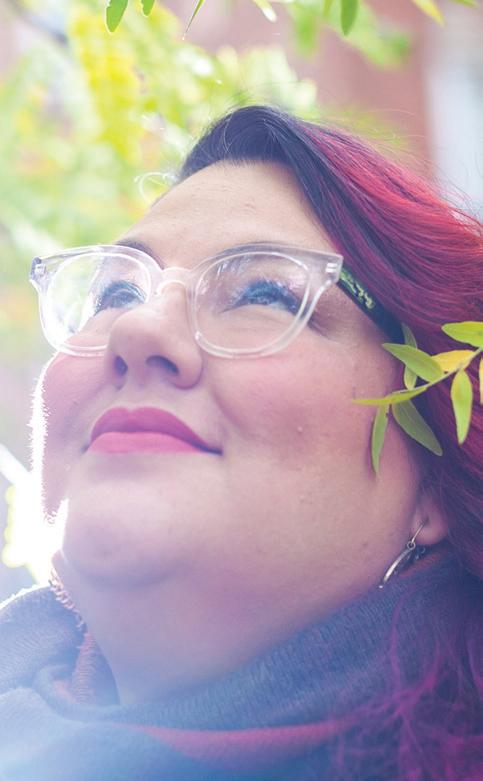



FREE AND FREAKY SINCE 1971 | NOVEMBER 10, 2022
16 The Punk Musician Jill Lloyd Flanagan embodies radical ideas and aesthetics.
CITY LIFE
04 Street View It’s “love it or leave it” for this stylish Hyde Park dweller.
06 Shop Local Amy Taylor and the fascinating world of natural dyes
THE PEOPLE ISSUE
07 Intro Refreshed and revisited, the class of 2022 showcases folks from many walks of life.
08 The Movement Builder Richard Wallace builds, empowers, and grows with Equity and Transformation (EAT).
18
The Cheesemonger Alicia Norris Jones designs cheese boards and makes cheese accessible to all.
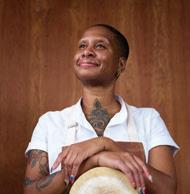
22 The Protector Tamar Manasseh founded Mothers and Men Against Senseless Killings (MASK) and We Are Jane.
26 The Goddess of WOW Lynne Rousseau McDaniel deals in historic furniture and fine art.
30 The Avant-Garde Cellist Lia Kohl makes solo work that combines cello with synthesizers, field recordings, and radio broadcasts.
44 The Curator Malia HainesStewart creates spaces for people to discuss movies and books.
46 The Tailor Julia Needleman has sewn wedding dresses for generations of brides.
48 The Auteur Tony Trimm makes a “psychotronic cooking show” on YouTube.
52 The Champion Karla Estela Rivera is a writer-educator-activistpodcaster and the first executive director of Arts Administrators of Color.
CHICAGO READER | NOVEMBER 10, 2022 | VOLUME 52, NUMBER 3
Harvest Film Festival.
64 Movies of Note A ersun is a mesmerizing debut about childhood memories, Armageddon Time wastes a standout performance by Jeremy Strong, and Causeway is 90 minutes of humorless naturalism.
MUSIC & NIGHTLIFE
66 Chicagoans of Note Michael Cameron, co-owner of Uncommon Ground 70 Shows and Records of Note
TO CONTACT ANY READER EMPLOYEE, EMAIL: (FIRST INITIAL)(LAST NAME) @CHICAGOREADER.COM
PUBLISHER AND PRESIDENT TRACY BAIM EDITOR IN CHIEF ENRIQUE LIMÓN
MANAGING EDITOR SALEM COLLO-JULIN
PRODUCTION MANAGER KIRK WILLIAMSON
SENIOR GRAPHIC DESIGNER AMBER HUFF
STORY EDITOR SUJAY KUMAR
NEWS EDITOR JIM DALEY
THEATER AND DANCE EDITOR KERRY REID
MUSIC EDITOR PHILIP MONTORO
CULTURE EDITOR: FILM, MEDIA, FOOD & DRINK TARYN ALLEN
CULTURE EDITOR: ART, ARCHITECTURE, BOOKS, LITERARY ARTS KERRY CARDOZA

ASSOCIATE EDITOR AND BRANDED
CONTENT SPECIALIST JAMIE LUDWIG
SENIOR WRITERS LEOR GALIL, DEANNA ISAACS, BEN JORAVSKY, MIKE SULA STAFF WRITERS DEBBIE-MARIE BROWN, KELLY GARCIA, KATIE PROUT
LISTINGS COORDINATOR MICCO CAPORALE
VICE PRESIDENT OF OPERATIONS ANN SCHOLHAMER
DIRECTOR OF DIGITAL JOHN DUNLEVY
DIRECTOR OF MARKETING VIVIAN GONZALEZ MARKETING PROJECT STRATEGIST SHAWNEE DAY NEWSLETTER ASSOCIATE CHASITY COOPER
10 The Diversity Advocate
Asafonie Obed leads the charge against a MAGA insurgency in DuPage County’s public schools.
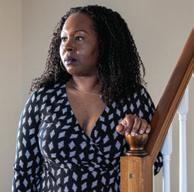
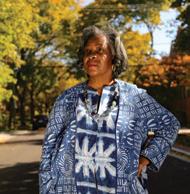
12 The Dance-Music Matriarch Natalie Hill spun funk and R&B in the 70s and influenced two generations of house producers.
32 The Touring Musician Izzy Reidy leads the band Izzy True and plays bass in Tenci.
34 The Socialist Vicko Alvarez is running for15th Ward alderperson.
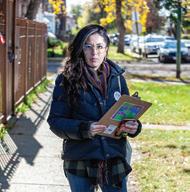
36 The Intergalactic Funk DJ Zeetus Lapetus hosts Fortune, one of the hottest queer dance parties.
38 The Comics Artist Caroline Cash wants to read more comics and draw more comics and meet people making comics.
40 The Voice Mario Smith hosts Lumpen Radio’s News From the Service Entrance
54 The Kink Performer Wildcat Shadow leads you to your darkest desires as a rubber-clad feline.
56 The Icon Remembering trans legend “Mama” Gloria Allen
ARTS & CULTURE

58 Visual Arts A solo show from artist Anna Martine Whitehead at Roman Susan
THEATER
60 Plays of Note Porchlight’s revival of Rent is both nostalgic and urgently contemporary, Babes With Blades’s Plaid as Hell subverts serial-killer tropes, and The TwentySided Tavern offers a theatrical twist on role-playing games.
Previews of concerts including Tenci, Danielle Ponder, and Nour Mobarak, plus reviews of releases by Ben LaMar Gay, Smino, Sweet Cobra, and more 74 Early Warnings New concerts and other updated listings
Gossip Wolf Divino Niño and artist Roland Santana host a three-day extravaganza of music and painting, Folie and Forget Basement fuse hyperpop and darkwave on their debut as WhoTF, and Late Nite Laundry stand out from the indie-rock pack with a breezy new EP.
OPINION
DIRECTORS OF CHICAGO INDEPENDENT MEDIA ALLIANCE (CIMA) SAVANNAH HUGUELEY, YAZMIN DOMINGUEZ
EXECUTIVE ASSISTANT SANDRA L. KLEIN
SENIOR VICE PRESIDENT OF GROWTH AND STRATEGY AMBER NETTLES VICE PRESIDENT OF SALES AMY MATHENY SALES TEAM VANESSA FLEMING, TIM OGDEN, TED PIEKARZ, WILL ROGERS DIGITAL SALES ASSOCIATE AYANA ROLLING
ADVERTISING
312-392-2970, ADS@CHICAGOREADER.COM CLASSIFIEDS: CLASSIFIED-ADS@CHICAGOREADER.COM
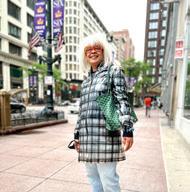
NATIONAL ADVERTISING VOICE MEDIA GROUP 1-888-278-9866 VMGADVERTISING.COM JOE LARKIN AND SUE BELAIR
DISTRIBUTION CONCERNS distributionissues@chicagoreader.com 312-392-2970
READER INSTITUTE FOR COMMUNITY JOURNALISM, INC.
CHAIRPERSON EILEEN RHODES TREASURER REESE MARCUSSON SECRETARY KIM L. HUNT DIRECTORS ALISON CUDDY, DANIEL DEVER, MATT DOUBLEDAY, VANESSA FERNANDEZ, TORRENCE GARDNER, ROBERT REITER, CHRISTINA CRAWFORD STEED
14 The West-Sider Denise
Ferguson witnessed history while growing up in North Lawndale.
42 The Moviegoer Nick Obis goes to see movies, rates them on Letterboxd, and then repeats.
FILM
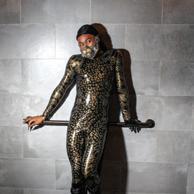
62 One of a Kind The Siskel Center hosts the 28th annual Black
READER (ISSN 1096-6919) IS PUBLISHED BIWEEKLY BY THE READER INSTITUTE FOR COMMUNITY JOURNALISM 2930 S. MICHIGAN, SUITE 102 CHICAGO, IL 60616 312-392-2934, CHICAGOREADER.COM
COPYRIGHT © 2022 CHICAGO READER PERIODICAL POSTAGE PAID AT CHICAGO, IL
ALL RIGHTS RESERVED. CHICAGO READER, READER, AND REVERSED R: REGISTERED TRADEMARKS ®
2 CHICAGO READER - NOVEMBER 10, 2022 ll
74
75 Savage Love Dan Savage offers advice to someone whose friend gives earth-shattering blow jobs. CLASSIFIEDS 76 Jobs 76 Professionals & Services THIS WEEK
ON THE COVER (LEFT TO RIGHT): PHOTOS BY MATTHEW GILSON, EDDIE QUIÑONES, AND CAROLINA SANCHEZ.
IN THIS ISSUE
Museum of contemporary art presents







NOEMBER 10, 2022 - CHICAGO READER 3
Wednesday, November 30, 2022 VIP RECEPTION 6:00 - 7:00 PM + GENERAL 7:00 - 11:30 PM Museum of Contemporary art 220 e. chicago ave. Chicago, IL FOR MORE INFORMATION + TICKETS SCAN THE QR CODE OR VISIT chicagoreader.com/50ish SUPPORTING SPONSORS CFL Workforce and Community Initiative The Darrell R. Windle Charitable Fund and Polo Inn Miriam U. Hoover Foundation Quarterfold LLC Pritzker Pucker Family Foundation The John D. and Catherine T. MacArthur Foundation
Street View Sparking joy
It’s either love it or leave it for this stylish Hyde Park dweller.
By ISA GIALLORENZO
“Iguess I’m an eclectic dresser,” says Mary Gri n, 72, who currently works part-time at Essential Elements-Chicago boutique in Avalon Park. “Everything about me is eclectic. My home is eclectic. There’s not a pair of anything in my house—nothing matches. My friends enjoy coming over to my house because they say it’s like going to a small museum. Everywhere they look, they see something different,” adds Griffin. She says she takes inspiration from magazines, art, nature, and life itself. “I love nature. Being outside and looking at the trees, the grass, and life in general. You see, life is supposed to be eclectic. We’re supposed to see beauty in everything. Even in something ugly or trashy.”

Gri n has had a “passion for fashion” since her early years when her very chic mother decided to let her wear whatever she wanted. “Even if it was something crazy looking, she would just let me go on and wear it because I seemed to be very happy wearing it. Fashion, to me, is wearable art. So I might have something very trendy on, or I might wear something designer, or some people would say I might look like I’m in the circus. It just depends on my mood that day, how I feel when I wake up. I don’t think there’s a rule [people] should go by. I think they should wear what they want, what makes them happy and comfortable. Because if I am not dressed to my taste, that would throw my whole day off. I can’t wait to get back home,” she admits.
Her friends should consider themselves lucky since Griffin makes sure to give away every item that doesn’t bring her joy. The Burberry raincoat she was photographed in had already found a new owner by the time she was interviewed for this article. “If it’s
something that I bought that’s very expensive, I have a couple of girlfriends that are my size. I’ll call one of them and they will say, ‘Mary, you’re giving that away? You’re crazy!’ I like blessing people with things that I have if I know that they’ll like them. And I do have a rule: whatever new item I bring into my house, something old has to go out. So if I bring a new sweater in, I have to get rid of an old sweater. That way my place doesn’t become cluttered,” she says.
The day Griffin was photographed, she was running a few errands downtown while sneaking in a little shopping trip. She enjoys shopping in stores from all price points—including thrift stores, which she loves. “You can fi nd some wonderful things at the thrift stores. You just have to have an eye. It’s almost like it’s something that can’t be taught. It’s a gift,” Griffin says. Speaking of a good eye, she found her fabulous, orange frames in the reader glasses section at a shoe store (she later added prescription lenses). Along with the eyewear, her beautiful snow-white hair à la Rei Kawakubo made her stand out.
“I started turning gray in my 20s. I used to go through the whole chore of washing, blow drying, and fl at ironing,” Gri n remembers. “Then I just said, ‘No, I’m not gonna do that anymore.’ I’m at an age where I can do whatever I want, and it’s gonna be OK because I’ve earned it. I went to college, I had a great job [at the auction house Sotheby’s], I’m retired. I feel free. I’m living my best life at 72 because I feel like I have no restrictions. Now I can just live life to the fullest.” v
@chicagolooks
4 CHICAGO READER - NOVEMBER 10, 2022 ll
CITY LIFE
Mary Griffi n during an errand run downtown ISA GIALLORENZO
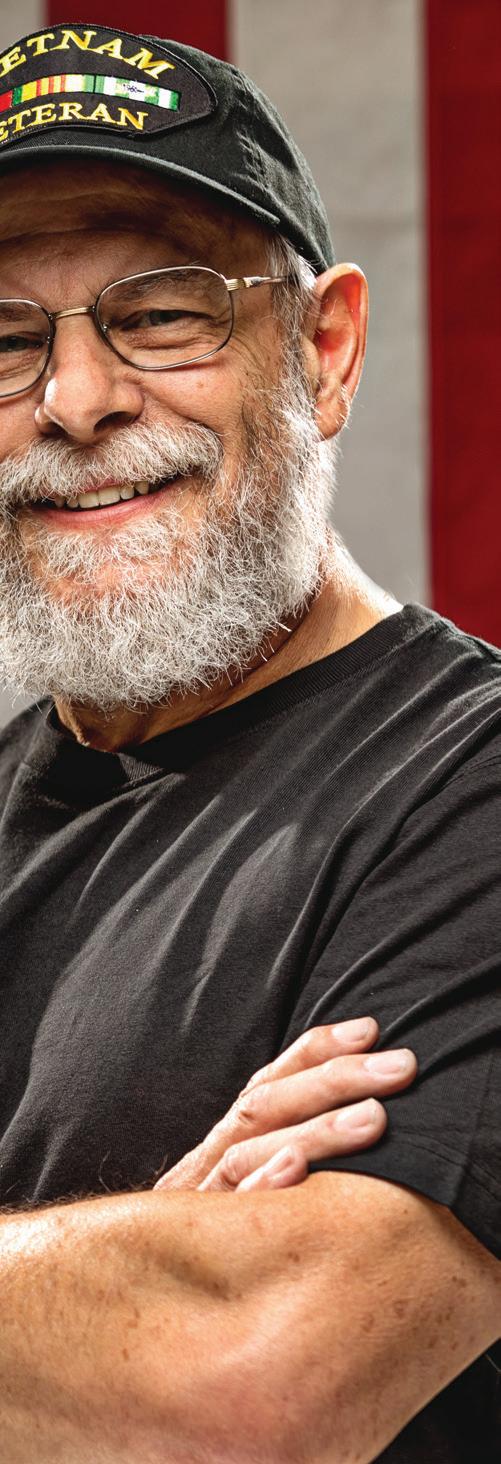




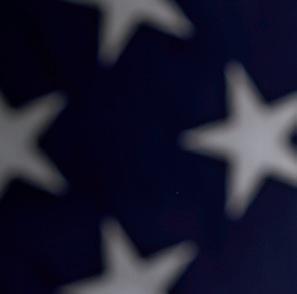



















NOVEMBER 10, 2022 - CHICAGO READER 5 WITH PURPOSE ® PLAY Learn how every play helps at www.IllinoisLottery.com
Shop Local
To
dye for Amy Taylor and the fascinating world of natural dyes
 By ISA GIALLORENZO
By ISA GIALLORENZO
“N
at ural” is a word that might evoke wholesome feelings, but also blandness. Just think of a kid’s reaction when they hear they’re getting fruit for dessert. The same rationale is often applied toward natural dyes—that they are good for you and the environment, but a bore to the eye. According to fashion designer, natural dyer, and educator Amy Taylor, 35, nothing could be further from the truth. “It’s a really common misconception that natural dyes can only yield pale colors. They can yield pale colors if you want them to. But if you think about all of the [brightly colored] garments and dresses in your favorite Renaissance paintings, they all came from natural pigments,” she says. Taylor explains that synthetic dyes were only discovered in 1856, and that prior to that natural dyes were the only way to dye fabric. Would anyone daresay that a glam rococo queen like Marie Antoinette would settle for dull, hippy-dippy textiles?
Currently a designer-in-residence at the Chicago Fashion Incubator, Taylor stumbled upon natural dyes almost by chance, and never looked back. She now owns a brand called Ms. Amy Taylor, dedicated to selling natural dye kits and naturally dyed garments. The natural dye kits cost $54.99 each and include five di erent dyes, a scarf made with 100 percent silk, and all the materials and instructions needed to dye the scarf. Taylor also sells “wedgie-free” briefs ($45), other hand-dyed garments, and naturally dyed hair scrunchies ($8).
In addition to running her online shop, Taylor also teaches courses about natural dyes. “Education is a huge part of my platform, and I love teaching people of all ages and experiences,” she says. Taylor’s love for the subject makes her uniquely suited for the task. While talking about natural dyes in an approachable and captivating manner, she touches on the chemistry, history, technique, and philosophy involved in the process. Things can even get metaphysical, such as when Taylor mentions
indigo dye baths. “Indigo baths are living baths. And if you take care of them and feed them, they can last years and years. I once asked my mentor, Akemi Cohn, for the recipe for her indigo baths—the most beautiful I’ve ever worked with. I wanted to know why my indigo baths didn’t come out as good as hers. And she said that she talks to her baths. And it’s true! It’s like talking to plants. You have to thank your indigo bath, you have to talk to it. You have to treat it like the living thing that it is,” Taylor says.

An enthusiast of wabi-sabi, the Japanese aesthetic that promotes the acceptance of transience and imperfection, Taylor is all about the one-of-a-kind quality present in natural dyeing. “Looking at these pieces that we make, there are always sections that one could argue are blemishes or defects. But what I really like to tell my students is that we have the technology now that if we want a piece that’s free of all imperfections, it’s cheaper, faster, and easier for a machine to do it. One of the really nice things about doing it by hand is putting your thumbprint on it,” she says. Though Taylor’s work is highly connected to humane and environmentally-conscious practices, she’s not an eco snob. “I would say about only 50 percent of my closet is handmade or hand-altered in some way. I think it’s not so much about excluding store-bought clothes, but about changing our psychology and thinking about our clothes more permanently and in less disposable ways. For example, one of my favorite jackets is from Forever 21. I bought it in 2015, and it still looks brand-new just from taking care of it,” she explains.
Taylor also suggests a homemade dye bath to give new life to items such as an old white T-shirt made with natural fibers (synthetic fibers won’t absorb natural dyes). “It’s all about buying garments with the intention of wearing them until they’re unwearable, and then mending and fixing them whenever we can,” she says. Taylor wisely asks, “Has shame ever changed people’s minds about anything?” v
6 CHICAGO READER - NOVEMBER 10, 2022 ll CITY LIFE
@chicagolooks
Amy Taylor holds a freshly hand-dyed fabric. She used a shibori technique in the dying. ISA GIALLORENZO
Taylor’s natural dye kits come with instructions, a silk scarf, and twine. COURTESY AMY TAYLOR
MS. AMY TAYLOR NATURAL DYE KITS, GARMENTS, AND INSTRUCTION msamytaylor.com
the PEOPLE issue




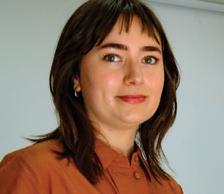
When people think of the Reader, a few things might come to mind: dogged journalism, meaty features and critiques that spark conversations, and a unique history that, much like Chicago itself, is rooted in tenacity and resilience.
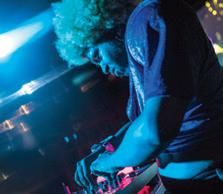
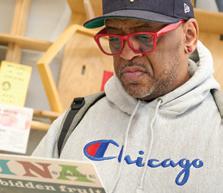
Through changes in the media landscape (and ownership), the Reader has survived and, as was established in its first anniversary issue back in 1972, has continued to build on the foundation that “we find street sellers more interesting than politicians, and musicians more interesting than the Cubs. They are closer to home.”
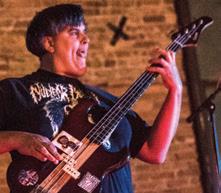
Fast-forward a few decades, and the sentiment still rings true.

When I think of the Reader, one of the first things that pops into my mind is the People Issue. Launched in 2011 as a love letter to singular, under-the-radar Chicagoans, the special issue caused a ripple e ect felt across the alt-weekly industry. With its innovative approach and format-busting online presentation, it picked up a few national awards early on, and signaled a new beginning as to how alternative publications could approach and present real, impactful stories. Stories that in that first iteration included Dr. Titus Chiu, a skateboarder turned healer who believed “love is the most powerful medicine there is,” and Kimberly Wasserman, a Little Village environmental justice advocate who after being featured went on to shut down two of the country’s oldest and dirtiest coal plants and transformed them into cherished community spaces.
A string of changes in Reader structure and leadership followed, and the People Issue was set on pause after its 2016 incarnation, leaving many—myself included—hungry for a comeback.

Refreshed and revisited, the People Issue’s class of 2022 showcases folks from many walks of life and includes a self-described “little, queer, Indigenous child of God” who grew up to be a force in underground space-funk parties, a former Maxwell Street vendor who developed into a vintage wares and estate sale powerhouse, and a workplace stress educator by day/kink performer by night who has quickly become the rubber-clad darling of the local puppy play scene.
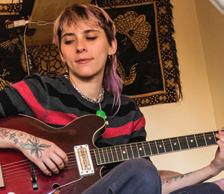
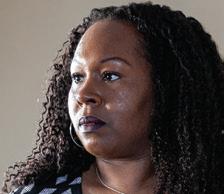

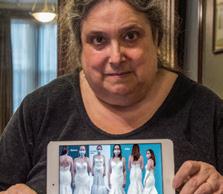

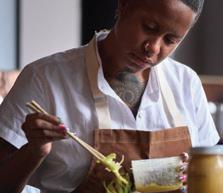
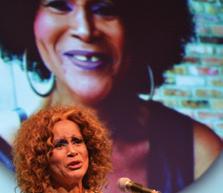


As subjects, their common thread is an incessant need to create welcoming spaces for other individuals like them, enact change, further their craft, do good, and in one instance, amplify the representation of stoner lesbians in graphic novels.
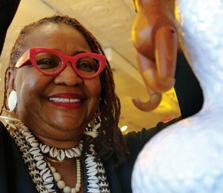
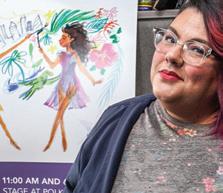

In a People Issue first, there’s also a posthumous entry honoring the memory of the one and only “Mama” Gloria Allen who passed away earlier this year, leaving a legacy that impacted many, and that should be celebrated in perpetuity.
On the topic of standout people, I’d be remiss not to mention the dedicated sta who put this oh-so-very-special issue together. Your talent and energy is also embedded in the fiber of what makes Chicago a prime place to thrive in.
Curious to find out what item currently sitting in your fridge is considered “a picture of culture” by some? Read on. v
NOVEMBER 10, 2022 - CHICAGO READER 7
—Enrique Limón, editor in chief
@EnriqueLimon
Richard Wallace
the PEOPLE issue
 Interview by MATT HARVEY
Photos by Eddie Quiñones
Interview by MATT HARVEY
Photos by Eddie Quiñones
How do we get free? Richard Wallace tackled that question in 2007, when he joined activist rap group BBU (he called himself “Epic”), and he’s still engaged with it today. That question has been the driving force behind every rally, every riot, every teach-in, sit-in, die-in, peace march, and community forum for decades now, and Wallace is building a movement that asks it with fresh urgency. Wallace’s nonprofit, housed at the Westside Justice Center, is called Equity and Transformation (EAT), and the name itself offers one answer to the question—a question Wallace has been led to again and again by his own interactions with the carceral state and his mama’s lessons. “None of us are free until all of us are free,” as she taught him. How do we get free? Step one:
Bring everybody together. Step two: Everybody gotta EAT.
Reverend Doris Green, my mom, started a prison ministry in the 80s. Dixon, Menard, Stateville—I would go into those prisons at five, six, seven years old. She instilled in me that we are as free as the least of us. We literally have to all get free. For her that meant that we had to go back behind the prison walls and get the people we left behind. I think that really is where I began my organizing journey. This was my foundation of knowledge for EAT.
I was at the Workers Center for Racial Justice and a few other places over the years. One

8 CHICAGO READER - NOVEMBER 10, 2022 ll EDDIE QUIÑONES FOR CHICAGO READER
T h e m o v e m e n t b u i l d
r
e
of the shorties that I’d been working with was previously incarcerated, and we were trying to get him lined up for work. He found part-time work at a sta ng agency. When he got to 90 days, they let him go. He ended up being right back in the streets. When I saw him, I asked, “What’s going on with you, man?” He looked me dead in the eye and said, “Man, I just gotta eat.”
That hit me so hard, because at its core, that’s why he was engaged in what you would call illicit or illegal activity. He had children. His partner had fallen ill. He was up against the wall trying to figure out how he can keep food in his children’s bellies and keep the house over their heads.
It’s the simplest expression of need: “I gotta eat.” At the time, we were talking about equity a lot in the national dialogue. If equity is what we’re fighting for, transformation is what has to happen. I’ve watched a lot of people that I worked with transform from their “get rich or die trying” perspective of the world into thinking about centering community. I was transformed through the work myself.
When my three siblings and I were shorties, my mom got a Section 8 voucher. She moved us out to the burbs, Downers Grove. So I was like the ink drop in a glass of milk. While I was going through that, she had me reading The Souls of Black Folk by W.E.B. DuBois. She instilled in me the need to be in service to people and community—but I think, being othered by the community, I began to mask-wear. DuBois talks about it—the double consciousness of seeing myself through the eyes of the people I was around.
The people I was around, mostly white folks, deemed me as criminal before I even got involved in the streets. It’d be parties where everybody’s running from the police, right, and I’m the only Black kid there and they’re like, “Richard Wallace, stop!” I slowly began to lean into that thug-life mentality. I ended up catching a robbery charge. I went in when I was 15 years old; I came out at 18.
For my mom, there had to be a letting-go moment. When I went in, she cried. I cried. It was a lot for my mom to see that, but she never left my side. She flooded me with books, poetry. She wasn’t going to let my development stop because I was incarcerated.
That’s my commitment to the people now. A lot of people walk away from people before the change happens. “We gave you the tools, so change right now.” But that’s not how people change. You got to be slow and consistent.
It’s on me and folks like me to begin to build the tools. Like, how do we get Eric Garner and Rekia Boyd and Alton Sterling and dozens of others into movement before they die? Their lives, which we revolted over, are often spent in economic conditions that we didn’t
focus on. If you’re in survival mode, you don’t really got time, necessarily, to go to no damn teach-in.
I think if you ain’t been there, you can’t tell nobody how to get free from it. I’m able to connect with these younger guys that’s getting into the streets. They see themselves in me. “So you was in IYC St. Charles [a juvenile detention facility]?” And I’ll say, yeah, man. “And you’re doing this right now?” Yeah, and let me tell you what else I did. Sometimes they’ll think, “Oh wow, well, I think I could do it too,” just because I did it.
I also then explain that it wasn’t easy to transform from that bad lifestyle to this. It took real discipline. It took a commitment to learning and unlearning and taking, like, a step back from the day-to-day, seeing the full picture. Asking myself, Why? Why were so many of the youth inside of IYC St. Charles the same color as me? What were the connecting lines? Most of us in there had a host of financial challenges, didn’t have attorneys or people who showed up to pay our bills, to pay our fees and fines.
Once you see it as a societal issue, you’re open to the idea that we can change this. When it’s just me against the world, it’s really hard to change things. When you realize there’s massive movements around the world aimed at changing what you experienced, the load gets lighter.
It wasn’t until I graduated from Roosevelt University at 30 years old that the Richard Wallace you see now was introduced to the world. In 2014, when Mike Brown was killed, I ended up going down to Ferguson to protest. One night, we’re fleeing across a field. On my
left is my professor Inhe Choi, and on my right is Dr. Cornel West. We ended up taking over this university campus. It’s me, West, Choi, and people from all over the world. I thought, “Oh, this is what community organizing is.”
I landed a cushy job doing inclusive procurement work—basically, negotiating contracts coming out of the city’s spending and creating community benefits on the opposite end. I was wearing a suit and tie, going downtown. And I just felt empty. I felt like, “I know that I didn’t go through everything I went through to be putting on a suit and code-switching every day.” That can weigh on you.
We did some good work. We brought railcar development back to Chicago for the first time since the Pullman porters. There’s an actual railcar development facility in the Pullman community—about 300 or so jobs.
But I still felt like we were missing the mark.
The folks who needed to be in these jobs the most weren’t eligible—people with records, things like that. In national movement spaces, there was this similar challenge of getting formerly incarcerated folks, folks in the streets, into movement space. I was like, “How about I build it?”

In 2018 I got a fellowship through Atlantic Fellows for Racial Equity, and I was excited— but my job was like, “You can’t do both.” So I chose the fellowship. They ended up cutting the check, $7,500, so that I could start to build Equity and Transformation.
We build, we empower, and we grow. We do cookouts, mutual aid, service, community cleanups. Whatever we do, we do with community. We talk about health, introducing our folks to healthier food options. Free yoga. We can get you free therapy.
We understand the economic condition. We built out this thing called the Chicago Future Fund, which is a guaranteed-income pilot project for formerly incarcerated people in West Garfield Park. Upwards of 70 percent of young African American men ages 18 to 35 in West Garfield Park are unemployed.
How do you create the space to engage deeper in the organizing work if you ain’t got no money? We believe that our folks will use that guaranteed income to free up time. And through that freeing up of time, they can engage deeper in local community activities and their own personal drives. Folks want to go back to college or whatever they want to do. We’re trying to build our vision of a world where people are fully free. v
NOVEMBER 10, 2022 - CHICAGO READER 9
@MattheMajor
“
If equity is what we’re fighting for, transformation is what has to happen.
—Richard Wallace
Richard Wallace gets his hair cut in the community barbershop at Coronation Creatives, a few blocks from Equity and Transformation’s headquarters in the Westside Justice Center.
EDDIE QUIÑONES FOR CHICAGO READER
Asafonie Obed
 by BEN JORAVSKY
by Eddie Quiñones
by BEN JORAVSKY
by Eddie Quiñones
By her own admission, Asafonie Obed might be the last person you’d expect to lead a charge against a MAGA insurgency in DuPage County’s public schools.

She’s not even from DuPage County—only moved there about a decade ago, when she was still in college.
Yet for about a year she’s been at the forefront of a showdown with MAGA school activist Shannon Adcock, a leader of Awake Illinois and Moms for Liberty—two organizations which, as far as I can tell, fervently believe in liberty for themselves and no one
else. Especially members of the LGBTQ+ community.
You might say Obed has been warning people about the MAGA movement for “parents’ rights”—or rights for the right parents—long before some of its ugly transphobic rhetoric became front-page news.
Obed is a south sider—a graduate of Kenwood High, class of 2004. She grew up in South Shore—“roughly 79th and Saginaw.”
She says she had no interest in politics or activism in high school. “I was into art, theater, and dancing. I loved to dance. I loved to go to dance parties—Mary J. Blige, Beyoncé, and Cardi B are my favorites.”
10 CHICAGO READER - NOVEMBER 10, 2022 ll EDDIE QUIÑONES FOR CHICAGO READER
T h e d
d
i v e r s i t y a
v o c a t e the PEOPLE issue
Interview
Photos
—Asafonie Obed
Her father, Justice Obed, is an immigrant from Ghana. “He came to this country with nothing and instilled in me some survival skills that never left me. He told me I was a ‘strong African queen’ and that I ‘walked in the light.’”
Her mother, Kim Obed, worked for the post office. “She’s from Chicago—born and raised on the south side. She taught me how to fight for myself. To articulate what it is I’m trying to say without getting emotional. That has helped me a lot.”
Obed spent a year at Dillard, a historically Black university in New Orleans. Then she transferred to Northern Illinois, graduating with a degree in sociology. “I came home and went to Northern because, quite frankly, it was less expensive.”

In the years after college, Obed began a career in IT. Got married. Had four children and moved to the suburbs for the same reason thousands of other Chicagoans made that move before her—schools. “I was looking for a top school district to raise my kids,” she says.
Obed and her husband (they have since divorced), moved to a neighborhood in Aurora that’s part of Indian Prairie School District 204 (which also serves Naperville, Bolingbrook, and Plainfield). “It’s a very diverse area—Black people, whites, Hispanics, Asian
Americans. Everyone is very welcoming. I always felt welcome—until the school board election.”
That would be the April 2021 election in the Indian Prairie district, where her children are enrolled. Adcock was one of several candidates in that race.
“From Adcock’s campaign material, I knew she didn’t support culturally responsive teaching in our district,” says Obed. “So I sent her an email. I wasn’t trying to change her mind. I really wanted to have a conversation with her—to hear her perspective and hear why she felt the way she said she felt. And, unfortunately, rather than have that conversation, she pretty much told me to go and build my own charter school for racebased curriculum and social justice, if that’s what I believe in.”
To Obed, Adcock’s response was patronizing and racist. “When I got that email, I had to read it a couple of times. I couldn’t believe a woman who wants to represent a district that supports diversity, equity, and inclusion would tell a Black woman to start her own school. Like—there’s no place for people like me in this school district?”
As Obed sees it, Adcock was essentially
telling her that people who believe in integration, diversity, and inclusion should be segregated in a separate school. As opposed to having these values embraced and fostered district wide.
“What I heard when she emailed me is that you and your children are not welcome in this district. I felt she didn’t want the history of African Americans to be talked about. Or celebrated. She didn’t want to acknowledge the injustices that African Americans have faced. And she didn’t want to address the current climate we were living in.”
This was less than a year after George Floyd’s murder. “At one point in our exchange, Shannon wrote, ‘I don’t see color,’” says Obed. “That’s highly offensive to me. Of course, you see color. Everyone sees color. We shouldn’t pretend these issues don’t exist. You know, if my son showed up at her house dating her daughter—you won’t see color then?”
After the email exchange with Adcock, Obed posted an online petition asking people to oppose Adcock’s school-board campaign. The petition went viral—got written up in local newspapers—drawing hundreds of comments, pro and con.
Some trolls chided Obed for being too “woke.” On the other hand, she drew a lot of support and Adcock lost the election. “I truly believe that if I had not said anything, Shannon would have gotten elected,” says Obed. That election was by no means the end of the story. Adcock went on to form Awake Illinois, which, among other things, badgers librarians to ban books they find offensive (generally, those with LGBTQ+ themes) and muzzle teachers from teaching the history of race for fear it might hurt the fragile feelings of white children. Also, they have a thing against school mask mandates—don’t get them started on that.
In July, Awake took its fight to private businesses, demanding UpRising Bakery & Cafe not hold a family-friendly drag show at its place in Lake in the Hills. The show was canceled after the bakery was vandalized. Like I said—liberty for them, not for others.
Adcock is once again running for the District 204 board—the election is in April. And Obed is urging voters to vote against her. “I believe in diversity and tolerance,” says Obed. “And I realize we have to fight for it.” v
NOVEMBER 10, 2022 - CHICAGO READER 11
@bennyjshow
“
“Of course, you see color. Everyone sees color. We shouldn’t pretend these issues don’t exist.
Asafonie Obed is leading the charge against a MAGA insurgency in DuPage County’s public schools. EDDIE QUIÑONES FOR CHICAGO READER
the PEOPLE issue Natalie Hill
Interview by LEOR GALIL
Photos by Carolina Sanchez
In the 1970s, teenage Natalie Hill began spinning funk and R&B on Chicago’s south side, taking her DJ name, Chocolate Star, from Bootsy Collins’s “Munchies for Your Love.” She served as secretary for a record pool called NDJA and rubbed shoulders with heavies in the local scene, including steppers specialist Sam Chatman and house producer Lil Louis. She stopped DJing in the 80s, but she’s become matriarch to two generations of Chicago house producers. Her youngest son, Beatdown House founder DJ Clent, became a force in the late-90s ghetto-house scene, and he’s since helped shape footwork; in 2017, he told the Quietus that his mom’s record collection had provided many of his samples. Clent himself has a teenage son, DJ Corey, who’s become one of the city’s most promising young footwork producers.
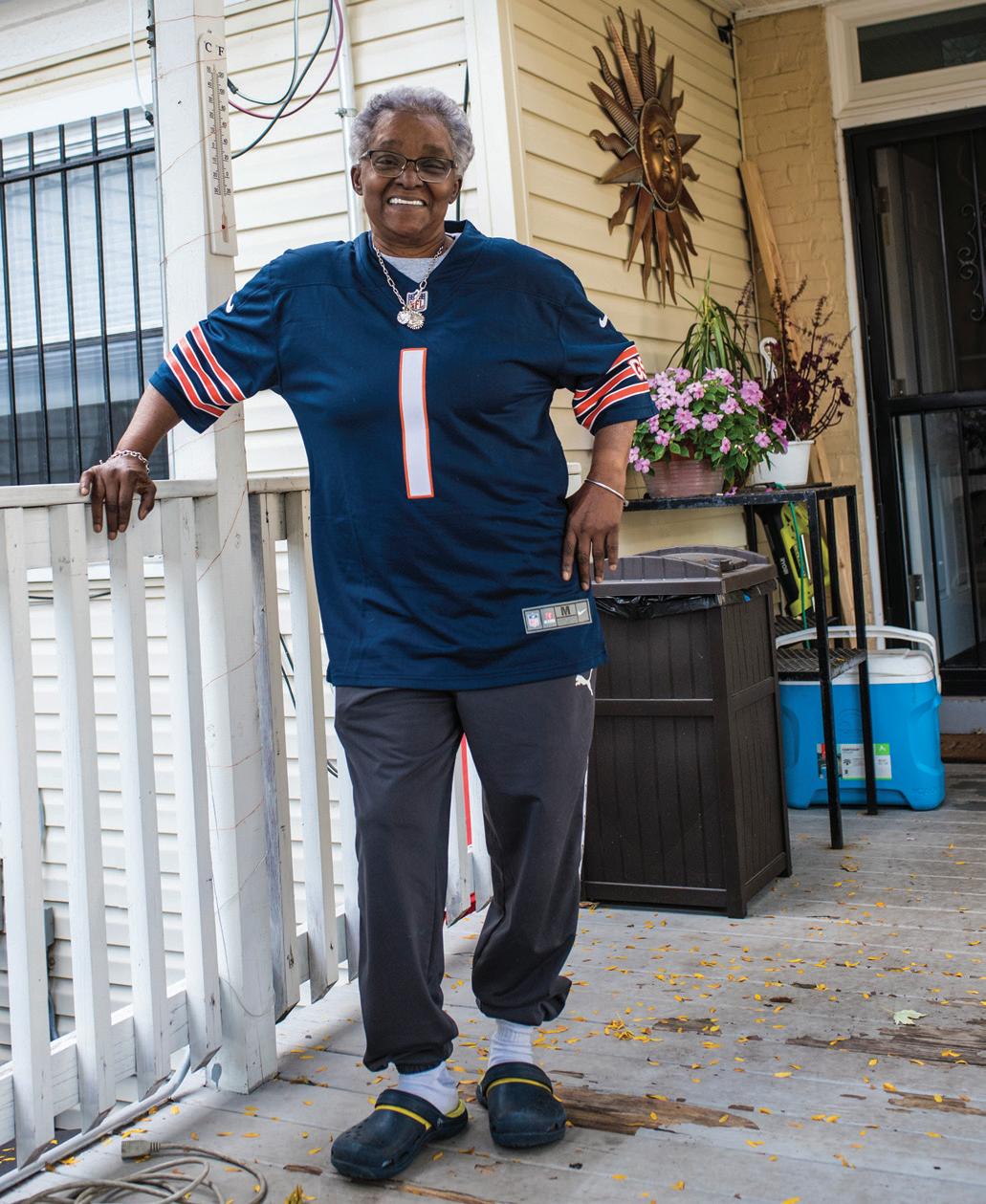
My cousin had a tavern on 45th and Cottage Grove. My mother used to help him out there—I was maybe 14, and I used to hang out there, but I wasn’t supposed to, being underage. My cousin told me, “Just stay in the DJ booth—stay out the way.”
There was a DJ named Lennon [Gardner]. I would watch him, and I couldn’t understand how he did what he did. And I asked him one day to show me—I was struck.
I would come in there early, mess around with the DJ equipment, and learn some of the
12 CHICAGO READER - NOVEMBER 10, 2022 ll T h e d
c e
u s i c m a t r i a r c h
a n
m
CAROLINA SANCHEZ
FOR CHICAGO READER
things that he taught me how to do, before the tavern was open. I messed around with the equipment until I could figure out what it was he was trying to teach me. He taught me how to blend, and how to play to a crowd, and how to form your music; he taught me the basics.
I may have been 16. My grandmother loaned me $500 to go to MusiCraft on Rush Street. They had a whole DJ section of speakers and mixers. I couldn’t believe the stu they had. That’s where I got my first taste of being a real DJ.
Lennon had told me about a record pool that was run by Don St. James—he used to have meetings every week, and I went there. They were astonished that I was a woman—also, I was so young. I ended up being the secretary of the record pool.
I couldn’t go much of anywhere because I was underage. So I couldn’t go to clubs or lounges, but I could go to Masonic halls and do parties, or I would go with Lennon and do wedding receptions. Then as I got older, I was able to go to age-appropriate places.
I don’t know if you remember ChicagoFest— this was before Taste of Chicago—but we actually did ChicagoFest. I think the big song back then was “I Just Want to Be” by Cameo. And I played that; I must’ve mixed it six, seven times. That’s when I was overwhelmed by everything. It was a big stage, lots of people—it was really something.
My youngest son, Clenton, I had him—and that’s when I pretty much gave it all up. I was a young mother, first of all, and I really didn’t need to be in the streets. I needed to be there for my children and take care of them. I wasn’t gonna try to saddle my mother with raising my children, and I needed to get some kind of structure within myself, ’cause all the while I was where I shouldn’t have been, you know? Just hanging out.
I had a closet in the front of the house, and that’s where I kept my equipment. My son Clent, DJ Clent now, used to go in there— sneak, turn on my equipment, and play with my equipment. He would leave things on, and I knew I had turned everything o . He was only three, four years old.
I used to find my doors o the hinges; he was always taking apart things and never put them back. He was fascinated with taking things apart and seeing how they worked. That’s when he started messing with the equipment. I wanted him to get an education. I wanted him to do something with himself. I wasn’t even concerned about DJing.
I never bought him equipment. I never helped him buy equipment. If he wanted to do it, he was gonna have to do it on his own. I did give him an allowance. He would save his money up, and he would buy whatever equipment he wanted.
He met a younger guy in the building next
to us who taught him what he needed to know—DJ Greedy. He wasn’t of age either, but I would make Greedy take him to skating rinks or wherever they were having parties, and he was responsible for Clent. I trusted him; he was a decent guy. Clent idolized him and Slugo and DJ Deeon.
I was never infatuated with any of the lifestyle—it didn’t amount to much to me, because I didn’t want him out in the street. I didn’t want him rippin’ and runnin’ around, or gangbangin’, or doing things he shouldn’t do. But I did know that if he was around those guys, I always knew where he was.
His dad had gone to DeVry, so he has a gift for electronics. He’d met a lot of guys who were trying to become DJs. They would buy their equipment and come to my house and bring it to Clent, so Clent could teach them how to use their own equipment. They sat right in that closet, hours on end. I’d come home from work and I’d pitch a fit, ’cause it was just guys all in the house. But they were all respectful. They were teenagers back then; they’re in their 40s now.
Corey is pretty much another story like Clent. He did it all by himself—he had no equipment that anybody gave him. One year, Clent bought him a controller for Christmas—matter of fact, I think there’s a video, and Corey was maybe four or five years old, and it was like his whole world lit up. His whole life, he patterned himself as Clent’s son. ’Cause Clent’s kinda bigheaded. Corey is too, now. Even when Corey was in kindergarten,
they had to call him “DJ Corey” at school. He wouldn’t answer to anything but “DJ Corey.”
I look at him and then I look at Clent, and I’m like, “Oh my God”—but I have to hand it to them. They took something that they honestly love, and it’s not to just try to make a buck— half the time they don’t get what they deserve out of it, but they love it so much. That’s what I like—the fact that they love it. It’s not like it’s work or trying to get a dollar. It’s something they genuinely love, so I respect them for that. I’m proud of both of them.
I don’t want any part of it. Clent, he wants to buy me equipment. I had a fire, years ago, and I lost all of my equipment. I lost about 5,000 records. Clent has spent his life trying to recoup what I had. But it’s OK. He buys me records all

the time, and one of his friends has bought me a turntable that I used to have, and he wants me to have another one; they’re trying to find me another mixer that I had. Material things are just that—they come and go. I’m still here. I don’t worry about that kind of stu .
I listen to music all the time, especially on Sundays. I sit on my deck—I’ve got a covered deck—and Clent decided he wanted me to have speakers on my deck. I’ve got a subwoofer up under the deck, and it sounds so good. That’s what gives me joy. I go out and I listen to my music—it’s just R&B, a little house, and slow jams, things like that. And it sounds so good. Plus the neighborhood likes it, because everybody’s around my age—that’s what they listen to. So we just go back on a fantastic voyage, if you want to call it that.
I see the art form that they’re doing. It’s gone all the way from Clent being two, three years old, and now Corey. You see little kids footworkin’; it goes further and further and further, and I’m so proud of all of them. It’s so many little DJs that I know, and now everybody calls me “Mama Hill.” I’m not too crazy about that. But I’ve known them pretty much most of their lives, and now they have kids—some of them have grandkids. And they tell me that a lot of times, going to the parties that Clent and all those other guys were at, it helped save their lives, and it kept them outta trouble and gave them places to go. I think that’s a good thing.
v
NOVEMBER 10, 2022 - CHICAGO READER 13
@imLeor
“
Even when Corey was in kindergarten, they had to call him ‘DJ Corey’ at school.
—Natalie Hill
Natalie Hill’s youngest son, DJ Clent, has been working with his friends to replace the records and audio gear she lost in a fi re several years ago. CAROLINA SANCHEZ FOR CHICAGO READER
the PEOPLE issue Denise Ferguson
Interview by KELLY GARCIA
Photos by Olivia Obineme
Denise Ferguson has lived most of her life in a two-flat across the street from Douglass Park. Through three generations of her family, she’s borne witness to the changes overcoming her front yard, an evolution that’s become increasingly personal. When three private music festivals threatened the sanctuary of her neighborhood, she was all but quiet.
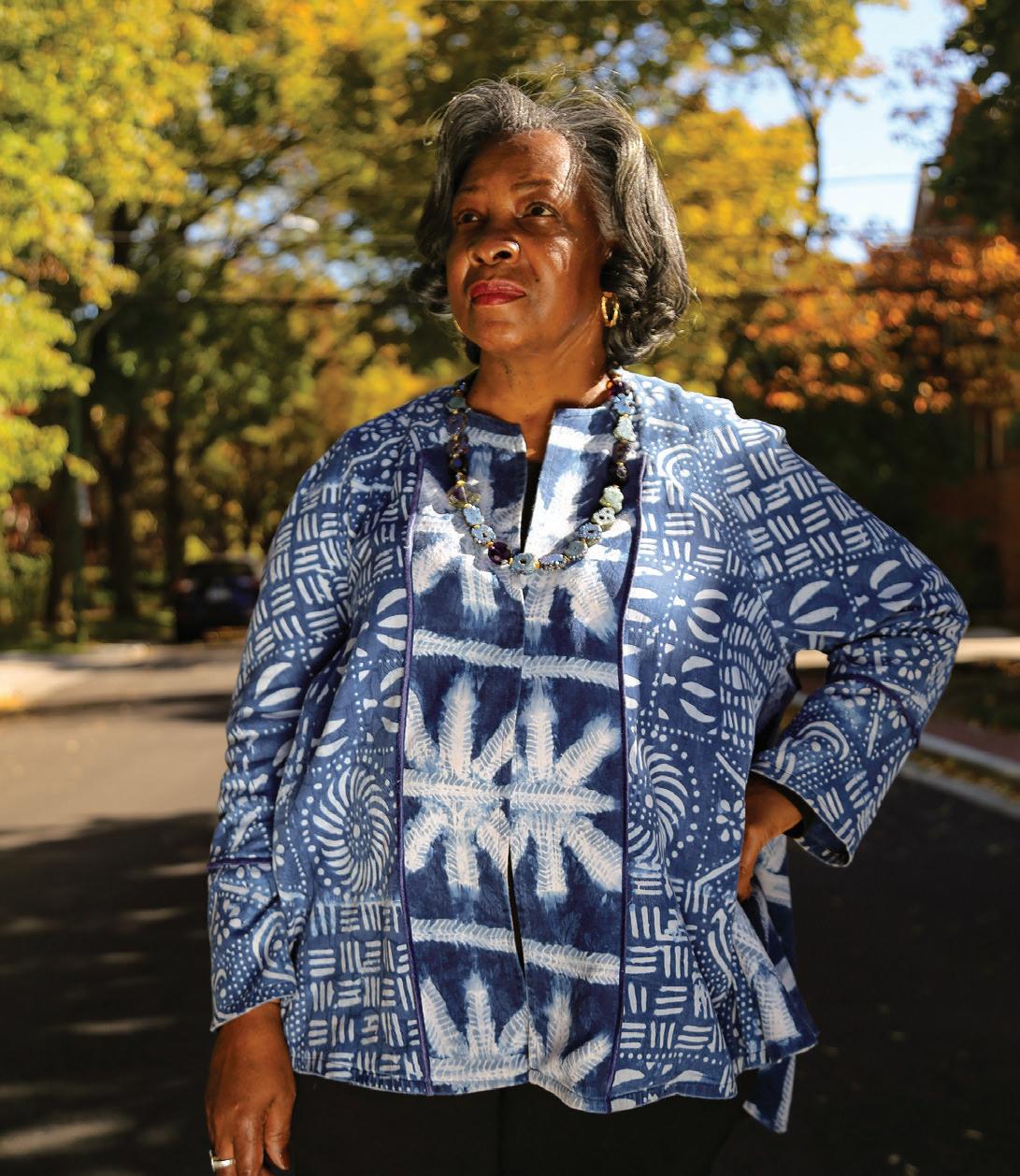
I met Denise at the park one summer afternoon when she showed up with a list of questions for an arrogant Riot Fest representative who had no answers: Will the playground be off-limits? Will the basketball court stay open? How about the tennis court? Will we know in advance about any closures?
I learned that she had been sending letters to the mayor and her alderperson for years about her concern that the music festivals violated the nearby quiet hospital zones—including zones for a Level 1 trauma center and a children’s hospital. She’s never heard back.
Over the months that followed, I learned a lot about Denise and the memories she has of Douglass Park, a centerpiece of the west side where families would gather on Sundays to watch baseball. But she also remembers a Douglass Park in which Black people were not allowed to walk through. Before Riot Fest there were the 1968 riots. She can still picture the west side burning as Mayor Richard J. Daley ordered police to “shoot to kill.”
Today Denise serves as a board member for Crossroads Fund and spends her time volunteering in the community. Before that, she
14 CHICAGO READER - NOVEMBER 10, 2022 ll OLIVIA OBINEME FOR CHICAGO READER
T h e w e s ts i d e r
had a career in the public sector—working in the Public Guardian’s office, Chicago Public Schools, and finally as a women’s director for the Commission on Human Relations, a job she was appointed to by Mayor Richard M. Daley. Since retiring in 2011, she’s continued serving the community that raised her and has also been traveling (she’s on a mission to visit all 50 states). Denise had plenty to say about the wonders of growing up in North Lawndale and also the moments that filled her with deep rage, like the murder of Fred Hampton. Those memories are still clear as day for her, so I’ll let her tell you about it.

During the Great Migration, my grandmother Daisy came to Chicago from Chester, South Carolina, following the music scene. She determined that Chicago was the best place for her in terms of employment, so she moved with four of her kids to the west side. In 1953, I was born in Mount Sinai.
The west side was bustling. We had watch shops, three grocery stores, and two movie theaters. There was a lot of live music and clubs. It was a beautiful place to be in.
The first time I saw Michael Jackson in the Jackson Five it was at the Central Park Theater (now it’s a church). They were practicing that day in a garage up Roosevelt Road. There was nothing about North Lawndale that didn’t make it exciting and wonderful to grow up, except for what I thought was a very punitive position against Black people on the part of the city.
I went to seven elementary schools and moved three times during high school, and all of this was because of poor housing in the city of Chicago. I used to tell people we were west-side gypsies. Dr. King moved to my neighborhood when I was 12 years old because of the poor housing. The conditions in which he found it in 1966 are the same as it is now. But what was beautiful about being on the west side for me was that all of my cousins and family were only walking distance. I watched my mom and her three sisters feed 15 kids with one chicken. Everybody had a piece of chicken breast, everybody could get whatever piece they wanted. I was never hungry. I saw not just my family, but lots of families cooperating with each other. When someone went to work, the lady next door watched all the kids. It’s the same thing that happens on my block today.
I remember staying home for the 1963 school boycott, because parents were protesting the conditions of schools. I never had a brand-new schoolbook until high school in 1971. We would get used schoolbooks from the north side of the city filled with profanities written by white students. But it wasn’t until
I was 16 that I became active in my community when I participated in a walkout at my high school to protest the murder of Black Panther members Fred Hampton and Mark Clark.
At six years old, I was hit by a car between Lexington and Central Park. I remember not being able to move. My mom rushed over with my neighbors. Someone called the ambulance, but the ambulance doesn’t come for Black people. Instead they sent a police wagon. The two police o cers got out of the car and struck my mother. They put us both in the back of the wagon and told us they were taking us to the Garfield Park Hospital, across the Eisenhower Expressway. The neighbors were worried, but as a six-year-old I didn’t know why. When they dropped us o at the hospital, my mother was crying because no one would attend us. It was a private hospital and they didn’t see Black people. My mom begged the nurse to call the police wagon to have them drop us o at Mount Sinai, one of the few hospitals that would see Black people on a regular basis. When I finally got to Sinai, the whole left side of my body was fractured.
I remember when the west side burned to the ground. The city deemed it a riot. It’s one of my biggest challenges with a festival named “Riot Fest.” I remember standing on my porch and seeing fire from every direction. The fire was not set by Black people. As looting occurred, Mayor Daley ordered a “shoot to kill.” Once everything had burned down, the city
said it wouldn’t rebuild it and it still hasn’t been rebuilt. From Kedzie to Pulaski, you’ll see so much blight in a neighborhood that used to be bustling.
After graduating college, I took a job at the Douglass library branch where I was tasked with increasing youth circulation of books. I went to the nearby high schools and promised
OLIVIA OBINEME FOR CHICAGO READER
to get them copies of whatever books they wanted. All I needed their students to do was get a library card. The school warned us that the students wouldn’t bring the books back, and I told them we didn’t care. We wanted them to read and use the library.
After getting married, we moved to Maywood and stayed there for a year. We started looking for another house, but I wasn’t interested in going back to North Lawndale. There was nothing wrong with it, I just felt like I had already spent enough time there. But then one day the mailman told my mom that the house across the street from her near Douglass Park was up for sale. So, that’s how I got back on my block.
The only precautionary tales in my community growing up were centered around race and avoiding the police. There’s a lot of work that goes into building a Black child so that he is strong, independent, resolved, and hopeful. You don’t want to break that. But I found myself as a parent telling my nine-year-old son to hold my hand as a police car drove by. When he asked me why, I had to look him in the eye and tell him that I needed him to stay close to me because the police could take him. I needed him to pay attention so that I could keep him safe. I’ve seen men and boys in my neighborhood be accosted, stopped, and harassed. I’ve seen too much of that. v
NOVEMBER 10, 2022 - CHICAGO READER 15
@_KellyGarcia__
“ I remember when the west side burned to the ground. The city deemed it a riot.
— Denise Ferguson
Denise Ferguson has plenty to say about the wonders of growing up in North Lawndale and also the moments that fi lled her with deep rage.
Jill Lloyd Flanagan

the PEOPLE issue

Jill Lloyd Flanagan is a punk provocateur. For more than 20 years, she’s been a staple of the Chicago DIY punk and noise scenes, not only performing in bands (Coughs, CB Radio Gorgeous) but also organizing events such as queercore festival Fed Up Fest. Her best-known project is Forced Into Femininity, which for nearly ten years used uncompromising noise and performance art to explore the nature of femininity and personhood and the real or perceived threats to them. Flanagan is a punk oral historian and an embodiment to radical ideas and aesthetics.
Igrew up in Chicago. As a kid, I was very in my own fantasy world, and music was a way to live out my fantasies. I was into 90s thrash metal, grunge, punk—stu with exciting characters. In high school I started to learn bass. My friend played guitar, and I wanted to be in a band with him, so it was a very utilitarian choice at first. But once I started learning, I loved it. I like how big the strings are. Once I learned bass, guitar strings started seeming tiny and painful. And I like the sound. It’s a beautiful instrument. It’s rarely used in a way where it’s allowed to be beautiful, but it really is. There’s this cool song by Pungent Stench
16 CHICAGO READER - NOVEMBER 10, 2022 ll
Interview by MICCO CAPORALE
CAROLINA SANCHEZ FOR CHICAGO READER T h
c
Photos by Carolina Sanchez
e p u n k m u s i
i a n
with this really unexpected bass solo.
I started in punk bands, but I wasn’t part of a scene. We just jammed in my parents’ basement. I was identifying as a punk by the time I started high school, but I didn’t play my first show until I was 16 or 17. My friend who was a raver started being like, “Oh, I’m punk too,” and told me about this bowling alley that had shows. My first punk show was at Fireside Bowl—a sludge-metal thing with a flute.
So then I started going to shows. I got into pop punk, and there was a big pop-punk scene in Chicago at that time. Metro had just started having punk shows again, which was controversial. There was some MRR [ Maximum Rocknroll ] article about it. Like, back in the day, Big Black had played a show at Metro where they set o a bunch of fireworks onstage, so Metro was like, “No more punk at Metro!” They didn’t have punk bands again until the 90s, when Green Day became popular, and then people at MRR were like, “Fuck them, they’re only doing it now because it’s profitable, they want to make money o of us, blah blah blah!” Anyway, I went to some punk shows at Metro.
I started getting into noise rock at 17. Tower Records magazine had reviewed a bunch of Japanese noise records, so I listened to them and was like, “What is this gift?” I’d never heard, like, little toys and static in songs before.
After I graduated high school, I went to college in England, but after a year I dropped out and came back. I started playing music with a friend who’d just gotten out of the army and was having this intense political awakening. I was depressed, so our music helped us feel hopeful. Eventually, that ended, and I took acid for the first time. I was watching an Einstürzende Neubauten movie, 1/2 Mensch. It’s all live footage shot in warehouses in Berlin, and I noticed how hot and androgynous they were. I was like, “Wait . . . I can be hot and androgynous too.”
When I was in my 20s, I got increasingly interested in leftist politics. I had friends who were in the ISO [International Socialist Organization] and did demonstrations. I went to Food Not Bombs and was meeting a lot of radicals and stuff. This was around the time of September 11 and the Iraq War. It was very scary to see how quickly things changed then. Like everyone put up a U.S. flag and was eager to go to war, all “We’re gonna get revenge for this!” That whole thing was an awakening for me. I started identifying with anarchists and wanting to express those ideas through songs.
At the time, I was also taking classes at SAIC and Columbia College. Eventually I went fulltime-ish at Northeastern Illinois University. I studied philosophy, which I’m finishing up my degree in now. I had this teacher that was very
inspirational to me. She was a radical lesbian separatist from the 70s. Very, very cool. Also very, very problematic.
It’s funny because, at the time, I didn’t have any context for what trans was, but I was still unknowingly experimenting with it. I went to this class, and it was one of my first times wearing women’s clothing, and that teacher was there as a guest speaker. She was like, “I just don’t get this whole ‘trans’ thing! All these young lesbians are being convinced they’re men!” That devastated me. I wanted to know why she would think that, so I started learning about transness, transphobia, and the women’s movement.
But she was still very inspirational to me because she was approaching philosophy in a politically radical way. Until then, I thought philosophy was just, like, “What is existence?” Because of her, I realized, “Oh, it can be about society.” That was a cool experience . . . even though she was very problematic.
Around 24, I did Coughs. That was my first really serious band, which lasted about five years. We had two drummers who played steel drums that we found at the park. Maybe they were Park District garbage cans? And we had a bunch of pots and pans and random drums and a bass and guitar. I played saxophone and keyboards. We met Anya Davidson through an
Lloyd Flanagan’s current projects include the band CB Radio Gorgeous, where she plays bass.
CAROLINA SANCHEZ FOR CHICAGO READER
audition, and she was really scary, so we got her to sing for us.
Coughs was intense. We were so focused on being a band and rehearsing and then socializing to tell people about our band. We were very young and angry, and all of us were individually dealing with heavy stuff. It was at the beginning of me realizing I was trans. I began identifying as a woman while being part of all these alternative male-centered spaces. It was . . . a lot. But I learned and grew so much.
After Coughs broke up, I moved around a bit. I went to Oakland and was in this band Learned Helplessness around 2008. It’s when I started doing performance-art stu . Learned Helplessness was all about being anti-rock. We would make unpleasant music and do di erent costumes or themes—like, once we dressed up as pioneers and spread hay everywhere.
And I continued those interests with Forced Into Femininity. I started that project right before I moved back to Chicago in 2010. I wanted to try a solo project and make music about being trans, which I’d never done. I got very theatrical and did grotesque makeup, and I was very interested in performing in spaces where that’s not supposed to happen.
I’d never done electronic music either, but I love the sound of early electronic music, where people are just having fun figuring
out how to use the technology. Someone had given me an old keyboard that sounded very eight-bit. You could record melodies on it and then speed them up to make them garbled.
I like doing stuff with electronics because it erases my authorial voice. The sound can get so warped you can’t tell who or what made it.
I did that for a really long time but decided to stop during the pandemic. Just before then
I did a show that really didn’t go well, and I was tired of that performance style. It was very confrontational and aggressive, and people were starting to conflate the person I was onstage with the person I was o stage. And I was like, “Wait, that’s a character, that’s not me!”
“
I started identifying with
—Jill Lloyd Flanagan
There was also a cultural shift. When I started the project, I was performing for straight audiences, so I felt like I had to be confrontational. When the audiences began changing, I had to adapt, and eventually I felt like I didn’t need or want to be that confrontational person onstage anymore. Now I’m just playing bass in CB Radio Gorgeous, and I have a project where

I play a bunch of synthesizers and my friend plays drums.
At the moment, I’m more interested in supporting others’ music than my own. I’m still angry, but I feel more mellow. I really don’t want to be the focus of the show anymore. v
NOVEMBER 10, 2022 - CHICAGO READER 17
anarchists and wanting to express those ideas through songs.
Jill
@JuggaloReporter
the PEOPLE issue Alicia Norris Jones
Interview by MIKE SULA Photos by Matthew Gilson
“Cheese is a picture of cooking and science that has evolved over hundreds of years,” says the Boston native who moved to Chicago in 2010 to study religion and anthropology at DePaul. “It’s a picture of culture.”
Over the years she made rent grinding in some eight restaurants, along with a half-decade stint behind the cheese counter at Whole Foods, before building and managing the cheese program at Marz Brewing until the pandemic struck. @_immortalmilk is the Instagram handle she adopted when she launched her freelance cheese board business, distinguished by arrangements that are playful, intuitive, and “a little Goth.” She briefly retired Immortal Milk this summer when she took a job as the sales manager for Port Washington, Wisconsin-based Blakesville Creamery.

My first restaurant job was at Publican Quality Meats, where I was a server. Then I became a pastry assistant at the Publican where I lasted for four months because I had no kitchen experience and I was anxious all the time. I ate nothing but cake scraps and schnitzel. I lost ten pounds.
I said, “I think I should go back to the front of the house.” That’s where I first came in contact with cheese. The really cool thing about that job was I got to set up the cheese case and get to know how to care about everything. Like, “This is how you’re supposed to wrap it. Don’t cross-contaminate between a blue or
T h e c h e e s e m o n g e r
18 CHICAGO READER - NOVEMBER 10, 2022 ll
GILSON FOR CHICAGO READER
MATTHEW
A weekly newsletter featuring exclusive new writing by our critic Mike Sula and the latest restaurant reviews, chef profiles, and more from our site. Hot off the grill every Friday. chicagoreader.com/newsletters
















Food & Drink
NOVEMBER 10, 2022 - CHICAGO READER 19
SANDY NOTO FOR CHICAGO READER
pressed Alpine or a soft ripened. This is how you temper cheese. This is what it means when it’s over tempered. Don’t fuck it up, or else chef’s going to notice.”
The cheese case at Whole Foods is called the cheese co n, because you can fit a dead body in it. It’s that big and deep. I was dealing with way more cheeses than the ten at the most at PQM. It’s just a wonderland to play in. I loved being able to taste through whatever I needed to taste through and get into the rhythm of cheese care. That felt really soothing, being able to work with this product and then being able to leave and not think about the pressures of working a 300-cover brunch. You don’t see that many Black mongers, and I would see someone scurry past the cheese case and then stop and stare at me. Oftentimes
going for these positions and eating this food, they need to see people that look like me on the other side of the counter. You can look like me and still do this thing and do a great job. It’s not like a white thing.
Food & Wine came out with an issue, where they profiled [cheesemonger] Lilith Spencer who was doing gorgeous plating working with colors and form and I was just like, “Oh, I think that’s what I want to do. This is everything that I’ve seen in restaurants that I’ve worked in: paying attention to plating and being really meticulous about it, but it’s with cheese. It might be something to look into.” And that idea went out of my head for another three years.
I got a new supervisor who was an American Cheese Society-certified cheese professional who was just like, “You’re kind of smart.
[Marszewski’s] like, “I have a kitchen, and you can use all your accounts. Do you want to sell some cheese plates?” That’s when Immortal Milk began.
I would first start with a mood board: “This is the vibe that I’m going for.” And then I’d pick my cheeses, meet up with a photographer, take a photo. I would write these little bibles: “This is the history of every cheese. These are my tasting notes. This is the wine that you should be drinking with it, and here’s also a playlist, because if you can’t go to a restaurant, why not bring it home?”
And then I would announce on Facebook and Instagram that I’m selling a cheese plate, and I would do about 30 orders a weekend, which equaled out to about $500 to $700. It felt amazing. It was such a special time, and I’d rather do something like that than, like, work
have a bit more money and you feel a little less fragile.’
Now I have this weird, normy, nine-to-five job. I didn’t know at the time whether or not I would have the bandwidth to do everything. But from having a stable income, and knowing I’m going to be OK, I’ve found myself sketching out cheese plates against my will, making new mood boards, reading new cookbooks. I was burnt out and stressed about money, but now that I’m not, I can get back into this.
I feel the joy is back. Knowing that I have the time to really sit down and read more and educate myself and go to cheese shops and try new things, and not worry about whether or not I’m going to make rent because I only made $40 last week. That’s what I needed all along. I’ve worked in a lot of places, obviously, that ranged from really intense to possibly
it felt like there was a fear or fascination there, when certain customers refused to approach the counter. It was like more of a fear of, “Maybe I’m not in the right economic range for this. Maybe this is not a thing for Black people. Maybe this isn’t a thing for trans folk. I don’t know if queers are welcome here.”
There was a point where I would start hollering at people, “You should come over here and try this sample.” And “This is why we should care about the milk. This is how they treat their cows.” “What do you need this for? What’s your price range? This is within reach. This is supposed to be for everyone.”
I got to work at James Beard Award-winning restaurants and that wasn’t normal seven years ago. But I wish it was a bit more normal. In order for folks to be more comfortable
You’re good at this. You should probably go for the certification.” I thought, “I could probably make cheese plates on my own. I’m going to get the certification and then try to figure out how to create my own business, because what else am I going to do right now besides work at Whole Foods?”
My reasoning for going for it was you have to fight so much for anything being a person of color in most industries. Gatekeepers really respect small pieces of paper. So if I have a piece of paper that says I know about cheese, maybe people will take me a little bit more seriously.
At Marz, I was learning how to slice things myself, learning how to make jams, ganache, all that stu on the fly. [During the pandemic] they started doing farmers’ markets. Ed
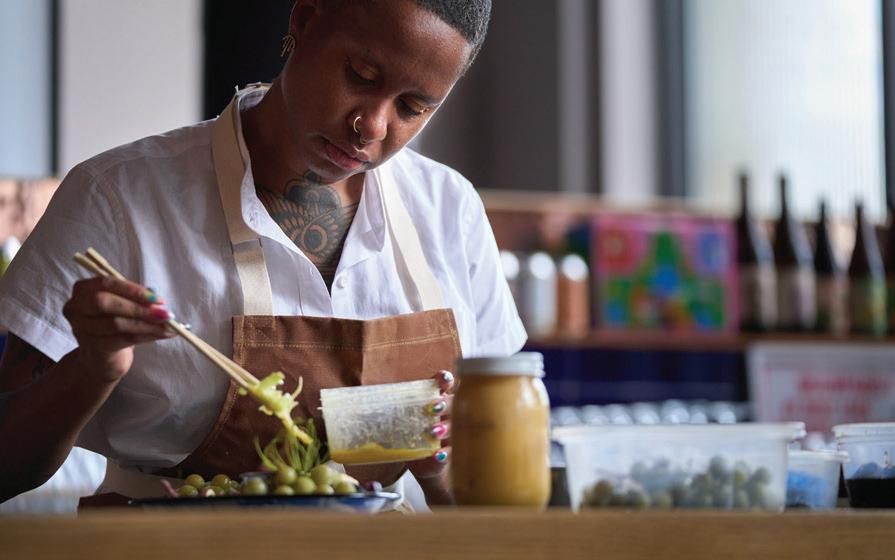
in a brigade system any day.
One of the reasons I now have a salary job is because Instagram changed everything; like way less engagement. In general, it’s kind of dead. And the folks that were the most dedicated now are burnt out, because there’re only so many times that you can deal with a frustrated customer, or someone not really listening to you, or not getting the concept of something and wanting to show up at your house in the middle of the night.
The boards I was turning out were beautiful. And it was really disheartening to see a slump in sales combined with the grind of running an underground business. It wasn’t fun anymore. It felt like it was the end of an era. Something in the back of my head was just like, “Maybe get a bit stable and come back to this when you
emotionally abusive. This is the first time where I’m able to earn a check and not worry about anything else besides this nine-to-five.
I hate that we see cheese as being a bourgeois thing. It’s a way that folks have sustained themselves for years. Many cultures practice dairy preservation. I think of how the ploughman’s lunch—or just bread and cheese—have sustained both the rural laborer and factory worker.
I’d rather think about that than something that’s served in a Michelin-starred restaurant that only a few have access to. I think both Velveeta and Brillat-Savarin have a place in a conversation about cheese. It doesn’t benefit anybody to be elitist about it. v
@MikeSula
20 CHICAGO READER - NOVEMBER 10, 2022 ll
“Gatekeepers really respect small pieces of paper. So if I have a piece of paper that says I know about cheese, maybe people will take me a little bit more seriously.
—Alicia Norris Jones
Alicia Norris Jones has a passion for designing cheese boards and making cheese accessible to all. MATTHEW GILSON FOR CHICAGO READER
continued from 18

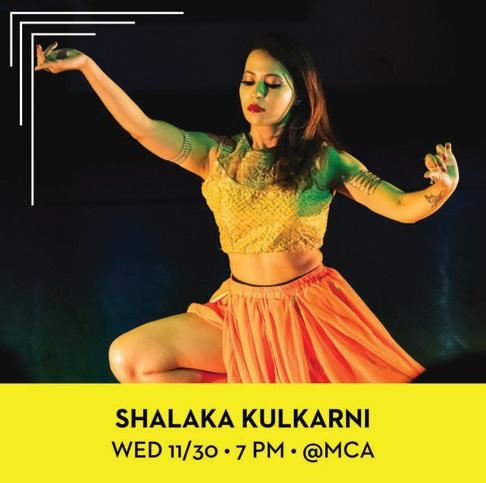








NOVEMBER 10, 2022 - CHICAGO READER 21 SUPPORTING SPONSORS CFL Workforce and Community Initiative The Darrell R. Windle Charitable Fund and Polo Inn
TICKETS AT CHICAGOREADER.COM/50ISH OR SCAN THE QR CODE YOU ARE INVITED to 3 levels of Music + lIVE ART + Dance NOvember 30 7pm @ MCA See these performers and more on November 30!
Miriam U. Hoover Foundation Quarterfold LLC Pritzker Pucker Family Foundation The John D. and Catherine T. MacArthur Foundation
the PEOPLE issue Tamar Manasseh
Interview by JAMIE LUDWIG
Photos by Olivia Obineme
Tamar Manasseh is the founder and president of anti-violence organization MASK (Mothers and Men Against Senseless Killings). An ordained rabbi, Manasseh launched her latest initiative, We Are Jane, in response to the burgeoning reproductive rights crisis. Formed in the spirit of the Jane Collective, the grassroots Chicago organization that operated from 1969 until the Roe v. Wade decision legalized abortion in 1973, the nonprofit is dedicated to providing information about safe abortion and connecting communities to resources and care. Find out more at wearejane.org.
There’s a Jewish saying, “Kol Yisrael arevim zeh lazeh,” or “All Israel for each other all the time.” That is my core principle.
I grew up in Englewood, but I attended a Jewish day school in Hyde Park. It was like being in two different worlds every day. So Jews have this principle, but we don’t really use it unless we feel threatened. Then we tend to circle the wagons—just look at what’s happening with what Kanye said. At any other time, Jews are constantly bickering, but when there’s a threat we come together to support one another. Black people need that sense of commitment to others in our community, but that’s not necessarily something we’ve been taught. But that’s my guiding principle, and so I apply it to Black life.
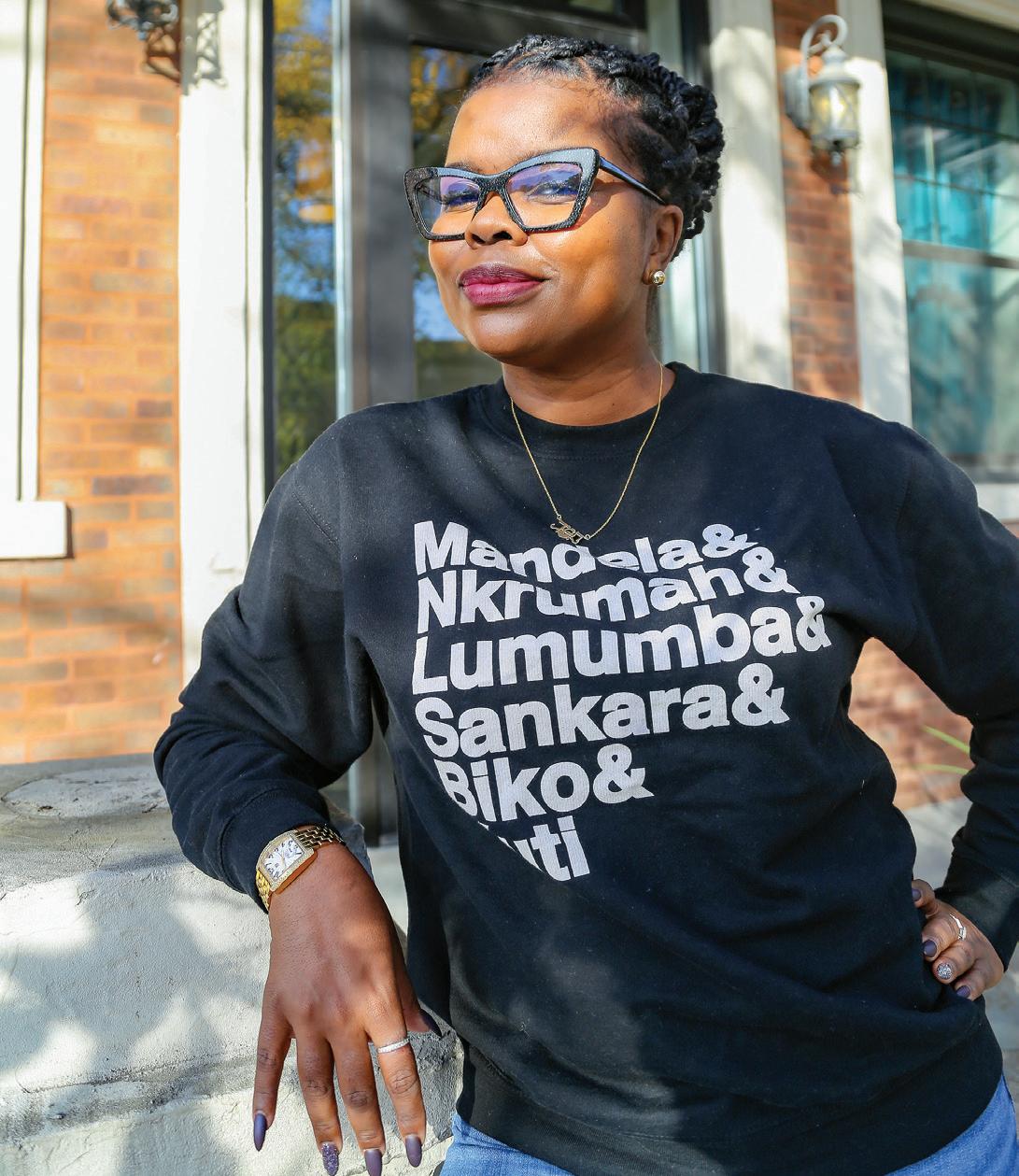
T h e p r o t e c t o r
22 CHICAGO READER - NOVEMBER 10, 2022 ll
OLIVIA OBINEME FOR CHICAGO READER
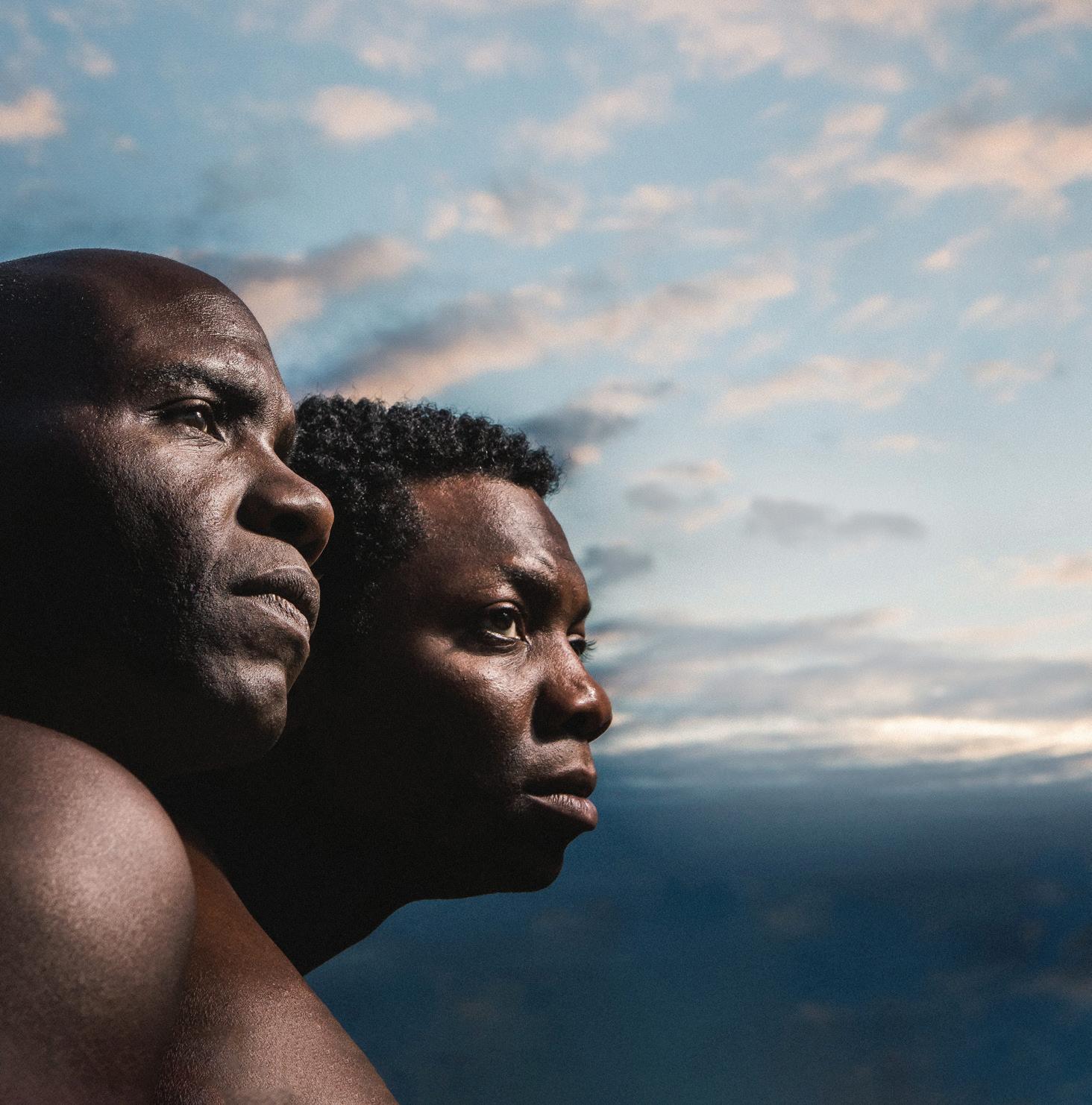


NOVEMBER 10, 2022 - CHICAGO READER 23 2022 TONY AWARD REGIONAL THEATRE 5535 S Ellis Ave, Free Parking (773) 753-4472, CourtTheatre.org
THE ISLAND BY ATHOL FUGARD, JOHN KANI, AND WINSTON NTSHONA DIRECTED BY GABRIELLE RANDLE-BENT FEATURING RONALD L. CONNER KAI A. EALY NOV 11 – DEC 4
Photo by Joe Mazza
A lot of people don’t understand why I do the things that I do, but we’re part of a community, so I have to care. I’m going to look out for you, I’m going to help you if you need me, I’m going to stand up for you if you need someone to stand up for you, I’m going to speak for you when you can’t speak for yourself. I’m going to do those things because that’s a thing that all Jews learn: We support each other.
I don’t necessarily call myself an activist, because when you say you’re an activist a lot of people don’t get involved; they’re waiting for the activists to step up. I tell people all the time, “Look, I’m just a mom. I’m going to get involved because it’s all about ‘How do I save my kids?’” It’s important to know that anyone can be an activist and everyone should be an activist. There should be something that angers you to the point where you have to find a way to fix it.
I talk all the time about Jews and Black people having the same monsters under their beds and how we need each other. White supremacy has been our problem since we got here, and now you have guys like those in Charlottesville with the tiki torches saying “Jews will not replace us.” All of these people hate both of us and are dangerous to both of us. So right now, more than ever, we need a coalition. We need real connection, because how else do we stand
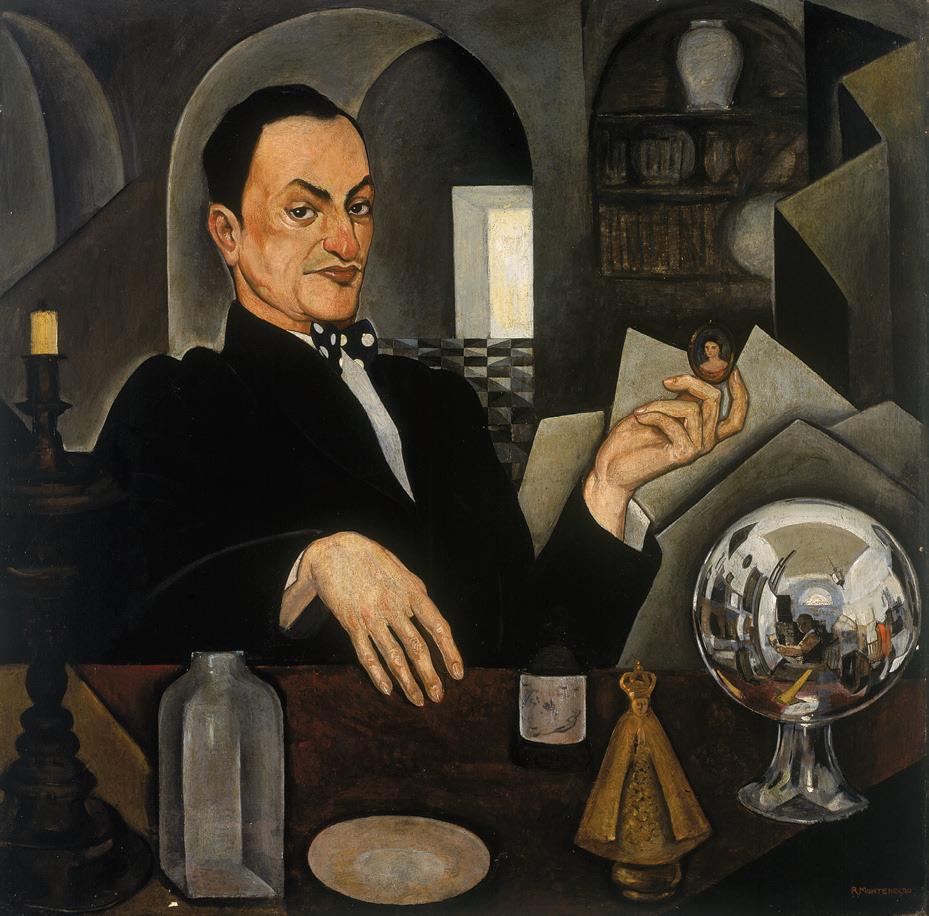
against that? There’s not enough Black people to stand against that alone, there’s not enough Jews, but we’re pretty formidable when we stand together.
I got involved [in MASK] because my friends were losing their children. There were so many young people being murdered it was like I was hearing about it three times a day. My daughter had a friend who was murdered. What if she’d been standing next to him? She could’ve been shot too.
Literally everything for me—with MASK and with the Jane thing—goes back to Reverend Niemöller’s quote that you hear over and over again on Yom HaShoah [Holocaust Remembrance Day]: “They came for the socialists and I didn’t speak up, then they came for the trade unionists and I didn’t speak up, then they came for the Jews and I didn’t speak up, then they came for me, and there was no one left to speak up for me.” I’d see the violence on the west side. I didn’t live on the west side, so I didn’t care. But when you see it in front of your own home, it’s like, “Wait a minute, this is getting too close. It’s coming for me.”
I was thinking about different ways to go about [fixing] that when a mom was murdered in a drive-by while she was breaking up a fight. It was early evening in the summer. It was still daylight. And the news reported that she was
really bothered me. If parents can’t parent because they’re afraid of being murdered, what happens? The entire community breaks down. That was the last straw. I knew enough about the streets to know that there would be a cycle of retaliation for somebody’s mother being killed. So, three days later, we went out there with barbecue grills and pink T-shirts. My theory was, “I don’t believe anybody wants to kill anyone with a group of mothers sitting on a corner watching them.” And they didn’t. It worked. We disrupted [the violence].
It’s the same thing with We Are Jane. In this country, every right that Black people have has come from the stroke of a pen. If you can start taking things away, you can take anything away. It doesn’t stop with same-sex marriage. It doesn’t stop with a rmative action. It doesn’t stop with interracial marriage. If you have a Supreme Court that has absolute power, there’s no reason for them to stop. If they’re saying they want a Christian nationalist America, how many of our rights have to be rescinded in order for them to get to that? A lot of them.
That puts us all in danger. People can say, “I don’t support abortion. That’s not my thing.” OK, that’s cool. I get that. But it’s not just about your opinion—it’s so much bigger than that. Do you support 18-year-olds going to jail for murder? Do you support women dying? Are
24 ll
“ We’re all scared, but I’m always more afraid of what happens if I don’t get involved than what happens if I do.
SUPPORT FOR THESE EXHIBITIONS IS PROVIDED BY ALPHAWOOD FOUNDATION CHICAGO IMAGE CREDITS: Roberto Montenegro, Retrato de un anticuario o Retrato de Chucho Reyes y autorretrato 1926, oil on canvas, 102.5 x 102.5 cm, Colección Pérez Simón, Mexico. (Detail) A revealing look at same-sex desire. Discover how artists across five continents expressed queer identity in this pioneering, multimedium survey from collections around the globe. THRU DEC 17, 2022 wrightwood659.org THE FIRST 1869-1930 GLOBAL DEPICTIONS OF A NEW IDENTITY PLEASE NOTE: The First Homosexuals contains sexually explicit content. For mature audiences only. ONE OF THE TOP 15 LGBT ART SHOWS NBC Out “SPICING UP GLOBAL MUSEUMS THIS FALL” continued from 22
—Tamar Manasseh
you for families being torn apart? Are you for girls having to drop out of college? Are you for rape victims being traumatized because they have to carry a baby of a rapist? Are you for women being suicidal? Because when you say, “I don’t support a woman’s right to choose,” that’s what you’re saying. There’s this whole litany of things that you’re saying you believe in that I don’t think you want to admit to—or maybe you don’t believe them, but you haven’t thought this through.
Black women and girls have abortions at a higher rate than other groups. And there are so many things that Black families are dealing with right now. You’re worried about how you’re going to pay your bills, and about inflation and the price of everything going up while your wages stay the same. And in Chica-
your kid is fighting a murder case. Can you a ord to pay a lawyer to fight a murder case?
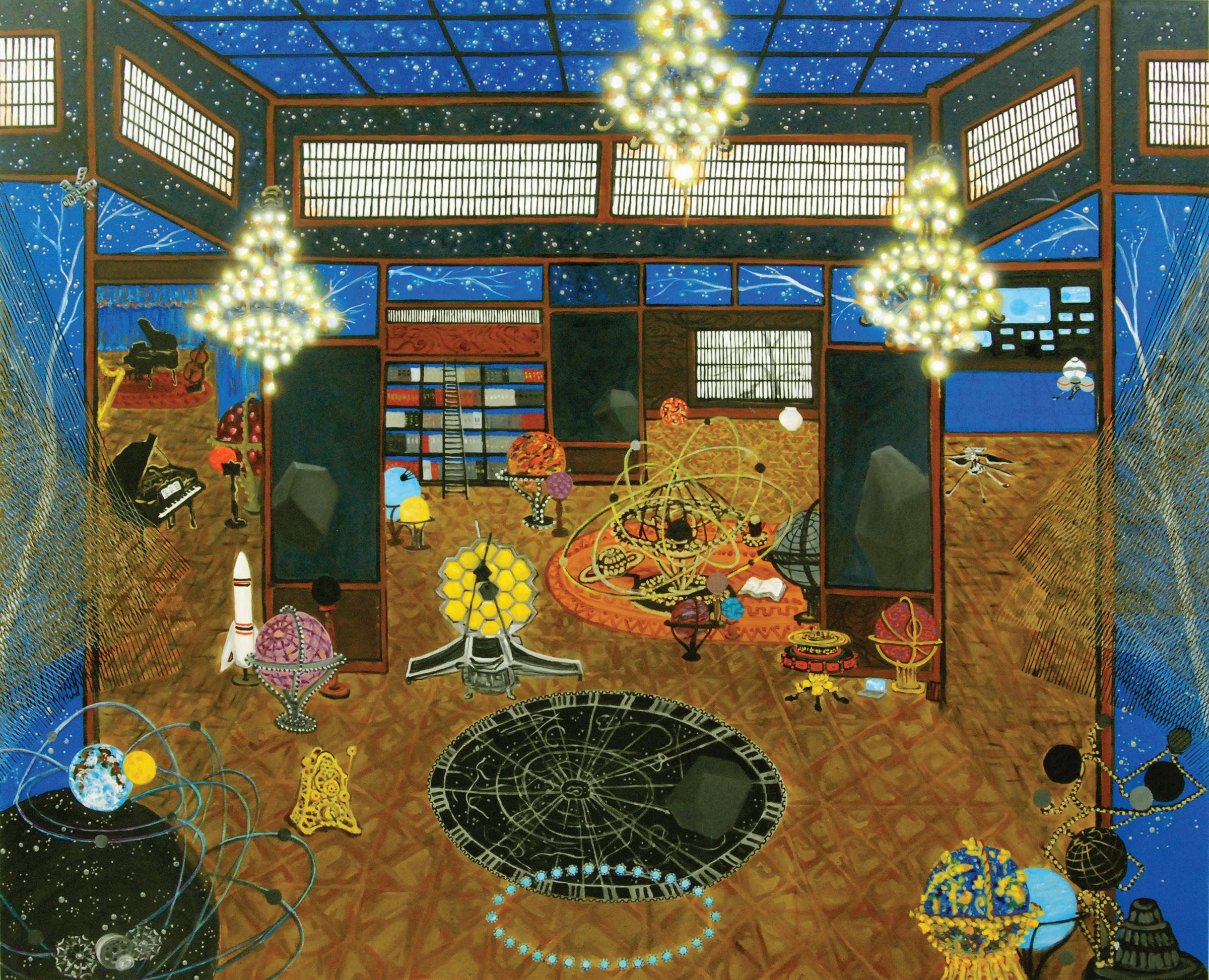
It’s not just Black parents: it’s all parents who send their kids away to school in states where abortion is banned. And it’s not just college students. It can happen to anybody. It’s about women’s health, period. When I was 16 I had to take birth control just to regulate my period. In some places I could’ve bled to death because I couldn’t get medication to fix the issue. It’s regular health care. You don’t have a problem when I have a root canal, but you have a problem with this?
I feel like this is a dry run for whatever is coming next, and what happens depends on what kind of backlash and outrage comes from this. When Donald Trump won the presidency in 2016, there were women’s marches all over

SUPPORT FOR THESE EXHIBITIONS IS PROVIDED BY ALPHAWOOD FOUNDATION CHICAGO IMAGE CREDITS:“Collection Sol III” painting from Celestial Maze 22-B-1 Michiko Itatani, 2022, 78” x 96,” oil on canvas, courtesy of Michiko Itatani (Detail) Explore mysterious portals to the unknown. Celebrate the breathtaking and exquisite works of Chicago-based, American artist Michiko Itatani, through her mystical paintings and drawings. THRU DEC 17, 2022 wrightwood659.org MUSEUM PUBLICITY “Inspiring grandeur of the unknown”
the PEOPLE issue Lynne Rousseau McDaniel
Interview by DEANNA ISAACS Photos by Olivia Obineme
Lynne Rousseau McDaniel, dealer in historic furniture and fine art; co-owner, with husband Ty McDaniel, of two Chicago-based businesses: Estate Sale Goddess and An Orange Moon (2418 W. North); the Goddess of WOW.

I’m from Englewood, south side of Chicago. In the words of Michelle Obama, south side, nothing else need be said. I went to Englewood High School. Kelly Library was our branch. My husband grew up four blocks down from me. It was an amazing neighborhood.
My maiden name is Rousseau, my father was Universal Brokerage—real estate, so that’s why I have a love of architecture. And my mom graduated from Ray-Vogue. She was an interior designer. That’s why I have the love of art and interior design.
We had art books, we had encyclopedias, and we got six newspapers delivered to our home. Our church was Saint Martin. Father John was the priest who came to our house every Sunday for dinner. The ritual is you go to church and you go to grandma’s house. But if you’re lucky, you get to hang out with Dad. After church we’d sneak over to Maxwell Street, he’d buy some antiques, then we’d go get changed and go to grandma’s house for dinner and dessert. Every Sunday.
I did my undergrad at DePaul and my graduate work at the Adler School of Professional Psychology. I always planned to be a clinician, but the call of art and antiques was just too
26 CHICAGO READER - NOVEMBER 10, 2022 ll OLIVIA OBINEME FOR CHICAGO READER
T h e g o d d
s s o f W O W
e
<intergalactic gargoyles>


contorting my spacetime continuum at their leisure such boldness from cement existence on a flake of belief is like wearing sharp teenage earrings expected + destructive shushing absurd but realistic fears my cheeks are fat w/ wet humidity teases layers like origin stories my delicate wig shining in choppy snarls fragments of true passion living b/w dense bristles a daydrunk excuse rune of conviction i pray to thee here in this poem i transcended the use of promises a flowery bloodpact afternoon
what a terrible use of space + perfect moonslices
By Sara Matson
Sara Matson (she/her) is a poet in Chicago. Her poems can be found in Bone Bouquet, Impossible Task, Ghost City Press and crumpled in recycling bins from Berlin to Waukegan. Sara can be found under a pile of her three cats or on Twitter as @skeletorwrites.



Poem curated by Jacob Saenz. Saenz is the author of Throwing the Crown, winner of the APR/ Honickman First Book Prize. His poetry has appeared in American Poetry Review, Memorious, PANK, RHINO, Tammy and other journals. A CantoMundo fellow, he’s been the recipient of a Letras Latinas Residency, a Ruth Lilly Poetry Fellowship and a Latinx Scholarship from the Frost Place. A biweekly series curated by the Chicago Reader and sponsored by the Poetry Foundation.
























Free Programming from the Poetry Foundation!













Diana Solís: Encuentros
Photographs of Chicago Poetry Communities, 1978–1994 An exhibition of photographs and ephemera exploring this unique moment in Chicago’s literary history. Open until January 2023
Encuentros: Exhibition Conversation with Diana Solís All are welcome to a conversation between Diana Solís and exhibition curators Oscar Arriola and Nicole Marroquin about individual works in the exhibition. Thursday, December 1, 7:00 PM
Hours Wednesday, Friday, and Saturday: 11:00 AM–4:00 PM Thursday: 11:00 AM–8:00 PM
Note: The Poetry Foundation building will be closed to the public from Thursday, November 24 and will reopen Monday, November 28.
Learn more at PoetryFoundation.org
NOVEMBER 10, 2022 - CHICAGO READER 27
NOVEMBER 18 DECEMBER 18 Fridays, Saturdays, Sundays | 11 a.m. – 6 p.m. LoopChicago.com/Market SCAN ME LEARN MORE N E W T H I S Y E A R !
strong. I started on Maxwell Street as a young woman in my 20s, buying and selling parttime. Fiesta[ware], sterling, vintage jewelry. Maxwell Street was crucial back then. There was no Internet. It was hustling, bustling, incredible. The way you do it, you just bump in. And then you hold your space, every week, so that space becomes yours. You run an ad in the paper. Every week, in the Sun-Times, in the small print: come to see me on Maxwell Street. My father always said he was buying dog food. Because on Maxwell Street you could get anything, and they would have cases of dented cans of dog food. Some had a wrapper, some didn’t. He said he was going for dog food, but he would buy antique tools. That was his thing: antique tools and fishing rods, and toy racing cars and trains.
After Adler, I went directly to Dr. Carl Bell. I did an interview with him before I graduated and he said, “As soon as you graduate, give me a call. I’ll have a place for you.” Mostly I worked with mentally ill substance abusers. It was a very hard job. And the grab of art and antiques still had me. No way that I could get loose from that. This is where Ty comes in. When I knew it was time to leave my job he said, “OK, let’s figure this out.” He’s a clinician as well. He was working at Circle Family Healthcare. I met him there, did my internship with him. He wants to plan everything; I’m just dealing with things from my heart. Together we’re a good team.
We’re 50s, 60s, and 70s—that’s a good little niche for us. I know earlier 1900s, because I started with antiques. He knows midcentury modern, so we can kinda do it all. The thing
about midcentury—you know, some of the antique furniture is clunky, chunky, heavy. Midcentury modern is sleek, sexy. You can put it in one of your spaces and it doesn’t take over the whole thing.
But I cut my teeth on country. When I first started I was doing quilts—Black quilts in particular. One of the quilts I purchased in North Kenwood a gazillion years ago was a quilt of the first Black alderman, Oscar De Priest. Someone made a quilt with his face on it. It was on baby blue satin and the face was painted, and it was quilted and edged all the way around. I didn’t know who the face was. I sold it to a dealer in River North. And then one day I walked into the Chicago Historical Society, now the Chicago History Museum, and when I looked up, there was my quilt hanging. That was the beginning of selling historic items.
An Orange Moon is named for a song by Erykah Badu. When we heard that song, both of us at the same time said, “Oh my gosh, yeah, that’s it.” Our first location was on 59th Street, in Chicago Lawn. We opened there in 2009, and moved here in 2011. Having the shop, we get to meet so many people. It’s wonderful. I’ve had a customer name a baby after me; I met Blue Man Group, Julia Louis-Dreyfus, Steve from Sex and the City, the governor of Minnesota, and a lot of other politicians. They all shop here.
Somebody told Hermès about us. And they showed up at the door. It was two well-dressed women, perfectly coi ed, and the best Birkin bags I’ve ever seen. It was probably about 10 AM, and I said, “Come on in, can I get you anything?” And they said, “Do you have wine, cheese, and bread?” They went through the
first bottle before I could even pass the bread and cheese. They said they were here because they were doing a party, and they wanted our furniture to do the set in the store. They’re speaking French. I said, “So nice of you to stop by,” and they said, “Someone will call you. And price is no object.” I’m like OK, you know, people say things all the time. And then, someone called. They rented all of our furniture. That was my first foray into the big leagues.
We just did the set for Common; he was here at Ravinia. We’ve done Chicago Fire, Chicago P.D., Chicago Med, every Chicago show or pilot that comes down the pike; the set designers will come here, see something, and ask if they can take it.
When we first came here [to this part of North Avenue], there was nothing going on. We created the WOW district—West of Western. It’s from North Avenue and Western to North Avenue and California, just these four blocks. WOW is an informal group of local businesses, about 20 at the height of it. Less now. One thing I had to learn was that everybody doesn’t stay in business. They come, they give it the old college try, they last a year or two, and then they’re gone. Then you gotta get somebody else in that space. And neighborhoods change, prices go up. It’s challenging. We have two businesses—An Orange Moon and Estate Sale Goddess—and we’re not in a position where we can o er any hand-holding or financial value to those other businesses. But I know that together we are stronger. The more businesses we have over here, the more people are going to come and bippity-bop from store to store.
Estate Sale Goddess liquidates historic
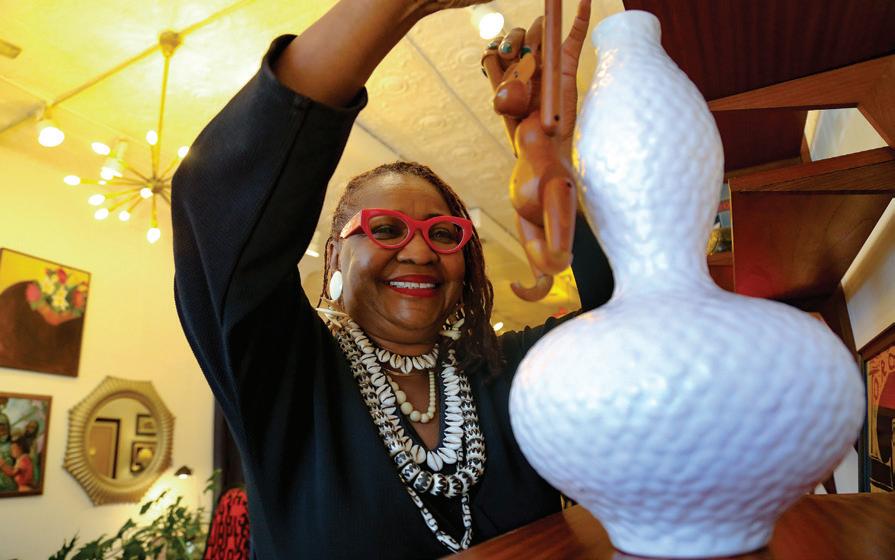
estates. For example we liquidated the estate of Jesse Owens, the Olympic runner. Also Lerone Bennett, 50-year editor of Ebony magazine. And we just liquidated the estate of Etta Moten Barnett and Claude Barnett. She was [Bess in] Porgy and Bess and he was the founder of the Associated Negro Press. Museums come and buy things from these estates. They’ll say, “Please close off the library or the music room, because we want to buy the whole thing.” When they come and jockey for position, that’s really interesting.
The pandemic; oh, my god. The pandemic showed you what you were made of. Initially, I was scared. Afraid of the illness, the death. I lost my brother Leslie and my dear Aunt Evelyn to COVID. So, I totally get it. And if the city says don’t open up, you don’t open up. Financially it got hard-core. Because no one could come in, we started selling on the sidewalk. The support was amazing. We were able to keep our doors open. And then we went appointment only. We had to pivot. A lot of things were involved in that decision, but appointment only offers a one-on-one private experience.
Some people don’t understand that this is quality and our prices aren’t going to be the same as Target. No disrespect to them, because they serve a definite purpose. But this is quality. These items are going to go up in value. The same items we sold 13 years ago for $200 are probably valued at well over $2,000 now. This furniture is an investment. v
@DeannaIsaacs
28 CHICAGO READER - NOVEMBER 10, 2022 ll
“ The pandemic; oh, my god. The pandemic showed you what you were made of.
—Lynne Rousseau McDaniel
continued
Lynne Rousseau McDaniel with some of the objects for sale through An Orange Moon. OLIVIA
OBINEME FOR CHICAGO READER
from 26






NOVEMBER 10, 2022 - CHICAGO READER 29 PRE ENTING PON OR NOMINATION OPEN NOVEMBER 10 chicagoreader. com/best
the PEOPLE issue Lia Kohl
Interview by LEOR GALIL Photos by Matthew Gilson
Cellist, composer, and improviser Lia Kohl was born in New York and grew up in San Francisco, but she’s a midwesterner at heart. She studied at Indiana University’s Jacobs School of Music, and after short stays in Berlin and New York she moved to Chicago in 2013. She’s a dedicated collaborator, helping shape the music of performance groups (including multimedia company Manual Cinema) and ensembles such as new-music collective Honestly Same and pop-oriented bands Whitney and Finom (formerly Ohmme, whose cofounder Macie Stewart has also recorded in a duo with Kohl). In March 2022, she released her debut solo album, Too Small to Be a Plain.
Both my parents are musicians. My mom is a singer and pianist and now a harpist, as of the last two years. My dad is a bass player. I grew up not with the expectation that I would be a musician but with the idea that music is a very normal part of life. It wasn’t something that was added on in school—it was a very familial thing.
My mom recently showed me a picture of myself at the piano. I think I’m probably two. I’m completely naked, and I’m banging on the piano. It wasn’t an expressed interest so much as, like, it was just around, and my mom would sing and play to me, and I loved that. My mom taught me piano when I was little, which I hated.
I took up the cello when I was in third grade, just as part of the school orchestra—I went to


30 CHICAGO READER - NOVEMBER 10, 2022 ll
GILSON FOR CHICAGO READER
MATTHEW
T h e
v
g
r d e c e l l i s t
a
a n t
a
Waldorf school. It’s like an alternative, very creatively focused schooling thing. It’s hippie school, basically. There was a lot of art and a lot of music, and one of the o erings in music was a little orchestra.
I don’t actually know where I heard a cello or where I got the idea that I wanted to play the cello. But my mom was like, “What instrument do you want to play?” I was like, “I want to play the cello.” That was my first self-su cient musical experience—like, I wanted to practice, I wanted to play in the orchestra, I loved playing in little string quartets with my friends.
I liked having this object that I could play with. Up until then, [my options] had been either the piano, which is so static and almost like a piece of furniture (no offense to any pianists), or my voice, which is just my body. But there was something exciting to me about having this thing that was almost the size of me, like a friend that I could carry around and then make sound with. I still love that about the cello. Not the “carrying it around,” but the size and the objectness of it.
I took lessons all through elementary and middle school. Then in high school I got into this program for people who wanted to play string instruments more seriously. It was akin to doing after-school sports really intensely. Every day after school I would play chamber music, and I was in a string orchestra and took private lessons. My whole after-school life and extracurricular life was music. There was a whole culture around that—with any extracurricular activity in high school, that becomes your friend group, your identity that you’ve chosen.
I also realized how many opportunities being a musician can give you. I went to

Switzerland when I was 16 to go to this music camp—that’s an insane experience, and it was just because I played the cello. It wasn’t because I’m particularly special. It was like, “I play the cello, and now I get to go be in the Swiss Alps.”
I didn’t have that, like, “Oh, I wish I was just hanging out, being a kid.” I love the athleticism and discipline of being a classical musician. It’s really intense, and I like that sense of purpose. Even now in my life, I tend toward maybe having too much of a need for that, instead of being like, “I can just chill.”
I spent a lot of summers in Germany, because I have an uncle who lives in Germany. He said, “Yeah, come over whenever you want.”
John Sharp—he’s amazing. But as soon as I got here, I started going to Constellation and hanging out with people who play new music, and with dancers, and getting into more weird stu .
It was funny to be studying with John, who’s the principal [cellist] of the CSO. He’s an amazing orchestral musician and such a kind man, and we had a lot of arguments about whether I should learn orchestra excerpts—that’s when I started doing the rebellious thing. I kept being, like, “I want to play this new music!” It was a really good relationship, but that’s when I started getting weird.
This is the thing about Chicago that I find to be so amazing. The first time I went to Con-
that I could have a voice. And that was a really new experience. And I think since then, especially through improvisation, I started to have the feeling that I do have a personality.
During the pandemic was the first time that I made anything completely by myself. I’m a very collaborative person and always have been, and obviously that was less of an option during the pandemic. I decided to just try to see what I sound like when I’m alone—even when I’m playing all the instruments and I try to make an orchestra for myself.
I think collaboration is the first part of my artistic personality. I’m very responsive. I feel like everything is conversation, and even in my own work, I feel like I’m creating situations
There’s a really amazing classical music scene in Germany, obviously, since that’s where classical music started. I would go over there and do what they call master courses, where you go and study with one person for a week or two weeks—you take lessons every day and you practice six hours a day. Having done a few of those summers in Germany, I was thinking about doing a master’s degree there. I moved to Berlin—not exactly on a whim, but not with a lot of a plan.
I spent nine months in Berlin living there, and then I decided that that was too intense— mostly just to be away from my mom. There were some priorities questions about being not far away from family. Twenty-two seems like being old enough to do that, but I didn’t actually feel like I was. So then I moved to New York for a couple years and studied with someone there, and then I moved to Chicago.
I came here to study with someone who plays in the Chicago Symphony Orchestra,
stellation, I sat next to this woman—I’m kind of a shy person, I don’t talk to strangers that much, but somehow I was talking to her—and she was a dancer. I said, “I’m a cellist. I would love to play with dancers,” and the next week I was in her rehearsal.
And I kept having experiences like that, where I suddenly felt comfortable to assert myself a little bit or just reach out to people. And people have reached so warmly back to me. It felt really astonishing, and it still feels astonishing that Chicago’s like that. But I didn’t actually feel like I had to do much—I just kind of appeared in places, and then people were welcoming.
I liked it immediately, and then after about a year I was like, “Oh yeah, I know a couple people when I go to a show.” That feels like home, you know?
I think classical musicians tend to think of themselves more as practitioners and certainly artists of the form. I started to have the idea
in myself where I can respond to something, even if it’s myself in the past. I’ve been doing a lot of work with radios, and something I really like about the radio is that I’m responding— you turn on the radio, and someone could say pretty much anything, except, like, a select number of swear words.
A lot of my daily life is recording for other people: recording cello, arranging strings, recording for commercials. I really like being challenged. Someone sent me an email yesterday that [had] all this lingo about commercials, and I was like, “I don’t know anything you’re saying, but I’m gonna google it all and it’s gonna be great.” What keeps me motivated is wanting to be challenged, which sounds a little bit like an inspirational poster, but it’s true. I like to put myself in situations where I don’t know what I’m doing and figure it out. v
NOVEMBER 10, 2022 - CHICAGO READER 31
“ I like to put myself in situations where I don’t know what I’m doing.
—Lia Kohl
Lia Kohl’s debut solo album combines cello with synthesizers, fi eld recordings, and radio broadcasts. MATTHEW GILSON FOR CHICAGO READER
@imLeor
the PEOPLE issue Izzy Reidy
Interview by PHILIP MONTORO
 Photos by Carolina Sanchez
Photos by Carolina Sanchez
Izzy Reidy leads the band Izzy True and plays bass in Tenci. He’s lived in Chicago on and off for around 12 years and teaches guitar, bass, and ukulele in public schools through Music House. He joined the Union of Musicians and Allied Workers in spring 2020, becoming part of its steering committee and abolition subcommittee, and in fall 2020 he helped launch UMAW’s Chicago chapter with Monoculture multi-instrumentalist Olan Mijana and Izzy True bandmate Curtis Oren.
The Chicago chapter held a gear drive, raised money to award microgrants to small DIY artists, and protested at Spotify’s local offices in March 2021 to help UMAW present its demands to the streaming giant. Reidy remains a member of the national union but is no longer active, and the Chicago chapter dissolved in late 2021. He’s still more than happy, though, to talk about the material conditions of indie musicians’ lives and the potential for organizing in the industry.
If you want to tour, it’s very hard to have a job. The only reason I’m able to tour is because I have a supportive family. That’s not to say that I don’t work, because I do, but I know that my resources have allowed me to do this as a career. A lot of people can’t, and that’s disturbing in the long term.
When COVID hit, the reason that people were so quick to mobilize is—it’s not just the musicians, but all the support staff. I was a venue worker up until really recently.
32 CHICAGO READER - NOVEMBER 10, 2022 ll
FOR CHICAGO READER
CAROLINA SANCHEZ
T h
g m u s i c i a n
e t o u r i n
I worked at the Hideout for five years. Door people, sound people, people who work frontof-house engineering, people on crews—all of your work is gone, and there’s no support. You’re not getting unemployment from your music job.
A lot of people don’t even get to the point of touring, because they’ve encountered that reality beforehand and it’s not workable for them. It’s like, “Holy shit, I’ve built my life in such a way that there’s nothing for me.” So a lot of people had to contend with that really directly after the pandemic hit. There’s no safety net.
Most people are scraping by on whatever health care they can get. Myself and a lot of people I know are on Medicaid, where it gets complicated if you actually start making more money from your music—you lose your health insurance. To me, it’s difficult to feel good about any of my accomplishments in the field, knowing that it doesn’t really have anything to do with your skill or your talent. It has to do with the fact that you can take these risks. And that’s not right. Everybody should be able to play music if they want to. A lot of people have been talking about economics in the industry, and for me it boils down to universal health care and a ordable housing. The thing that makes music such an interesting place to organize from is that what a lot of people basically need is a public safety net. That’s a powerful place to organize from—it would improve the lives of so many people.
Locally, I and some other union members were doing organizer training with the Industrial Workers of the World [IWW]. We were taking that whole-shop approach—everybody involved. The venue workers, the bartenders, sound people, you know, the people in the record plants—those were the people we
wanted to work with. We wanted to have it be a cross-industry union.
We wanted to get more information to people about how a deal for a show works, and what the di erent deals at the di erent venues are, and create a standard. One benefit of being a musician is you can be like, “Hey, fuck this place, we don’t want to play here because they don’t pay people,” and fans will respond to that. They won’t go. That was kind of the idea, in terms of direct strategy.
And then the indirect strategy for me was building coalition with people who were working for the people, basically. There was a hunger strike, the General Iron stu —we did a solidarity hunger strike to raise awareness around the pollution. If you approach musicians as typically members of the working poor, all that stu a ects musicians too. And you have a platform.
I feel very lucky to be in a position to make a little money on tour. The things that you need to get on the road—like, you need a car. Do you have the money to maintain the car and keep it on the road? Then gas, which is obviously a whole other cost that can fluctuate wildly. And then everybody has to eat. Also everybody’s taking time off of work, losing income, and you’re probably not going to make that money back.
For the vast majority of people who tour, it’s a net loss every time. You make your money playing shows, but if you’re a smaller band, you’re lucky if you get 100 bucks a night from the venue. That’s, like, good . Honestly, we make most of our money selling merch on tour. At the level that I’m touring now, we’re getting more money. But I’ve been touring since the week I turned 18, and I’m 30 now.
I’ve been on three tours this year so far. I’m going on a fourth one. Tours are usually
lost work, and nothing on the other side of it. That’s just one new thing that can happen. The whole host of regular things that can happen still do happen. In spring of last year, we were on a cross-country tour, and we were driving back through Colorado, and we got hit by a semitruck and almost died. And the car was totaled.
Venues aren’t really making that much money either. I mean, they’re making more money than musicians. But things that are concrete that could change now . . . I would love people to start focusing on, like, musicians taking responsibility for the things that they have control over. The going rate for a supporting band right now is $250, on a big tour. That’s what you would get per night—not a lot of money, considering all the up-front costs for a four- or five-person band traveling in this economy. There are things that we can do to sort of build a culture of accountability to each other, not buying into the ways in which musicians are sort of forced to take advantage of each other.
To me the issue is, how do we give artists the time and space to make art? We have the resources and the technology. So I guess what I’m saying is . . . massive global wealth distribution?
Reidy
around two weeks long. You’re basically leaving for at least one and a half, two months, and a lot of people tour harder than that. So you need to take a job that’s flexible. I teach in school. So you know, I’m gone two months— that’s a problem for the kids. I’ve definitely had to quit jobs to go on tour.
The other piece of it now is COVID. The first tour we did, once live music started to happen again, we camped a lot of the time. We made a rule that we weren’t comfortable sleeping with strangers every night, because it just didn’t seem safe. And obviously we can’t afford hotels.
You’re driving, like, three to six hours every day. And then on top of that, now we’re scheduling in, OK, we’re gonna get a COVID PCR test every other day. Buying rapid tests is an expense now, and buying high-quality masks. Then if one of us gets COVID, we’re going home. So all that lost income, all that
The system is broken beyond repair. It can’t work. There’s a really awesome initiative that the UMAW national is doing right now— they’re working with [U.S. House representative] Rashida Tlaib on a bill that would add a separate royalty, a streaming royalty, that streaming services would be charged, that would pay out directly to the artists. I think everybody should go out and sign that petition right now. Those companies are not designed to pay artists. They wouldn’t make money if they were paying artists what they should be paid.
My hope is that somebody will read this and think, “Wow, I really wish that [Chicago] chapter was still happening. Let’s make it happen again.” There’s so many incredible activists across Chicago, doing amazing work in the defund-the-police movement, and all the union e orts that are happening.
The other major issue with organizing musicians is that it gets people right in the most tender part of their egos. There’s a lot of mistrust of more successful musicians. People have an outsize idea of what somebody who is quote-unquote succeeding is actually—like, their material life conditions. It’s like, “Oh, you got some free shoes from Vans, you’re living high on the hog.” And well, no. That’s, like, it I don’t have health insurance. Neither of us has health insurance, and we’re arguing about shoes. v
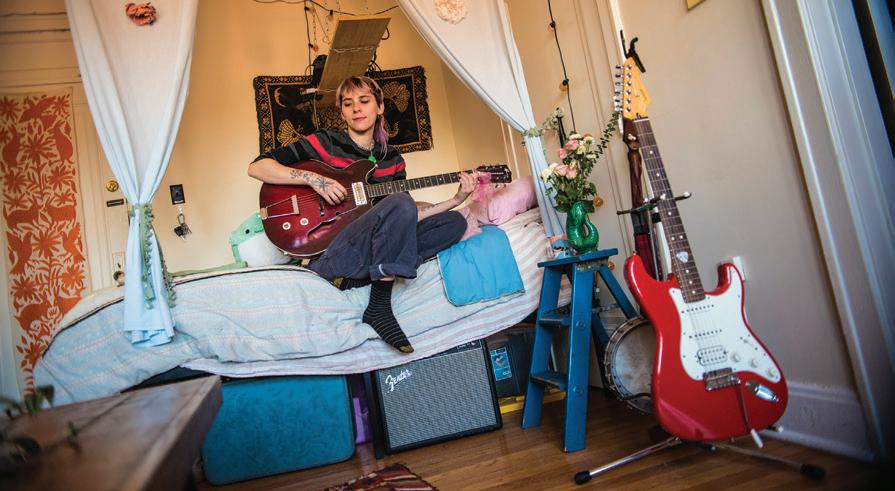
NOVEMBER 10, 2022 - CHICAGO READER 33
@pmontoro
“Everybody should be able to play music if they want to.
—Izzy
Izzy Reidy leads the band Izzy True and plays bass in Tenci. CAROLINA SANCHEZ FOR CHICAGO READER
the PEOPLE issue

Vicko Alvarez
Interview by KELLY GARCIA Photos by Eddie Quiñones
She never liked the spotlight. At five feet tall, Vicko Alvarez could easily be overlooked in a crowded room— and she’d be perfectly fine with that. But on a brisk morning in October, Alvarez walked along a row of bungalows in Chicago Lawn, studying a map of the newly redrawn boundaries of the 15th Ward, where she’s hoping to become the next alderperson. She carried a clipboard with ballot petitions, a “Make Your Mama Proud” tote bag slung over her shoulder. Between introducing herself to residents and asking them to sign the petitions, she earnestly answered my questions.

A Texas native, Alvarez fell deeply in love with Chicago upon moving here 16 years ago, and she never looked back. Since then, she has worn multiple hats—community organizer, chief of sta to 33rd Ward alderperson Rossana Rodriguez-Sanchez, teaching artist—and in each, she says she was dedicated to fighting for a world in which workers are treated with dignity, families are nurtured, and communities are thriving.
But she never expected to run for o ce.
“I feel motivated to figure out how to uplift so much of the organizing work that’s already happening across the 15th Ward, where the only missing link is that government o ce,” she told me. “I’m also trying to figure out how this campaign can be not just about me, but also about how to share the skills that I’ve learned.”
T h e s o c i a l i s t
34 CHICAGO READER - NOVEMBER 10, 2022 ll
QUIÑONES FOR CHICAGO READER
EDDIE
T hough she had already surpassed the minimum of 473 signatures needed to get on the ballot, Alvarez, no stranger to the political schemes that disqualify petitions, aims to collect far more by the November 28 deadline.
In 2006, Alvarez left the long, hot summers of Texas to pursue an undergraduate education at the University of Chicago. Her first friends were dining hall workers who, like her, spoke Spanish. At the time, U of C food service employees represented by Teamsters Local 743 were fighting for a fair union contract. Alvarez knew nothing about unions, but she o ered to translate union materials into Spanish. That led to connecting with other students on campus who were similarly engaged on labor issues. Over time, she developed a passion for organizing the workplace.
ent places, but always felt most at home with the friends who had opened their doors to her on the southwest side. In neighborhoods like Little Village and Back of the Yards, she was able to reconnect with her Mexican roots when going back home to Texas was no longer feasible.
It was almost inevitable that Alvarez would become deeply involved in Chicago’s political scene.
During one of the regional meetings she attended as a student organizer with a midwest Chicano student group, Alvarez met Carlos Ramirez-Rosa, then a student organizer from the University of Illinois at Urbana-Champaign who she says would talk her ear off about electoral politics. She didn’t take any of it very seriously until 2015, when Ramirez-Rosa successfully ran for alderperson of the 35th Ward and became the youngest and one of the first openly gay members of the City Council.
my name
“ It was like, wow, somebody within my immediate community is about to win this seat that before felt so distant from my own reality,” Alvarez said.
She quickly discovered that the skills she picked up as a union organizer, like knocking on doors and making phone calls, easily translated to political campaign work. After Ramirez-Rosa’s successful campaign, Alvarez began canvassing for other young socialist candidates eyeing seats on the City Council, like Byron Sigcho-Lopez and Rodriguez-Sanchez—candidates she felt were propped up by grassroots organizing instead of their own political ambitions.
In 2019, she became chief of sta to Rodriguez-Sanchez, whose ward encompasses Albany Park, Ravenswood Manor, Irving Park, and Avondale. In that role, she handled ward services and infrastructure needs, and assisted in policy research—all essential knowledge that she says informs her own bid for alderperson.
willing to put up with,” Alvarez said.
L opez has been challenged twice by candidates of the progressive field. During a runo in 2015, Lopez beat former police o cer Rafael Yañez, who told the South Side Weekly he supported reforming the department. When Lopez sought reelection in 2019, he was again forced into a runo by Yañez and young progressive candidates such as Berto Aguayo, who described Lopez as “reactive” to community violence instead of interested in attacking the root causes of the issue.
map for all 50 wards as part of the redistricting process that takes place every ten years. Historically, the 15th Ward has splayed across five di erent southwest-side neighborhoods: Brighton Park, Gage Park, Canaryville, West Englewood, and Back of the Yards. Critics of the redistricting process have argued that neighborhoods like Englewood—which is fractured into five di erent wards—are forced to compete for limited resources with other neighborhoods and don’t get fair representation in the council.
But while she was finding fulfillment outside the classroom, her grades were slipping. “I almost got kicked out,” Alvarez recalls. Asked what it was like attending a predominantly white institution as a Latina, Alvarez says she didn’t love it, adding that she was far from a model minority. It was only among the workers on her campus that she found community and purpose.
A fter graduating, she joined United Students Against Sweatshops (USAS), a national organization that fights for economic justice and workers’ rights. USAS focuses on the labor conditions inside factories that produce collegiate apparel. As a campaign director, Alvarez worked with college campuses nationwide to pressure university administrations into holding these factories accountable for the treatment of their workers.
She spent a couple years traveling to di er-
In July, Alvarez announced she was running to be alderperson of the 15th Ward as a Democratic Socialist in the 2023 municipal elections. The two-term incumbent, Alderperson Raymond Lopez, had announced months earlier that he would be throwing his name in the race for mayor. For residents of the south-side ward, Lopez’s departure is an opportunity to reimagine possibilities under new leadership.
As one of the more conservative members on the council, Lopez has been criticized for his stances regarding crime and policing. When 13-year-old Adam Toledo was killed by a Chicago police officer last year, Lopez told Fox32 that he thought the o cer showed “amazing restraint” because he only shot Toledo once.
“I think that when someone like Raymond Lopez goes unchallenged, it sets a nasty precedent about our neighborhoods and what we’re
In the 2023 election, Alvarez is running for an open seat. In contrast to Lopez, she’s been branded as the “defund-the-police” candidate. “And I have no problem with that,” she said.
Alvarez believes there’s a false assumption that residents of the south and southwest sides generally want more police because they live in “unsafe” neighborhoods. In reality, she says, those residents want to see greater investments, such as grocery stores that are within walking distance, more educational opportunities, and mental health clinics.
“I think it’s a false assumption that exists simply because it’s the poorest people, the people who are usually the most brutalized by police, who don’t always have the biggest mike to speak up on these issues,” Alvarez said. “So it feels like people impose their own assumptions onto them.”
One of her greatest challenges might be the 15th Ward’s heavily gerrymandered map.
I n May, the City Council approved a new
It’s also a confusing process that leaves residents wondering why their neighbors across the street are in a different ward. This year, the boundaries in the 15th Ward were changed to include Chicago Lawn. “I thought Chicago Lawn was in the 16th Ward?” one bewildered resident asked Alvarez.
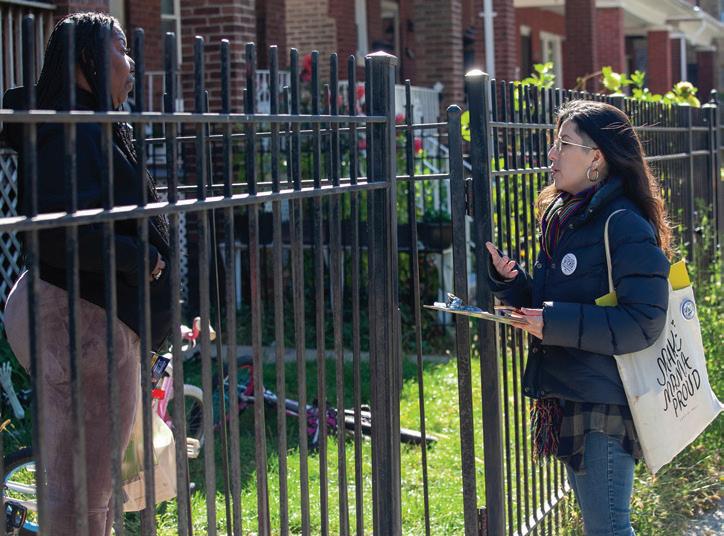
“ My honest opinion is that we got the leftovers,” Alvarez told the resident peeking around her door. “The best I can do is draw from my work experience in the different neighborhoods of the 15th Ward and see where we can find some common ground. It’s going to be hard. Every neighborhood has their hyperlocal issues that they have to focus on, whether libraries or streets, but the reality is that we’re in the 15th for the next ten years and we have to make the best of it.”
W ithout pause, the resident signed her petition. v
NOVEMBER 10, 2022 - CHICAGO READER 35
@_KellyGarcia__
“
Hi,
is Vicko Alvarez, and I’m running to be your next alderwoman.
—Vicko Alvarez
Socialist organizer Vicko Alvarez is running for 15th Ward alderperson in the 2023 election. EDDIE QUIÑONES FOR CHICAGO READER
Zeetus Lapetus
the PEOPLE issue

Community curator, space-funk icon, and nonbinary hair color extraordinaire Zeetus Lapetus—whose government name is Shomari “Sho” Daniels—fell into DJing at the peak of the pandemic. Daniels hosts Fortune, one of the hottest queer dance parties in Chicago, and spins at local clubs.

“I am a little, queer, Indigenous child of God that listened to a lot of house music when I grew up, and disco and funk,” Daniels, 28, said. “That was basically . . . all my mom would let me play, or like gospel. And I always loved outer space as a kid.” The stage name Zeetus Lapetus references Zenon, a 1999 Disney film about a “funky out of this world girl,” Daniels
said. “Zeetus Lapetus was like future slang for like, ‘Oh my God. What the fuck?’ [An] exclamation, a sense of like, what’s going on?”
Daniels was born in Chicago, but grew up in the south suburb of Richton Park, where their mom moved the family when they were still a toddler. They spent weekends in Chicago to attend church and see cousins and friends.
“Everybody thought we’d have, like, a decent life. But more than anything, it was more sad, because over the years everything just started decaying out there. It became a food desert for a little bit. And there’s nothing to do,” Daniels said. “I love where I’m from and all that jazz, but it’s a very depressing energy. Coming into the city it felt like a little more
36 CHICAGO READER - NOVEMBER 10, 2022 ll
CAROLINA SANCHEZ FOR CHICAGO READER; STYLING BY IZZY JACKSON
T h e i
e r g
l
c
n t
a
a c t i
Interview by DEBBIE-MARIE BROWN
f u
k D J
Photos by Carolina Sanchez
n
rhythm, there was more of a pep in people’s step. It felt like a smaller, cheaper New York.”
After graduating high school in 2013, Daniels attended Ball State University, but they dropped out after five months, and eventually returned home to Richton Park in 2015 because “I was too broke to go anywhere else.” For a while, they lived at home with their mom and commuted an hour on the Metra to Chicago for work, seeking better pay and “more excitement.” They worked a series of odd jobs at Uniqlo, Cheesie’s, Ross, and more.
At the peak of the pandemic, Daniels was depressed and living alone in Chicago when they had an epiphany. Upon hearing that The Good Place actress Jameela Jamil started her career as a DJ, Daniels decided to take a similar route: they bought a controller and taught themselves to produce mixes with an iPhone app. From the start, Daniels’s mixes had a sound they described as coming from an “intergalactic funk, queer weirdo, from like, Planet Nine or something, you know?”
Daniels landed their first (online) gig as Zeetus Lapetus through Dreamhouse Chicago, a local queer production company. From that, they were able to secure a regular in-person gig at Golden Dagger’s Happy Hour in 2021.
Andrea van den Boogaard, 25, a bartender and production manager at Golden Dagger, met Daniels when they started DJing there. “Sho is one of those people that I feel, like, refuses any kind of box that they could possibly be put in,” she said.
“My first experience of them was that they must have known everybody who was there because they were so warm, and they were so familiar with everyone right o the bat.” Van den Boogaard later learned that Daniels was meeting most of the people for the first time that night. She recalls Daniels demonstrating “a genuine interest to get to know and celebrate every single person in front of them.”
After those two shows, Daniels began acquiring DJ residencies and playing progressively bigger venues, such as Berlin, as well as
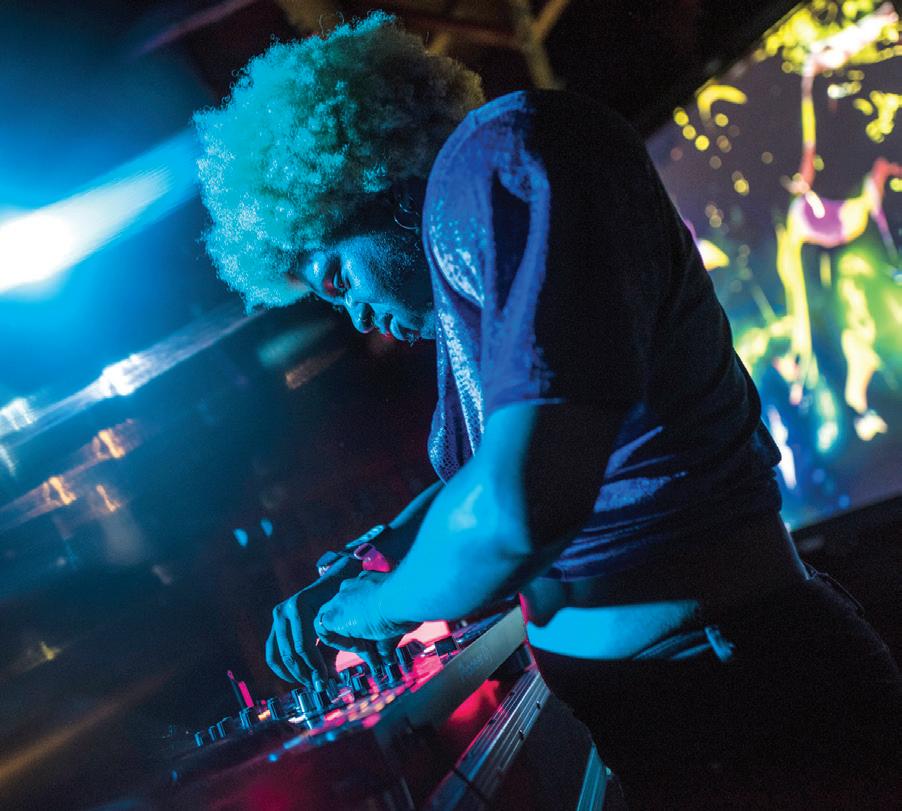
their audience,” van den Boogaard said. “With Daniels though, even in these really crowded spaces . . . they were mingling with the crowd, they were dancing with the people who are patrons.”
“When I was younger, I knew how it felt to be excluded from things,” Daniels said, “so whenever I am in this space, I want other people to feel very safe, and welcome and like a sense of love when you come into a place.”
Fortune is a monthly Wednesday night queer dance party where anything can hap-
of people are coming through who “have more manners” and the space feels more community-based. “You could tell [the team] actually put more e ort into their set and like visuals. Curating like a good vibe for everyone.”
“In Chicago and the greater music community, we’re really experiencing a lot of change right now . . . a lot of radical thinking about how we can create spaces that feel together and feel collected [and] stripped of a lot of power dynamics that can be super isolating within the scene,” said van den Boogaard.
shows like Saltfest and the Chicago Independent Venue League (CIVL) Fest in Millennium Park. “I never fathomed the places I could go with this,” Daniels said.
This year, Daniels started hosting a talk show on YouTube where they invite artists, organizers, and residents to do arts and crafts, be interviewed, and then perform. “It’s like if Mr. Rogers met Eric André, and I Dream of Jeannie, and a little Black child,” Daniels said.
“As someone that works with DJs, it is so frequent and so common and accepted to have a really harsh divide between the DJ and
pen, but in an experience meticulously cultivated by a collective of DJ Zeetus Lapetus, DJ Ayeeyo, DJ Blesstonio, booker Kenya Élan, and host Jaxx Masada. Formerly hosted at the Hideout, Fortune sold out at 150 capacity on its very first night.
Flaming Homosexual, or Flame, is a 24-yearold drag artist and Daniels’s best friend. Flame describes Fortune as di erent from what he’s used to in Boystown, “where sometimes the energy can be very aggressive and white, [predominantly] cis gays. I don’t really feel like I belong there.” With Fortune, he said all types
“Having people like Daniels lead this new renaissance and the entire team of Fortune and all the people that they collaborate with . . . I’m excited for those to be the voices that lead Chicago into whatever this next chapter is creatively, for all of us.”
Does Daniels still want to be an actor? “Yes,” they said, because they love entertaining people. “And DJing, it’s just another facet of [that] . . . I would love to continue DJing. This is actually my plan. That’s my bread and butter.” v
NOVEMBER 10, 2022 - CHICAGO READER 37
“
When I was younger, I knew how it felt to be excluded from things, so whenever I am in this space, I want other people to feel very safe, and welcome, and like a sense of love.
—Zeetus Lapetus
Shomari Daniels , aka Zeetus Lapetus, discovered DJing during the pandemic. CAROLINA
SANCHEZ FOR CHICAGO READER
@debbiemarieb
Caroline Cash
Interview by MICCO CAPORALE
 Photos by Matthew Gilson
Photos by Matthew Gilson
s t the PEOPLE issue
Twenty-six-year-old punk cartoonist Caroline Cash has already made a name for herself. In 2014, she left Charleston to attend the School of the Art Institute of Chicago, and since then, she’s become an integral part of the local comics scene. Between satisfying general education requirements her senior year, she wrote and illustrated her now critically acclaimed debut graphic novel, Girl in the World, which follows different twentysomething girls on uniquely wild nights in Chicago until they all end up at the same party. After graduating in 2019, Cash worked at Quimby’s while aggressively drawing, reading, and networking. It’s paid off. Earlier this year she won Outstanding Minicomic at the Ignatz Awards and left Quimby’s to pursue freelancing full-time. Now Cash is hard at work on a graphic novel about stoner lesbians.

I’ve always loved comics. I read and drew a ton of comics as a kid. I’d get the paper and read Peanuts first. Every day, it was like, “What’s up, guys? What’s going on here! Oh? Charlie Brown is sad? Classic.” I just loved the art style. I really looked forward to that and Ziggy, Garfield, stu like that. I read pretty much everything except Sally Forth because I didn’t understand those stories. At nine, I went through a big “drawing guys with spiky hair” phase. Naruto , Rave Master , Sh ō nenJump , Yu-Gi-Oh! , Pokémon : it’s what my local library had!
When I was a teenager, I stopped all that. I was more interested in being, like, a painter or whatever—what I thought was a “real” artist. I went to an arts high school, so that skewed what I thought a “real” artist is. School was like, “This is how you make art. This is how you use a paintbrush. This is how you use color pencils.” I was trying to quickly learn
38 CHICAGO READER - NOVEMBER 10, 2022 ll MATTHEW GILSON FOR CHICAGO READER
T h e c o m i c
s a r t i
how to be, like, not awful at these different mediums—like how to draw a flower and make it look realistic or whatever. I didn’t think too much about why I was doing it.
In college, I finally asked myself, “What do I want to make work about?” And that spiraled into being more interested in storytelling and illustration, and then you combine the two and you’re like, “Oh, I think I just want to make comics!” I’m back to wanting to do the same thing I wanted to do when I was nine, you know?
Chicago has a great comics scene. The Internet is great, but it’s helpful to have a local community. I’ve gotten the most out of meeting people. I just print comics and bring them to comic events and give them away. Or I table at Chicago Zine Fest or mail them to di erent shops around the country. When you meet your favorite cartoonists, it’s so much more memorable than an Instagram comment. You get a chance to talk to them and maybe learn from and hang out with them.
My friend Gabe Howell is a really amazing cartoonist I went to school with, and he was super, super helpful in introducing me to the scene and recommending stuff to read. We would draw comics together a lot, and I took a comics class with Jessica Campbell. Pretty soon I had a semester where I was taking nothing but comics classes. Anytime I had a question there was a professor to answer it. I feel super lucky about that.
SAIC is a hyperconceptual fine arts school. There’s always a group who’s interested in making comics, but there were a lot of people who were like, “Comics aren’t art .” The attitude was kind of, “Why would you say such and such in a comic when you could make an ambient sound piece?” You know? And I’m not going to knock anyone’s performance piece where they cover themselves in milk or
whatever. But for me, it felt like there was way more of an emphasis on work like that than anything that could be seen as remotely commercial. But at the same time, there’s a great history of cartoonists in Chicago, and a lot of them have been involved with SAIC, so that attitude always felt a bit silly to me!
My senior year, I started working on my debut graphic novel, Girl in the World, which Silver Sprocket published. I finished it right around graduation in 2019. Then I got a job at Quimby’s. I just wanted to read more comics and draw more comics and meet people making comics.

At the end of August, I left Quimby’s to go full-time freelance. I feel like the best comic cities in the country right now are New York, Minneapolis, Columbus, and Chicago. It’s way
easier to have a part-time job or no job and make comics and still pay your rent in some place like the midwest because comics are so time-consuming. Snowy midwestern cities are cheap, and then winter comes and you just hunker down and draw.
Right now I have consistent money coming in from a lot of places, which is good because I want to focus on my next graphic novel. I’ve also got this comic series called Pee Pee Poo Poo. Silver Sprocket publishes it every three or four months. Each one is 32-ish pages, and it’s basically a one-person anthology. Usually, I’ll throw in one or two autobio strips, but most aren’t like that even if they seem like they could be. There’ll be, like, a strip about two girls going to Rainbo Club and having a nice time. Or one about selling photos of your poop for money to random men on the Internet. Then I’ll do one that’s about, like, me smoking weed or how hard taxes are. Neither of those are true. A lot of the ones about me sound like they could be real, but they’re not. I like blurring the line between what’s true and not—like using myself as a character but lying. Lynda Barry uses herself a lot, but she won’t tell you what’s true and what’s not. I think she calls it autofiction . . .
Pee Pee Poo Poo number 69 just won an Ignatz Award. It was nominated for a few categories, so I got to hear the announcers say “pee pee poo poo” over and over and over, and I loved it. I titled it that way just to hear people say the name. That’s very funny to me.
Comics are just never boring. You can do so much with them that you can’t with other mediums. It’s like a combination of text and image—so you can do more than with just a story or drawing alone. You can really combine those elements any type of way. Animation and video are fun, but I love when a comic doesn’t look like every panel was a screen grab. I love when you read a comic and are like, “How the heck would you adapt that to a movie?!” It’s just not like any art form to me. I’m obsessed. v
NOVEMBER 10, 2022 - CHICAGO READER 39
@JuggaloReporter “
—Caroline Cash
I love when you read a comic and are like, ‘How the heck would you adapt that to a movie?!’
Caroline Cash draws inspiration from how Lynda Barry uses comics to combine autobiography and fi ction. MATTHEW GILSON FOR CHICAGO READER
the PEOPLE issue Mario Smith
Interview by SALEM COLLO-JULIN Photos by Matthew Gilson
Mario Smith, 55, is a native Chicagoan, a proud Hyde Parker for the past eight years (“I’ve kind of been all over. I haven’t lived in all 77 communities; I’d say about ten or 15.”), a poet, and a longtime host and radio personality. His radio show News From the Service Entrance airs Thursdays on Lumpen Radio (WLPN-LP 105.5 FM and online at lumpenradio.com) and he can also be heard on Randomly Selected, a podcast produced by the Silver Room, as well as Who You Got?, a podcast he cohosts with musician Michael Lockett.

Ithink what I’d like people to know is how much I really appreciate opportunity. The opportunity to be on a stage, the opportunity to speak in front of people, the opportunity to be in a classroom.
Being able to be on a radio show, for me, for as long as I’ve done it, is a blessing. It hasn’t translated into the trillions of dollars I’m expecting, but it is a blessing nonetheless. The idea that I have not been asked not to return makes me feel like what I’m doing is worthwhile. I don’t have the luxury of concentrating on who’s listening, or, on the occasion I write something, who’s reading . . . I’m concentrating more on the art of it than I am on the result. I feel like my voice is important in Chicago—as important as anyone else who’s on the radio who gets paid a handsome salary.
The origin story of my radio show is me getting fired from a job. The prequel of me

T h e v o i c e
40 CHICAGO READER - NOVEMBER 10, 2022 ll MATTHEW GILSON FOR CHICAGO READER
getting fired from a job and ending up on the radio was that I’ve been listening. I listen to the radio more than I watch TV, and it’s always been that way. I watch lots of TV, but I listen to way more radio than I watch television.
When I was a little kid going to Myra Bradwell school on the south side of Chicago, 77th and Burnham, we got invited to WBEZ when it was located at the Board of Education building. There was a radio show called Let’s Talk About Books, and my sister dressed me up to go. I looked great, but I had these patent leather shoes on, and the shoes were squeaking against the chair legs in the radio station. So during this entire broadcast, you can hear my shoes squeaking. It was embarrassing. And I’ve been trying to redeem myself ever since.
I used to work for an organization called Guild Complex. It’s the best job I’ve ever had to date. Around 2001 I was removed, or asked to leave. I don’t like saying “got fired,” but, you know, I got fired. At the time I was kind of doing stuff on WHPK with Richard Fammeree, who was a great poet who has since passed on, and he said to me something I had already known. He was like, “Radio, Mario, you should do this.” And I’m like, “Yeah, I want to.”
I was doing a lot of poetry at the time. Working with Guild Complex had put me in a
different stratosphere in terms of organizing events and hosting. I had started doing a lot of that and getting myself out there.
Joining WHPK came as a result of three people: Richard Fammeree, Marta Nicholas, and Jake Austen. Jake was the program director for the public affairs department and he put me in.
Actually, Marta asked me two weeks after I got fired if I wanted to start at WHPK. And I was like, “Sure.” I knew it didn’t pay. I didn’t care. It was me being on the radio, and it was me being able to continue to say things and have people hear them.
The show News From the Service Entrance was about me doing what I had heard white broadcasters do and what I had heard Black broadcasters do. I wanted it to sound big, and showcase opinions coming through the lens of a Black man. It was about making sure that people realized that Black people’s thoughts and ideas, and creativity, and woes, and sorrows, and all that, are just as valid as anyone else’s.
I tried to be intelligent and have the show make sense to everyone who listened to it— regardless of what color they are. I want people to be able to listen to this show, the music I play, and the guests that I have on and not solely focus on the fact that I’m Black and I’m a Black man—but know that what I air comes from a Black man and be able to see my world as I see it.
In Chicago radio, you had Herb Kent, Tom Joyner, Doug Banks, Bobby O’Jay, BeBe D’Banana—those are all Black men that I listened to, that I learned from. There were also people like Clark Weber, Milt Rosenberg, and Dick Biondi. I listened to them too and learned from them as well.
The “painting a picture for yourself” part
of radio is what hooked me. I can see what they are saying. I can see the room they’re sitting in, the setup, how it all works. People don’t always agree with what I say, which I appreciate, but it’s about coming to the table. That’s what radio and poetry both provide— the opportunity to have a conversation.
I started reading when I was three, picking up the Chicago Daily News. My aunt, my sister, and my mom were big on me reading, so I read everything. And my sister used to work at Sears in the record department, so she brought home a lot of music.

One day, years later, I asked the Thing that Created All Things to give me a chance to let my voice be heard. The poetry stuff came to me after I got fired from another job on the radio in Greenville, South Carolina. While I was in South Carolina, I was kind of just dozing out one day, and I saw [Chicago author and publisher] Haki Madhubuti appearing on a public television show. He kept talking about authenticity, and he was reading his work and just saying how you have to be authentic. This was around 1992. I knew who he was, but I hadn’t yet read his work. It felt like he was talking directly to me through the television, and everything stopped around me. And like a week later, I got fired from that radio job and came back home.
A friend of mine was like, “Hey, come to the Jerry Springer show with me.” Another friend of ours was appearing on the show— this was before they just did all the fighting stuff. One of the pages working on the show was Theodore (Ted) Witcher, who ended up directing [the film] Love Jones . One of the other people in the audience that day was Regie Gibson, who wrote poetry that was used in Love Jones.
After the show taping, Regie Gibson invit-
ed my friends and I to go to Spices Jazz Bar, which was on Chicago and Franklin, to read poetry. When I got to Spices, Haki Madhubuti is reading his work onstage. And I’m like, “Oh shit, it’s him.”
It was a confluence of everything I had asked for. I came back to Spices about a week later. I had a telemarketing job, and I was wearing a shirt and tie and was super nervous. They had a beautiful open mike. I read this poem about John Coltrane, and I shook through the entire reading, scared to death. I came back the following week, and I kept coming back until Spices flooded. Spices was in a basement, and Malik Yusef and I helped them get the water out.
And then Malik was like “Let’s go to LitX.” We started going to Another Level, the open mike at Lit-X [hosted at the Literary Explosion bookstore] in Wicker Park, where I met Kendall Lloyd, who owned the place, and my friend Tina Howe. Another Level at Lit-X changed the fabric of my life. Everything that happened after that is because of that night that Spices flooded. It was because I said at some point to the Creator, “I want to get my voice out there.”
The times that I am very direct in my prayers and ask for stuff, I get it. There’s always some kind of Lemony Snicket path to get there, but I get it.
All the people I met along the way are just kind of added to me now. It’s like the Tribune building: they have artifacts embedded in the stone from all around the world, right? That’s kind of how I view who I am. I got a piece of everyone’s intelligent DNA, and I keep that with me to keep me authentic and honest—as honest as I can be. v
NOVEMBER 10, 2022 - CHICAGO READER 41
@hollo “
Lumpen Radio host Mario Smith fi nds opportunities for conversation in both radio and poetry.
MATTHEW GILSON FOR CHICAGO READER
People don’t always agree with what I say, which I appreciate, but it’s about coming to the table.
—Mario Smith
e g o e r the PEOPLE issue
Nick Obis
Interview by KATHLEEN SACHS
 Photos by Matthew Gilson
Photos by Matthew Gilson
Simply put, Nick Obis is a moviegoer. Born in Oak Park—the oldest of six brothers in a “hippie-ish” family—the reluctant subject insists he’s not very interesting. “I was thinking about it . . . what do I have to say about anything? Nothing. I go see movies, I rate them on Letterboxd, and then I go see something else.” But what makes Obis a person of note is his commitment to seeing films, often as they’re meant to be seen: on the big screen (and, more boldly, from the front row). Once upon a time, he’d see as many as six to seven films per week; now, as a member of the Jeff Awards, for which he sees several plays a week, he instead sees approximately three. That’s as many as the average
moviegoer saw in 2021 over the entire year. This is thus a celebration of a person who goes to things in the pursuit of culture, a person for whom anyone involved in Chicago’s cultural community is doing what they do.
y five brothers and I] more or less got along growing up. I babysat a lot. But we weren’t a real rowdy bunch. We were pretty well-behaved kids. We always liked movies; we always liked music. We had our own kind of clique thing that you get in a large family—like when peo-

42 CHICAGO READER - NOVEMBER 10, 2022 ll MATTHEW GILSON FOR CHICAGO READER
[M
T h e m
v
o
i
ple would come over, you speak this whole language, and you start to build this little wall that other people find impenetrable. So when we’re all together, it’s all movie references and Simpsons jokes and music references, and whatever other crap we grew up with.
We had a good, large family. A little bit hippie. My dad founded Vegetarian Times magazine, so we grew up in a vegetarian household. We were raised on peanut butter that you’d have to stir with a stick, homemade meals—all vegetarian, very natural foods.
[I majored in] English [at the University of Dayton]. I can write OK when I do. I don’t really write anymore. But I like to sit and write about things. I’m more comfortable with myself that way—if I can have some time to mull things over, I guess.
I went to grad school for two years and got my masters. I taught as a part-time instructor for a semester. There was a minute there where I wrote for the local paper—it was eventually called the Dayton City Paper. It wasn’t a good experience for me, and that was partly why I stopped writing, I think.
Then I moved back to Chicago and started working at Whole Foods. I just enjoyed the retail life for a while. I liked having a sense of coming home tired at the end of the night just by physical exhaustion, of ringing people up and mopping the floors and bagging groceries.
I worked at Whole Foods for basically 15 years. That’s where I met [my wife, Jess Obis, owner of the Ox & Oona pet store in Uptown]. Then I was replaced by a robot last year. Now I work at DePaul in the HR department. Whole Foods was a cool place to work at until Amazon came on.

My parents were both good folks. I miss them. My mom [passed away] in 2015, which I remember very well because . . . I went and was cleaning out her house and getting rid of all the stu . . . that was when [film director] Agnès Varda was in town, and I missed the entire thing. It’s funny: if there’s one thing I’ve learned—even despite my love of movies and everything—[it’s] just go to the thing. I think I have sacrificed events in favor of movies, and years later I don’t even remember that movie. Go to the social event. You’re probably going to look back and remember it instead. So that was 2015, and my dad [passed away] in 2018. That was a strange couple of years.
That time, from 2010 to 2015, was when I was really being one of those people around town. You’d go see all the things, always at the
theater, never having a need to be at home. After my mom died, that slowed me down a bit. I picked back up when I joined the Je Awards [committee], but then my dad . . . Losing your parents is one of those things that helps you to refocus on what’s important to you.
If I thought about it, I could write an essay about what I’ve learned being at the Landmark, being at River East, et cetera. Moviegoing in particular, even more than theatergoing, is so solo. People don’t really complain whether you’re sitting too close or too far in the live theater . . . you might have slight preferences . . . but there are people who will not sit in the front row even at [the Music Box Theatre], whereas to me, the sidelines are perfectly fine. But I can see not doing that at River East.
You’ll go to [the movies] with other people . . . there are people who can’t conceive of going to a movie alone . . . and you’ll go there, and they’re like, I don’t want to sit up front, but like, you don’t have to sit with me, you can sit over there. It’s a communal thing, everybody loves movies, but it’s so solitary, even when you’re in it. And even if you’re talking
to people afterwards, in the bathroom or the lobby or at the concession stand, it’s just a very surprising thing.
I started [volunteer ushering at the Gene Siskel Film Center] in 2012 and did it for a number of years. Until the pandemic I was there all the time. It’s telling of that time in our lives that when Jess and I married, in 2013, we had [several people whom we met at the movies]. Those were just the people in our lives, because we were spending so much time there.
I’ve been seeing so much theater over the last seven years that I’ve been on the Jeff [Awards committee], and that’s a large part of my life now, but I constantly find that I miss going to the movies. It’s the perfect introverted activity, because you’re not necessarily engaging. If you’re sitting in the front row at [a play], you really want to be an animated audience member, paying attention, nodding politely, and applauding. Whereas at the movies, you can tune out or let your mind wander and it’s OK.
And I like that the movies are always going to be the same. You might change, and you can go revisit them and think, “I don’t know why I liked that so much in the past,” or you might like it more, and somebody else tells you what they loved about it. It’s kind of interesting that live theater changes so much day-to-day, but it can be frustrating or anxiety inducing. I like that about movies. They’re always just there. Your relationship to them changes over time, but they don’t really change, and so you just keep coming back to them. I like when you see it on film too. It’s like a little bit of a relationship, because you know there’s somebody there [projecting it], so it’s sort of communal but not.
I like the pureness of it. I like just being a goer to things. When I wanted to be a critic in college, one of the things you never think about is having to write about movies that you don’t like. I don’t like having to articulate why I don’t care for something. Sometimes it just feels bad. Somebody cared about this, somebody spent time and money on it, somebody thought this was a good movie, and I don’t want to just tell you why you’re wrong. I like to just go and see things and take them in, and have this momentary like, “That was good, huh?” with the person next to me afterwards, and move on with my life. v
NOVEMBER 10, 2022 - CHICAGO READER 43
@Chicago_Reader
“
It’s a communal thing, everybody loves movies, but it’s so solitary, even when you’re in it.
—Nick Obis
“I like just being a goer to things,” says Nick Obis. MATTHEW GILSON FOR CHICAGO READER
Malia Haines-Stewart
Interview by KATHLEEN SACHS Photos by Olivia Obineme
issue
Cofounder of filmfront and Inga in Pilsen (a microcinema and specialized bookstore, respectively), Malia Haines-Stewart has sought to bring her preferred modes of inquiry to a wider audience. Influenced by her college professor Gilberto Perez, head of the film history department at Sarah Lawrence College from 1983 to 2015, Haines-Stewart endeavors to create spaces where people from all backgrounds and levels of knowledge can engage in discussion about the questions put forth by these media. She’s also the associate film programmer at the Block Cinema in the Block Museum of Art at Northwestern University, where she assists in curating free film screenings and related events.
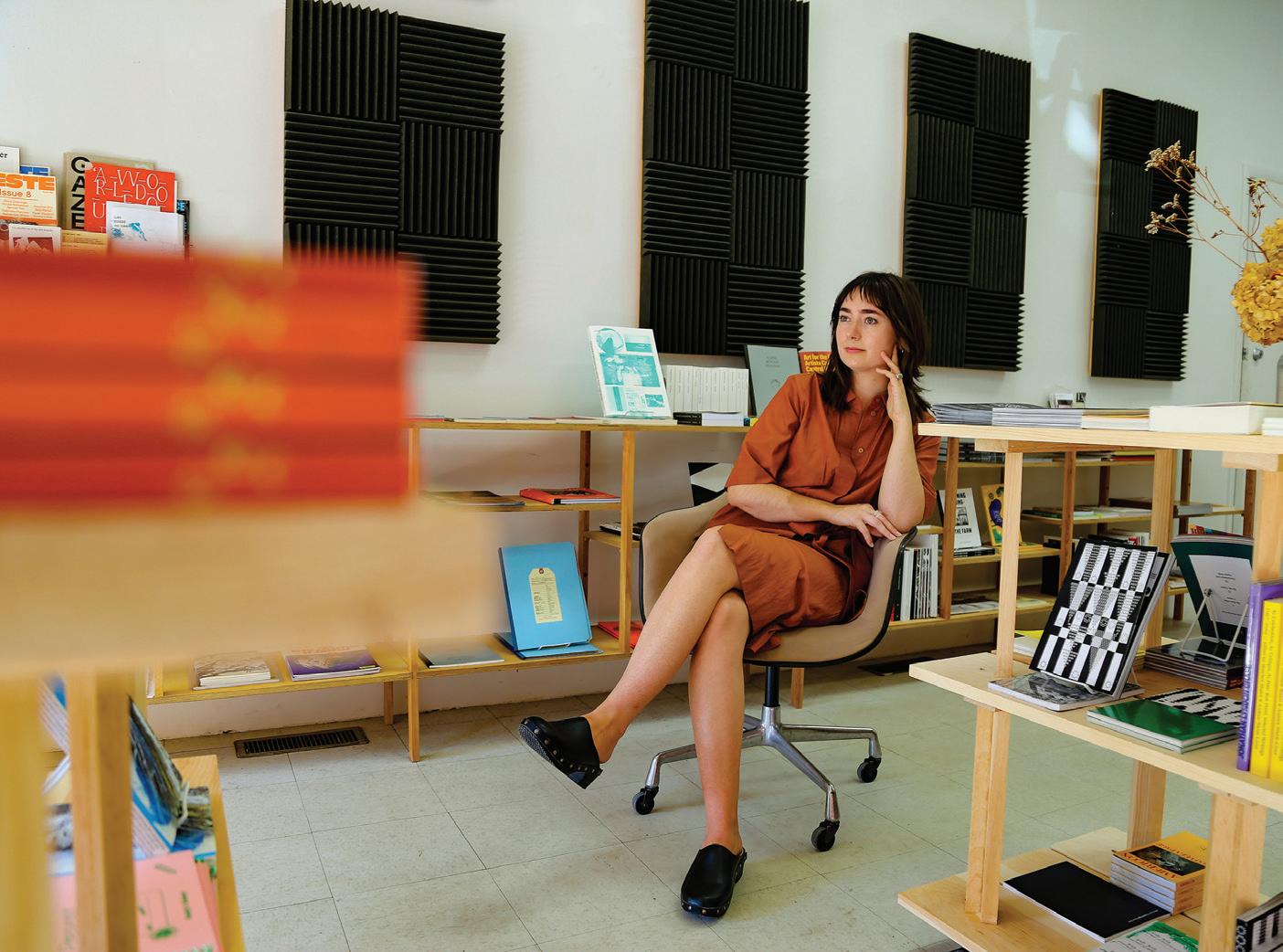
It’s time to reveal to Chicago that I’m actually a southern Californian. Please forgive me. I grew up in San Diego, and I grew up on the beach. I was a beachgoing kid and a moviegoing kid. I lived near La Paloma, which was a movie house from the 20s, a single-screen movie house. It’s still running, thankfully.
I promptly left San Diego when I was college age, went to New York, and pretty much looked nowhere else. I went to Sarah Lawrence. I started as a creative writing and philosophy major and then diverted myself to film. I think that was just because I found myself going to all the screenings after my classes were out. I was showing up for the screenings from other people’s classes, and eventually I started
44 CHICAGO READER - NOVEMBER 10, 2022 ll OLIVIA OBINEME FOR CHICAGO READER
T h e c u
r a t o r the PEOPLE
getting into the group of filmgoers and film studies students at Sarah Lawrence, which was pretty small, honestly, and similarly to philosophy, it was mainly men.
As I was graduating I came up with this plan. It was all based in starting filmfront, which we hadn’t quite named at the time, but we had myself, Alan [Medina]—who’s obviously been my partner in all things creative and in life since the very beginning of filmfront—and we wanted to work with three other people who are also close collaborators and friends and family.
It felt like in Chicago, what I understood of artists working here and people going to movies here, is that people genuinely collaborated more and there was space for that. And that really appealed to me.
Initially it was going to be a multiuse arts space, with private studios and public [space] for anything public-facing that people wanted to do. The film screenings were the portion that Alan and I wanted to contribute. I was maybe one of the only people who didn’t identify as having an individual artistic practice, but I said that’s going to be my contribution to the multiuse arts space, to do these community-oriented, free film screenings.
Alan had grown up here, mainly, and so moving back here wasn’t too challenging. He knew Chicago so well . . . [and] I’d been visiting him and his family for holidays and stu like that, in Pilsen, specifically, for a handful of years at that point. And we would always have trouble finding a place to go see movies when we were here. Finding something local
in Pilsen was really challenging then.
[Filmfront had been going for] about five years, 2015 to 2020, when the pandemic slowed us down, and it was also my first five years in Chicago, so it was definitely the time when I was building community, being part of the community that was already there . . . just kind of reaching into these relationships, developing partnerships year by year, and they would always happen really organically.
When I look back on it, it’s so much a quilt of relationships and some of the most incredible times. Some of my greatest joys are found in conversation, in a room of people who are open and excited about something. I feel like cinema is the perfect medium for that, and it’s what we try to do: unassumingly open up space for people to share whatever they are thinking, to work together toward thinking through ideas, to challenge one another in a way that’s never based on someone’s credentials or how many films they’ve seen. None of that really matters. Or at least we tried in as many ways as we could to decenter that type of value system.
One of the specific blessings to be able to work for the Block is that it’s a space that’s also based in valuing free film screenings, so a lot of the values between filmfront and the Block Museum were transferable, and I think that felt like a natural fit when I was moving into that space.
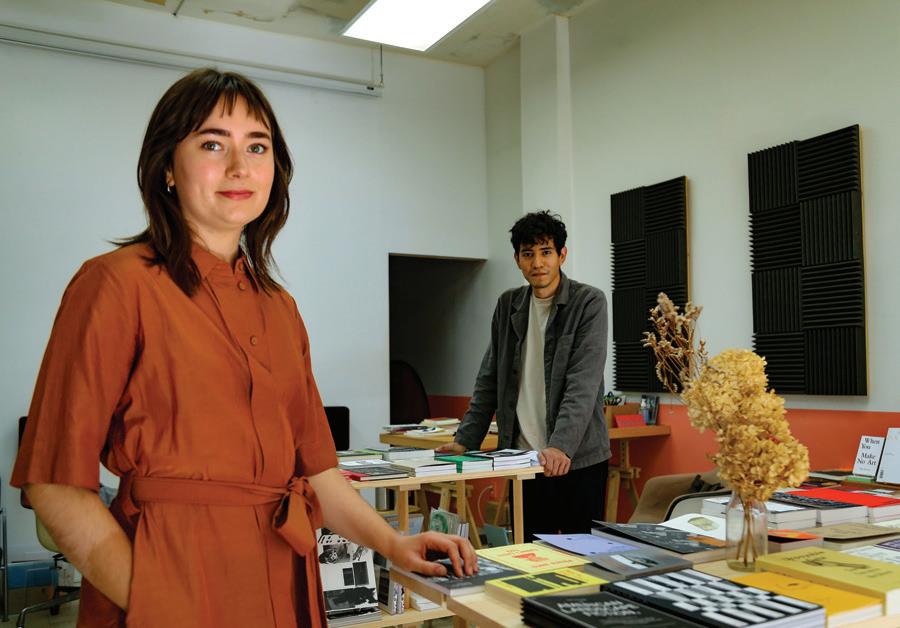
Inga’s another partnership with Alan, myself, and Jacob Lingdren, who is a close friend of ours and a collaborator—he’s done a
filmfront screening and we’ve done books together before—but we owe that to the Chicago Art Book Fair. We met through mutual friends in publishing who said that we should check out each other’s tables, and we just started chatting it up. We ended up . . . talking about how incredible it was to see what the Chicago Art Book Fair could create in terms of interest and community and reflecting on the vibrancy of Chicago’s response to that.
But then seeing how the books just come and go and how there’s no actual stable space throughout the year to go and see all these things or connect with all these publishers. That just seemed like a blatant shame, because there’s so much desire for it in Chicago. And there are so many people in Chicago producing books that are so cool and so interesting, and we imagined what the bookstore would look like. Since we already had filmfront as a space and had always seen it as a flexible space, we decided to move it in and started small and grew and grew. It’s still small, by many measures, but we have over a thousand books.
We built all these relationships with small publishers, we found out how networks of distribution were happening or not working in their favor, and pretty much through those relationships amassed all these books, and then started positioning them in front of people in a way that felt a little unconventional, too, but was hopefully very open and accessible, so it wouldn’t feel like there’s anything exclusive about the art book world in the same way that filmfront has that desire to not have some-
thing exclusive about entering a film space, which can be intimidating for people.
I’ve always seen that, if you’re not necessarily entering it from an academic background, if you’re not necessarily entering it from a hardcore cinephile background, or bibliophile background, then where’s the space that’s open to everyone else? And I guess I hope that both of the projects meet people in those areas. Pairing different models to hopefully support one another has always been something that we hope will work in supporting both but also to create dialogue across them. I think there are relationships between books and movies. I also just love them both. It’s kind of where I found myself. It’s not exclusively film related, but it’s definitely an interrelated journey. I’ve worked at many bookstores . . . books and film have always been my nodes of career.
I see now, having had a certain number of years under my belt of living in the city, of knowing what I know about filmgoing, about community gathering around di erent types of art, and how I see these amazing layers of the film community in the exhibition spaces but also the artists producing work and then the people who are just insatiably excited about all that happens here, all that compounds to make this really rich soil that we exist in. So much could happen in Chicago and so much could happen potentially in this space. v
NOVEMBER 10, 2022 - CHICAGO READER 45
@Chicago_Reader
“
I think there are relationships between books and movies. I also just love them both. It’s kind of where I found myself.
— Malia Haines-Stewart
Malia Haines-Stewart and Alan Medina OLIVIA OBINEME FOR CHICAGO READER
Julia Needlman
the PEOPLE issue
Interview by KATIE PROUT
Photos by Lloyd DeGrane
J ulia Needlman does nothing without intention. The dressmaker lives and works in the Polish Triangle two-flat she shares with cats Okuma and Diana (“the goddess, not the princess”), her kilt-wearing husband Hal (“my Viking”), who carved the wooden chair I sit in, and her nonagenarian Jewish parents (“My joke about God is I never wanted kids and he sent me two elderly teenagers”), who live in the apartment upstairs.
And then, there are the brides: brides on their first marriage, brides on their third, queer brides, fat brides, brides who just discovered they are pregnant, brides who are in mourning for a loved one who won’t live to see their wedding, brides who never really thought of themselves as brides at all. Before I ever met Julia, I’d heard about her. One friend who took her wedding dress to her for alterations called Julia a fairy godmother. Another described her as a practical oracle. “You need to talk to her,” they told me, “trust us,” so I do.
They all come to Julia’s front door buffeted

by profound upheaval. At first, I thought of her place as a port in that storm, but sitting at her table in a witchy black dress she made herself, Okuma happily crunching treats from a china bowl on top of it, Julia explained to me why her home and studio is not a refuge, but a terminus, a powerful portal for change.
There’s an old tradition of door magic which lots of people don’t follow anymore. Doors and windows are magical in-between places. When you come in, you don’t have to go out the same way. It’s that simple. You can go out changed.
When people come in here, I want them to feel the possibility of new openings before they leave. They should feel secure about who they are as human beings, and more comfortable about all those choices that they’re making, because bridal is all about making choices and seeing yourself.

46 CHICAGO READER - NOVEMBER 10, 2022 ll LLOYD DEGRANE FOR CHICAGO READER
T h e t a i l o r
Thirty years ago, I made a mom’s wedding dress into a daughter’s. After all these years, her daughter is getting married and sent me a note saying, “Can we make it work for me?” She comes next week. That’s the first three generations, same dress modified, and the first modification was quite something. “You’ve been wanting this for a very long time,” I thought. I think I’ve made it, in some esoteric way.

I really have two jobs: one I get paid for and one I don’t. One is to sew for people, which I do all the time and that’s lovely. And the other one is to support the women that I’m meeting to feel more whole in their lives because I can. I support through conversation: I do things like talk about bras, because women don’t— no, because no one teaches you about how bras work. Bras work in very specific ways. You’re taught if you keep it tensioned across your boobs that you’re getting support, and this is a lie.
Here’s the thing: boobs sit on a ribcage. The shape of the cage gives you some support or not, depending on the shape of you. The size is less important. See, I think you have a cage that’s sitting here— Julia motioned to my ribcage with a gesture that was both high and wide—so you’re getting a little bit of support all the time. That’s why you’re not wearing a bra. You wanna test it?
Sure.
Wait, wait. Sit up straight, take your hands to the side, shove them under your boobs and push up.
I don’t usually grope my breasts in front of a subject five minutes into our first interview, but the promise of finally understanding bras, which have remained mysterious to me throughout my 35 years of life, is powerful. Obediently, I do as she directs. Julia gazes at me critically, thoughtfully, but without judgment.
Do you feel a di erence in your shoulders?
Not at all, I feel fine both ways, I say. Julia sits back, triumphant.
That’s how we know. You feel fine because there’s a cage in there. You got a real rib cage on ya! It’s kind of cool, because each person has their own story. You can be in control by looking at your body and owning who you are. You choose. And I like that.
Not wearing bras can be a political statement, but for me, it’s about comfort. I explain to Julia that I understand it might stress my boyfriend’s parents out if my nipples are poking out, so I can wear one then, I suppose, but—
Well, nipples are a di erent issue, because nipples are about bringing focus to your breasts. Politics says you refuse to believe people are looking [laughs], which is really irritating because people are looking! You make
a choice about what they get to see, for you. That’s all. You get to choose.
I trained in theater: my degree is in play directing and costume design. The problem with being a director is it’s a father figure, and I’m a little woman, so everyone thought I was going to be a nurturing mother figure. But I’m not. I’m the father figure. Once, I was working on costumes for a show. I walked in, and all the actors are sitting in rehearsal in the room, and they’re all smoking. I was pissed. I’m like, “You’re wrecking your tools before you even started?” There I was, a fat, young, Jewish woman saying, “Don’t smoke because you want to use those tools, and you’re wrecking them.”
To be a director, you have to understand it’s an approval position, the father figure, not the nurturing position, the mother figure. I do both. I know both. I love both. However, in the end, when you’re creating a piece of art, that’s when you need the critical aspect.
I’ve rather strong energy. So if you’re not liking that, that’s okay. Sometimes, someone comes in with a dress, and I really can’t connect to them. And I understand that they don’t need who I am. That’s when I say, “Then we really shouldn’t do this, because I can tell we’re not hearing each other, and that’s not good.” The free consultation is for me, too. If you’re going to open someone’s wedding dress, you better be really ready to recognize when they’re going.
But if I do my job right, the wedding dress you’re wearing becomes secondary. If someone walks in and says, “That’s a fabulous dress!” I screwed up, something’s wrong. They should say, “You look amazing.” And then they can recognize the dress if you’re lucky, or if they have an eye for that sort of thing.
Last night, I was sewing up sleeves and putting them on a bodice. This is one of the projects that was ten hours. As I’m doing that, I’m going, “You’re nuts. What are you doing?”
And the answer is: I’m doing what no one else can do.
Julia loves to give assignments. This instinct is part of that second job she mentioned, the one where she supports her clients to feel whole. She’s very serious about the assignments: having opened her business in 1981, Julia has spent over 40 years watching how people process wedding planning. “The cool thing about weddings is you’ve made this decision to change your life!” she told me. “But now what?”
Assignment number one—which would be really interesting for you to sit down and do with your guy—is to make a list of who needs to be there for you to feel married. Don’t lie, and don’t show anyone else, because it doesn’t always include all the parents or the cousins. It’s about who really needs to be there for you to feel married. And if it’s just the two of you, that’s a good piece of information. But mostly, there are a couple more people in your life. Some people need their whole families because that’s their nature. They’re not kidding.
There’s pressure from outside of you to make certain kinds of fantasies about this ritual, like how big it has to be and who has to be included. And it’s a negotiation and it is complicated. And it’s complicated by your parents’ vision of what it was supposed to be, about money, by what you can handle in terms of your own needs and desires. That’s really normal. So the first thing you have to know is what scale you really want, and then you fight for it, the two of you.
My husband, Hal, was given to me. I told God on a Yom Kippur, “God, I have been married, it was a disaster. I’ve had many lovers, men and women, I’ve had this whole life, I’m going to be a fat, single Jewish woman with cats. I’m gonna do it so well that no one thinks, ‘Oh, that poor thing.’ They’re gonna say, ‘I want her life.’” And God laughed at me and sent me
a husband.
Within days, this man I knew called me up and said, “I want to come and see you in Chicago.” And I’m like, “Sure, come!” He’s like, “No, no, I want to see if you want to have a relationship.” I said, “Sure, come ahead,” and then he never left. That was 25 years ago. I heard God laughing at me. I knew that it was a lesson I had to figure out.
It was very hard to give up being single. And I had a lot of single women in my life. I wanted them to know that single was OK, that the dance is the dance. In my case, I just felt the rightness of it. At the same time, it’s not any less work. You are always 100 percent responsible for your life. And if you go into marriage thinking, “I bring my 50, he brings his 50, we’re covered,” you’re wrong. You are still fully responsible for your joy, your growth, and your happiness. The way you’re going to be as a human being is always your job.
My wedding dress, ohhhh, it was lavender, and it was brocade, and had buttons down the front, because being my own self-person, I wasn’t willing to let anyone button me up the back. There were four pieces of fabric I bought before I finally dyed one that was the right color for me. And I took all these beautiful stones and I wired them into a crown.
When people come in, I ask them, “Is this a religious ceremony?” That answer can open a perfect can of worms, but the answer is, it’s a magical ritual. And it imbues in it all the power and energy you as a human being have decided to give.
Religious or not, please, don’t leave out the magic. It’s your own magic. There is all this amazing magic in what you believe and feel, and the subtleties of it, and how you understand each other. And it’s amazing. And that’s what you want—at least one or two moments that remind you that you are in this story. v
NOVEMBER 10, 2022 - CHICAGO READER 47
@katie_prout
Julia Needlman has sewn wedding dresses for generations of brides. LLOYD DEGRANE FOR CHICAGO READER
Tony Trimm

“ Hannibal Buress’s DJ” is how Tony Trimm used to get pegged, but growing up in Des Plaines he showed early promise as an autodidact. Making camcorder action comedies with his brother, cooking pancakes for the family, skateboarding, graffiti art, hip-hop, and breakdancing all converged into a warped, pandemic-born vision that resulted in his ten-episode YouTube HomeFEED Show, which just wrapped last month. It’s a lysergic, postapocalyptic nightmare that enlists a small army of chefs, musicians, comics, artists, and his two chihuahuas, Chicharron and Nacho, in a cooking show produced in hell.
DJing I got into out of necessity.
I had a lot of friends that liked to freestyle rap and didn’t have beats, so I would buy a bunch of 12-inches, blend the instrumentals on the B sides, and make mixtapes.
I was always trying to make a scene in college. I had an open mike night. It’d be poets, actors, singers, mostly rappers, and I’d play beats. And then Hannibal started signing up and I was like, “Man, you’re great at this. You should just host it.”
I worked with Serengeti, fresh out of college. We toured and made music together. It

48 CHICAGO READER - NOVEMBER 10, 2022 ll EDDIE QUIÑONES FOR CHICAGO READER
the
T h e a u t e u r
PEOPLE issue
Interview by MIKE SULA
Photos by Eddie Quiñones
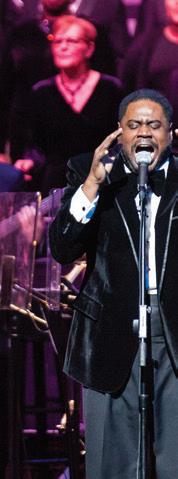




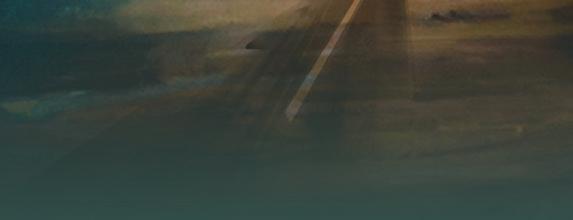
























NOVEMBER 10, 2022 - CHICAGO READER 49
AuditoriumTheatre.org 312.341.2300 2022–23 SEASON SPONSORS O cial Hotel Partner TOO HOT TO HANDEL SPONSORS Dave Samber and Darrell Windle Presenting Sponsors JLC Colmar Foundation Performance Sponsor THE AUDITORIUM THEATRE PRESENTS THE JAZZ-GOSPEL MESSIAH TOO HOt TOHANDEL DEC 3 + 4 “undeniable vocal prowess” — Chicago Defender Media Sponsor NOW PLAYING THROUGH DECEMBER 18 615 W. Wellington Avenue (at Broadway), Chicago 773.281.8463 timelinetheatre.com “[A] MASTERPIECE OF ASTONISHING POWER” – New York Magazine GENESEE THE SPOTLIGHT IS CLOSER THAN YOU THINK THE 22_004127_GEN_Chicago_Reader_Ad_NOV10_JT01Mod:October26,202212:13PMPrint:11/02/224:40:56PMpage1v7 203 NORTH GENESEE STREET, WAUKEGAN, IL BOX OFFICE HOURS: TUE – FRI 11 AM – 5:30 PM, SAT 10 AM – 3 PM TICKETMASTER: 800-982-2787 • PH: 847-263-6300 YOU WON'T WANT TO MISS THIS SHOW! GENESEETHEATRE .COM "Brick House," "Nightshift" and "Three Times a Lady" THURSDAY, FEBRUARY 16 7:30 PM
Photo
by Kristie Kahns.
wasn’t really a lucrative thing. It was just two guys, like-minded artists, just doing things together. It wasn’t really like a hustle or anything. I was basically DJing for beer money and writing raps and living in apartments with four or five roommates and partying and just being a dumb kid. I never had any ambition to dive into the real world and save money. I was always looking for the next thing to do.
I was never thinking about DJing as a thing that I wanted to pursue. I just wanted to make music and produce and do audio engineering and stu .

Hannibal started taking me on the road. He’d be like, “Will you come to Minneapolis with me? We’ll get you a flight. You got a hotel and it pays this much.” And that turned into, “Let’s do a tour.” Then we started doing the podcast and we’re getting sponsorships. He’s paying me for that and gigs. I’m like, “Oh shit, I need to start paying taxes.”
That’s pretty much where I got all of it from. Hannibal is a master of comedic timing—how to structure a joke. There’d be many sessions where we’re sitting together, editing. He’d be like, “OK, that’s a beat too late, or a beat too early.”
[I’d be] hanging out with other comics, talking backstage with them. Seeing how they crack jokes, seeing what makes them laugh, seeing what they think is corny. You just have to be around funny people. I just wanted to be with the cool kids. You learn, “I gotta be funny if I want to be around these funny people.”
I started doing visuals for Hannibal on the road as well. I would take crazy videos o the Internet, lay them over music. It became an integral part of Hannibal’s stage show. I started learning this di erent medium and getting more comfortable with it.
I was always exhausted. The road life ages you horribly. You don’t realize how crazy your life is until you get a moment’s rest. Pandemic hits, world shuts down, and then all of a sudden, “Oh man, there’s a lot of free time.”
I got all these cookbooks and I started learning how to make these really high-level dishes and getting really good at making bread and kombucha. I wanted restaurant-level food at my crib at all times. I was also making tons of fucking weed cookies, so I was getting really stoned.
It was a great time. It felt like a vacation. And then, that wears o after a while. A bunch of months go by, the drinking gets increased, you’re exercising less. I was gaining weight and feeling not the best I can be. I was in a funk.
My only companions were Chich and Nacho. I started feeling like I was in this infinite hell loop. My comprehension started getting all wonky. I started losing my mind a little bit. I
was not in a good place. And then my buddy Ted [Park] started coming around: “Dude, you gotta keep working on stuff. You got to stay creative.” I didn’t want to hear that shit. It’s fucking hard be creative when you’re in a dark place.
He asked me: “What would you want to do right now?” I was like, “I’ve been cooking a lot. I would do a cooking show.” I was already experimenting with Chich. She loves to hang out in the kitchen while I cook, and I would pan over to her and she’d be staring at me and I would have a conversation with her. And it seemed like she was responding. It was a funny premise: “I’ll do a cooking show, about this guy losing his mind talking to his dog.”
He’s like, “Dope. You should do it. I’ll produce it.” “OK, well, I need lights. I need the camera and a new mike.” He gave me his credit card, bought it all. I still wasn’t inspired to do it, but he just spent all this money. “If I don’t do this, I’m a piece of shit.”
The one thing that I wanted to avoid as much as possible was to make just another cooking show. It had to be funny. I had all these loose, crazy ideas that didn’t completely gel: “Wouldn’t it be funny if I had this recipe with eggs and I gotta fight a chicken to get the eggs?” If I wanted something in the freezer I’d have to go in and fight a yeti. I wanted these things to move in animation. I wanted the deepfake stuff. I wanted these colors. I just kept trying new things until they all stuck.
It was originally supposed to just be a proof of concept, and we were going to pitch it. Our plan was to make a production company, release these episodes. Ted was gonna find the funding. And then he just mysteriously dies. It was a weird heart failure thing. It was a two-man team at the time. I was super fucking bummed. That’s when I started wormholing into editing because I gotta get this done for
him.
It became super low budget, just about being resourceful. I’d show it to people and they were excited. They started coming on board and I started building this ragtag team of people that have random skills like, “Yeah, I could do makeup.” “Yeah, I could do prosthetics.” People started coming together and we formed this collective.
I make sure that they’re fed, they’re taken care of, they get their proper credits, and everybody’s happy with what they’re making. Our mantra is that no matter what, every episode has to be better than the last one. It has to be significant improvements in anything from sound, color, Steadicam work, acting, directing, writing.
One of the biggest lessons I learned is people constantly were saying that it cannot be done: “You need money. You need the processing power.” But it’s all bullshit. If you have a vision and you lock in, you can get it done. I’m like, “Fuck it. I’ll wake up every morning, and learn at least one thing every day.”
So the story of this character—just “Trimm”—is that he’s a clone. I’d be obsessed with the character. I write a lot of backstory, and I obsessively kind of build the world around him. But a lot of things I haven’t written down. It’s all in my head. So I’m like, “Only I can play this.” In a perfect world, I would like to just direct and have someone else play that character.
Cooking has always been there. Acting, editing, writing—these were all things that were new. But when I started doing it it just felt really natural and easy. Except for the editing. Editing was really di cult. But it’s just figuring out technology. I could see how it’s supposed to look and I know how it’s supposed to feel. I think if you have that, then everything else kind of comes naturally.
I hated explaining, “I’m working on a cooking show.” I’m like, “Ah, it’s not really a cooking show. It’s kind of sci-fi. It’s a little horror, but there’s comedy. And there’s these dogs . . .” Some French lady on Twitter randomly was like: “psychotronic cooking show.” “What the fuck does that mean?” So then I went online and I wormholed psychotronic cinema, and, “Oh, yeah, that’s exactly what we do. That’s what we’re gonna call it now.” Before that there was no definition of it.
I basically took a year off. I haven’t been working. I’ve been bleeding money on this project. Season two is going to be only if we can get proper funding, because I can’t a ord to do this again. I want to pay these people so we can all focus on this one thing and make it better than ever. I want this show to do well, so I can retire from DJing. I’d rather shoot at locations. I’d rather direct. I’d rather write. I feel like this is my calling now.
I enjoyed the raps, bringing the joy of everything I used to love back out again. So that’s why it’s very special to me, because it’s like, “Oh, yeah, that’s why I love doing this. This is why I used to do this.”
The past year has been very intense. I wake up at 6 AM and I’m working till 6 PM. There’s, like, no time for anything. Eating like garbage. I gotta get my personal life together. I want to start exercising again, get back into martial arts. Meditate, eat better, walk the dogs more. I need to get my life together because I don’t do shit anymore for myself.
All my friends that have been in the game are like, “You’re gonna have to get out there and talk to people. You have to sell it. You’re gonna have to enter stu in festivals. Yeah, it sucks, but it’s necessary. Nothing’s just gonna come to you.” v
@MikeSula
50 CHICAGO READER - NOVEMBER 10, 2022 ll
“
If you have a vision and you lock in, you can get it done.
—Tony Trimm
continued from 48
Tony Trimm makes a “psychotronic cooking show.” EDDIE QUIÑONES FOR CHICAGO READER


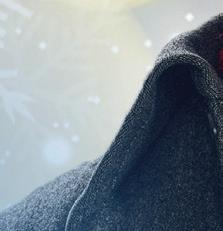
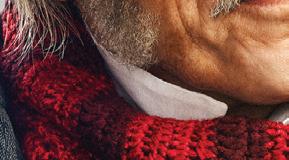




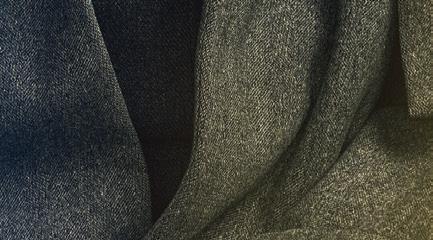






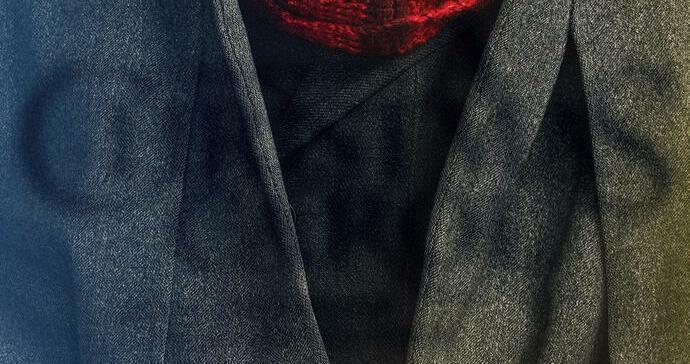
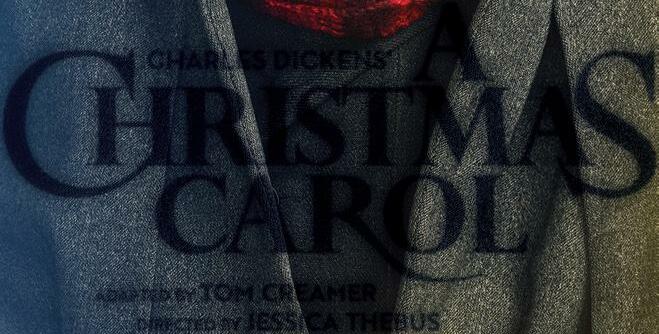










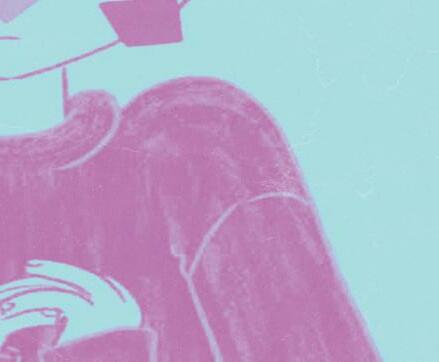



































































































NOVEMBER 10, 2022 - CHICAGO READER 51 312.443.3800 | GoodmanTheatre.org Groups of 15+: Groups@GoodmanTheatre.org Corporate Sponsor Partner Major Corporate Sponsor NOVEMBER 19 – DECEMBER 31 FAMILY movienight Favorites UNEXPECTED UNEXPECTED UNEXPECTED UNEXPECTED N O V E M B E R 4 - 2 0 , 2 0 2 2 CHICAGO INTERNATIONAL CHILDREN'S FILM FESTIVAL 39th facets 1517 W Fullerton Ave, Chicago FEATURED FILM: CHITCHAT BUY YOUR FESTIVAL PASS TODAY! CICFF39.EVENTIVE.ORG WATCH ANIMATION, LIVE-ACTION, & DOCUMENTARY FILMS FOR AGES 2-25 AT CICFF39. movie night FIND UN CTED UN CTED EXP EXP FACETS PRESENTS CICFF39 ages 2-25
h e
h a m p i o n the PEOPLE issue
Karla Estela Rivera
by KERRY REID
In late September, writer-educator-activist-podcaster Karla Estela Rivera became the first executive director of Arts Administrators of Color (AAC), a service organization that advocates for BIPOC artists and administrators, after serving for three years as the executive director for Free Street. (She began collaborating with Free Street in 2012.) Born in Puerto Rico and raised largely in Albany Park, Rivera has been challenging authority from an early age.
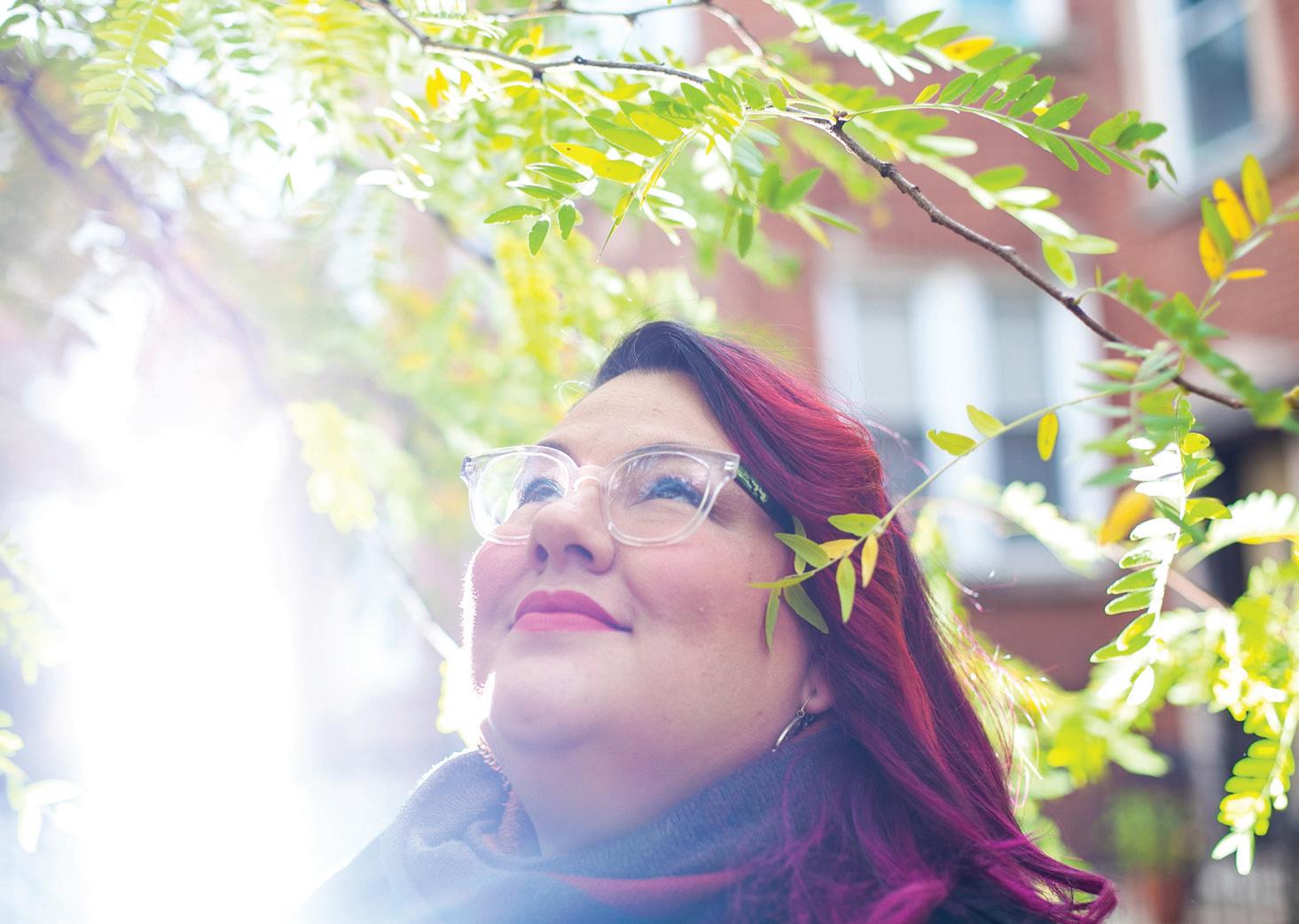
You know, the science fair was always a pain in the ass. In an ideal world, you get help from your parents. So they’re social scientists, so they’re like, “Well, why don’t you do a social experiment?”
My first science fair project was about TV’s influence on homework. And so I sent kids home with surveys about what kind of grades they got and how much TV they consumed. That did really well. And then there was a whole other one I did about divorce and its impact on kids. And then my eighth-grade teacher was like, “You can’t do any more social experiments.” Because she said it wasn’t real science. And so my eighth-grade science fair project was
52 CHICAGO READER - NOVEMBER 10, 2022 ll EDDIE QUIÑONES FOR CHICAGO READER
T
c
Interview
Photos by Eddie Quiñones
on “Are the social sciences real sciences?” I surveyed all of the teachers in the school.
I went to [University of Illinois Urbana-Champaign] for a little bit. Hated it. ’Cause I’m a city kid. From a really young age, I was told, “This is your city. This is your backyard.” As soon as I could get on the train by myself, I was going to the train by myself. And I feel like there was a lot more opportunity back then— this is the 90s—for this inter-neighborhood city exploration conversation.
Maybe this is my own experience, but I went to Sayre Language Academy on the near west side. Kids from all over the city were going there. If there was a birthday party in Austin, I was going to that birthday party in Austin, you know? And so I had always seen the city as my city. No matter where I live.
Since I was a kid, I’ve always been a storyteller. Always. My grandmother was a self-published poet and writer. And her autobiography is the only text that exists as the firsthand account of the generation of Puerto Ricans before my parents. It is all about her growing up in rural Puerto Rico. And then it ends with her being on the boat, coming to New York. She had a seventh-grade education, worked in factories, all of that. But then after she stopped working, I just always saw her writing on legal pads. At family reunions and stuff, she would recite her poetry and all of
that. So that’s always been a through line for me. And then when she passed, I wrote my first play.
I studied journalism. This won’t come as a surprise, but you know, the arts economy being what it is, I don’t think that my family doubted that I had talent, but they were like, “We have no money to support you chasing
your dream.” So I started at Gallery 37. I was one of the OG Gallery 37 kids. I did playwriting with Pegasus Theatre. Second year I did the New Expression journalism track. And I just stayed. I caught a lot just going downtown, being in the Cultural Center, people watching.
I went to grad school at NYU for a bit. And it was a very dark time. I was in the dramatic writing program. I realized how regular I was. There was an elitism that existed amongst the cohort and there was already, like, cutthroatness happening and the overintellectualization of work. And I had just spent ten years working in dive bars, you know? I think all the good stories come from real human beings. No one with airs about themselves—just heart. And what I found at NYU was a lot of head and very little heart. I think there was a vision I had of living in New York that was informed by being rugged and living poor. But none of the kids at NYU were living poor. Very few of them came from poor or struggling backgrounds.
I became a teaching artist. I did a program called Project Playwright where we went into schools in rural Vermont, New Hampshire. I taught playwriting to sixth graders. But it changed my life because it was there that I was like, “Oh, I can utilize this.” Coming from educators, I really gravitated towards it and I was good at it. I came back here and taught theater at the Puerto Rican Cultural Center and I
became a company member of UrbanTheater Company. And then I got pregnant. [Rivera’s husband, Ramon Charriez, is a member of Latinx sketch troupe Salsation!] I was trying to find my space in the ecosystem. So I went into nonprofit [management].
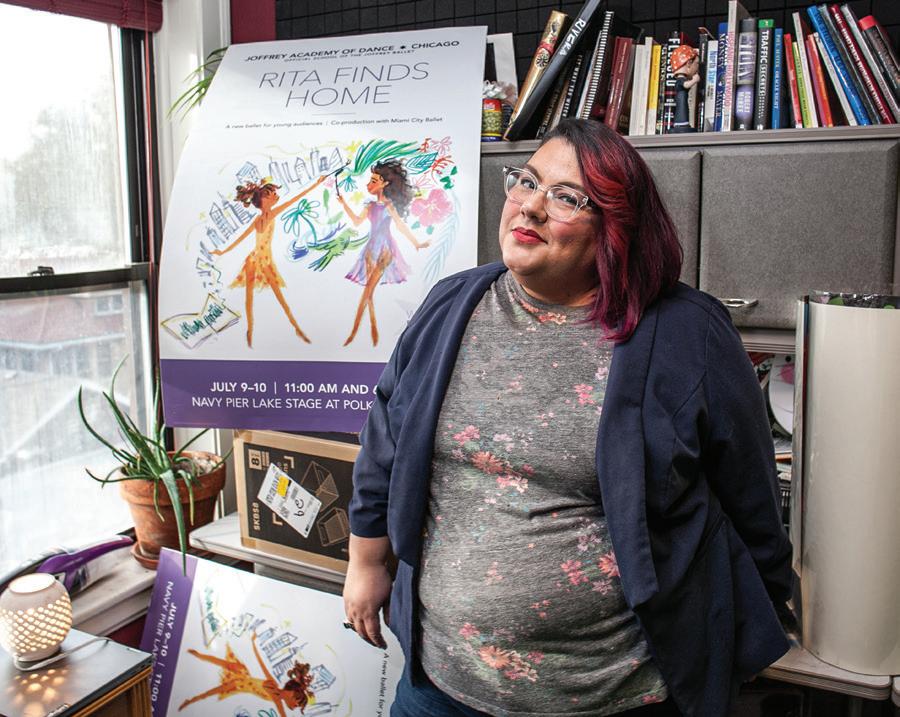
This whole time I knew about Coya [Paz] through the theater world. We were like passing ships. When she became artistic director of Free Street, she began to have these conversations with folks across communities about what Free Street could be. And I was at the first meeting. She invited me and I was like, “Well, I’ve got a baby.” I had been kind of systematically handled or pushed out in some previous situation because I was like, “You have to accommodate my kid,” or “You have to deal with my new timeline and schedule.” She was like, “Bring the baby.”
I had found this group of folks that were multihyphen. They were out in community, they were social workers, they were teachers, they were artists. In my soul, I had always pushed against this notion that you had to be one thing. ’Cause I was never one thing. I mean, some people find their vocation right away, and God bless them. Like, that’s their jam. But I just always knew I wanted to be artistic, I wanted to make an impact, I wanted to be involved in social change, however that came out in the wash.
One of the reasons why I was attracted to AAC—and I’ve been a part of their programming for the last three or four years—was because of a situation at a previous job. I looked great on paper. But I was not allowed to do the things that I very much felt needed to be done from an organizing and an advocacy standpoint. And I wasn’t trusted.
We have a Facebook group that’s made up of just all folks of the global majority. “Anybody ready to leave the field? How can we help support you regardless if you leave or stay?” And these are folks across the country desiring a larger salary and more time for their art and family. So work-life balance, pay equity. You know, financial stability is a whole thing. People are already planning their exit strategies from the sector. “I’m so tired and frustrated by five point five years of patronizing disrespect and disdain from outside majoritarian stakeholders who think I am dumb and a waste of space, and that the communities I want to enlist and empower are meaningless.” This work is exhausting and [AAC] is one of the spaces that recognizes that. And I think, particular to the arts—this is our vocation. And I think there are very few, if any, career fields where you have a deep passion and connection to the work, and you are asked to settle for less consistently. v
NOVEMBER 10, 2022 - CHICAGO READER 53
@kerryreid
“
I think all the good stories come from real human beings. No one with airs about themselves— just heart.
—Karla Estela Rivera
Karla Estela Rivera was raised primarily in Albany Park. EDDIE QUIÑONES FOR CHICAGO READER
the PEOPLE issue Wildcat Shadow
Interview by MICCO CAPORALE Photos by Eddie Quiñones
Wildcat Shadow is the rubber-clad feline leading you to your darkest desires. After moving to Chicago in 2010, the now 30-year-old kink performer and musician joined the queer nightlife scene, where he found new ways to use his talent for creating immersive experiences while inspiring people to realize their dreams. By night he’s a leader in the fetish community, particularly known for his role in the puppy play scene. He’s appeared in short films and music videos and been paid to host international parties. By day he’s a consultant on stress education, helping workplaces and schools develop trauma-informed, anti-racist projects and curricula. He also teaches dating and relationship skills to young people.
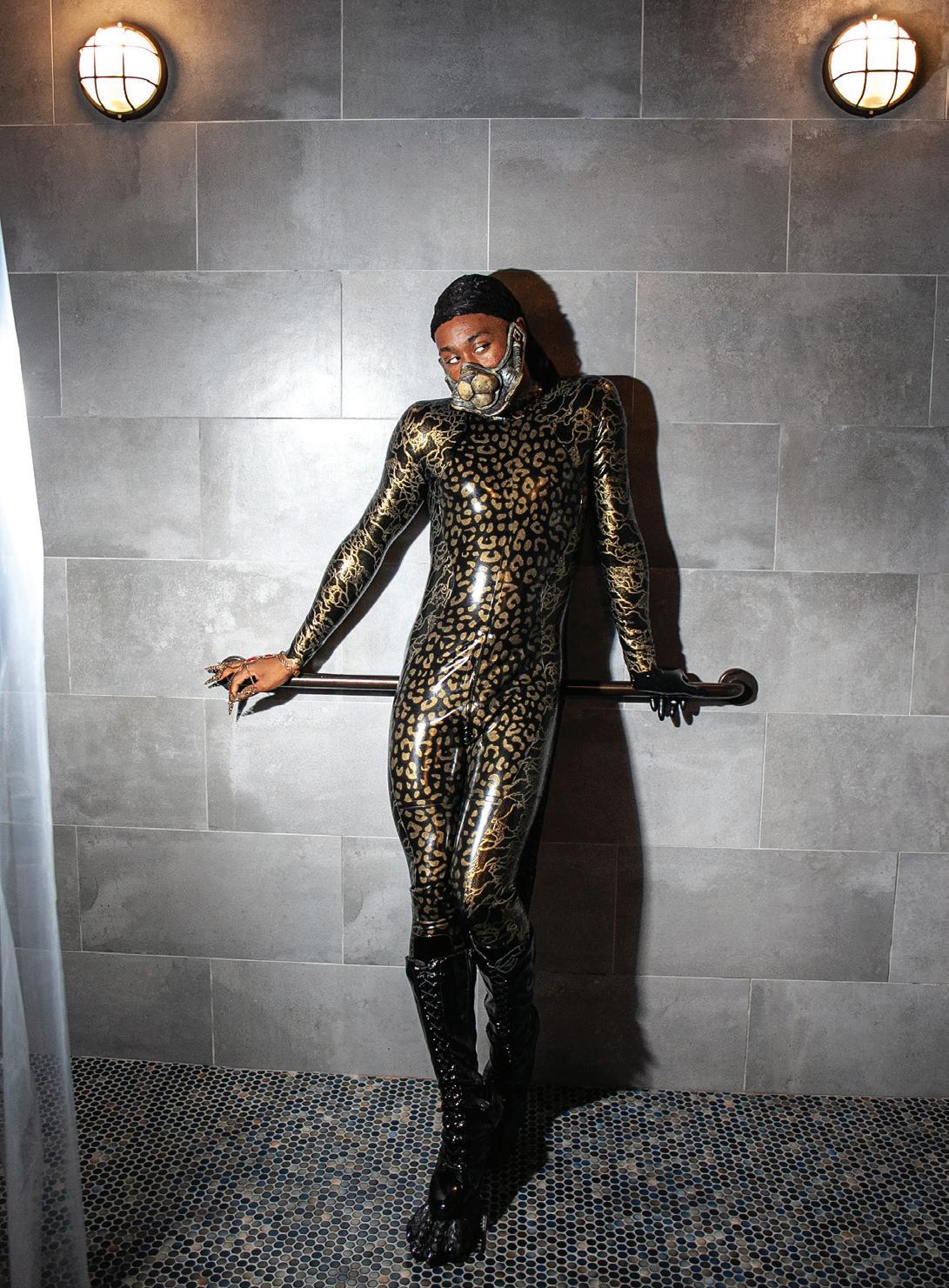
Igrew up attending an arts school. I used to come to Chicago for drum corps competitions and tours. They call it drum corps, but the full term is drum and bugle corps. It’s a specific military marching band culture that uses just drums and horns. Instead of blindly following orders to enact war and advance colonialism, though, it’s to put on a big show. I don’t like the military. It’s very deplorable to me. But if there’s one thing we can’t deny, it’s the military’s precision and discipline. Those tools are very attractive to me, and I think that’s something beautiful that I carry into my creative practice now.
I did both drum corps and marching band for almost ten years as extracurriculars. In school, I pursued symphony and jazz. Making

T h e k i n k p e r f o r m e r
54 CHICAGO READER - NOVEMBER 10, 2022 ll
QUIÑONES FOR CHICAGO READER
EDDIE
music as a group is one of the most fascinating feats of social engineering to me because it brings all these people together to do something really demanding simultaneously. Like in a band or symphony, there’s a conductor, and that conductor tells you when to start, how fast to go. They lead the group through this real-time experience of what the composer wrote. I think about that experience and those power dynamics a lot.
My school was very artsy, but it wasn’t until my adult life, when I was doing less music, that I got interested in performing. Wildcat Shadow is based in the fetish community, but it’s informed by that early musical wisdom of leadership, discipline, atmosphere, and showmanship. Everyone has a role.
I was underage when I started in the kink scene. I started as a bondage model, which I found through the burlesque world in Colorado. That quickly came to include Chicago, too, because I was traveling here a lot for band. I would go to conferences and pass out flyers or do these live demos where they would rope you in front of a crowd. I think a lot of people’s early experiences with kink are about exploring their identity and sexuality. For me, I was exclusively trying to pay bills. I really hated it at first. Like I just thought it was weird. I had a fake ID and was living multiple lives. But there was a moment when I was doing International Mr. Leather here in Chicago that changed things for me.
I had a really bad experience with my then employer, and I quit on the spot. I was panicking because my family thought I was at band camp, and the company was holding onto my train ticket home. I was sitting in the hotel lobby, and this guy came over to me. He gently tapped me on the shoulder and was like, “Hey,
I sensed maybe you could use someone to check in on you.” And I turn around, and this guy—he’s gorgeous and so nice. He introduces himself. And he turns out to be the founder of a Black kink fraternity called Onyx. They were started here in Illinois, and now they’re international. He invited me to one of their gatherings.
So I go and I see all these people, mostly Black but also a few Brown folks. They’re all decked out in the coolest outfits and having a really nice time together. It was the first time I saw a concentration of people of color in kink, and I was like, “Oh, this is a group. And this is, like, the point of the group.” I started to look at the whole BDSM scene di erently. The founder had a really cool name and outfit, and I was like, “Wow, I want that, too!” Before then I had never looked at a piece of leather and thought, “I want to wear a harness.” Like, the kinksters I’d met were basically on vacation at conventions where I was working, and my job was to wear a harness as part of making a great vacation for them.
The aesthetics at this Onyx party just got me, though. I’m an artsy nerd. I grew up going to anime and cosplay conventions, and suddenly I saw all these people who looked like superheroes and supervillains and stu —not like the traditional leather look, which I wasn’t into. Eventually I was able to get my stu and my train ticket from my ex-employer, but I left that party feeling very inspired.
The first person to actually explain BDSM to me was a Black bisexual woman who I call Daddy. So from the beginning, there was always a complication and queerness that’s not true of everyone’s experience with the scene. I’m very lucky that Black bisexual people taught me what I know. After I moved here for
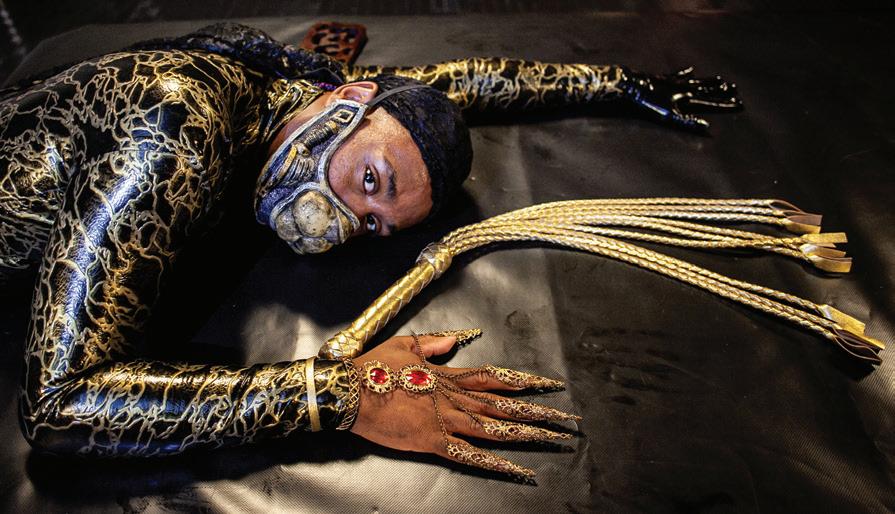
college, that woman adopted and trained me.
One of my favorite things about queerness is feeling a sense of authorship over my life. I learned how to be multiple people in di erent spaces. I’m the same person no matter where I go, but I’m always calling on di erent pieces of myself. That separation is very important. Sometimes I work with young people, and I don’t need to talk about the fact that, say, on a Friday night, I was doing bondage scenes. It’s not relevant. I do that stu as Wildcat Shadow. That separate naming isn’t about escaping something; it’s about world-building.
I’ve been into role-playing since I was a kid, so I see this as an evolution of that. I’d play role-play games in the elementary school library. I remember going from being a wizard to an owl. For a long time, I was really into elves and demons.
I started using the name Wildcat Shadow in 2014, when I discovered pet play. I had seen it before, but I didn’t understand it till then. I saw puppy play and was like, “Oh, that’s kind of cool.” I tried to imagine myself as a puppy— like a submissive dog—but that didn’t fit my personality at all. As I learned more, I saw the pup handler interactions—like the guy telling the puppy he’s a good boy and all that—and I was like, “Oh, that’s really cute.” And then I had an aha moment, like, “Wow, this is about understanding how people work and getting them to do the things they need to do but with some help.”
I realized I wanted to be a handler, but I didn’t want to be, like, the classic leather daddy with a puppy. That’s boring. At the time, I was looking at a lot of Tumblr, and I saw this Teen Titans reference where the character Raven was using her dark magic powers to put this telekinetic leash over Beast Boy. I was like,
“That’s so fierce. I want to be a dark, badass character and have a pet.” Eventually I settled on being a cat because they can kind of look like owls but also be sort of demonic.
My friends and I joke that what I do is drag. There are a lot of similarities: We might be in the same shows, move our bodies in similar ways, wear crazy shoes and outfits and nails and things—but it’s for a different illusion. I was never interested in using my body to hyper-explore gender, but I like the idea of exploring personas.
Gender can be really basic and silly, but in real life, it’s really complicated. And animals are like that, too. Being a cat helps me explore those complicated parts of myself. I tend to have a very stoic demeanor. I’m that person who’s just rolling my eyes and quietly plotting and scheming—all of these elements that we have fun associating with the evil of cats. I’m an evil cat who disciplines people and dogs. I find it very exciting.
As Wildcat Shadow, I guide others through feelings and experiences. In a theatrical sense, it’s like, “Oh, there’s this evil person who’s gonna beat you or massage you or whatever.” But the actual experience is somatic and rooted in creating a sense of belonging, of being cared for. When I was younger, I liked when someone watched over me and knew how to direct me to accomplish my goals. I like giving that to people in return now. I can create that sense of value. Now I’m interested in becoming a therapist, but when I think about my art-making and BDSM, it really comes down to: I’ve experienced the power of feeling like I belong and have a very specific purpose. I want to help others feel that, too. v
NOVEMBER 10, 2022 - CHICAGO READER 55
@JuggaloReporter
“
I’m an evil cat who disciplines people and dogs. I find it very exciting.
—Wildcat Shadow
Wildcat Shadow is a social worker and audio artist living his best life.
EDDIE QUIÑONES FOR CHICAGO READER
the PEOPLE issue
By ENRIQUE LIMÓN
“Mama” Gloria Allen
There to present “Mama” Gloria Allen with a special “living legend” distinction during 2014’s Trans 100 Awards, Pose executive producer Janet Mock expressed her admiration toward her fellow trans rights activist to a packed house inside Rogers Park’s Mayne Stage.

“‘Legendary’ is a beautiful word,” Mock said. “It’s actually one of those that is one of my favorites, but I think that we throw it around with such regularity and carelessness, that we forget its significance and its gravitas and what it denotes. But tonight, we will set the record straight, and you will see what legendary truly looks like. Legendary looks like the gorgeous, the generous, the resilient, the luminous, the brilliant, the loving, the one and only Gloria Allen,” she continued. “You stand in the presence of a legend,” she added, prompting guests to rise from their chairs and erupt in thunderous applause.
Mock then introduced homegrown diversity advocate Precious Brady-Davis, who lauded Allen for being “an amazing role model and mentor” through her sui generis charm school, which o ered real-life survival skills for homeless and at-risk transgender youth, and earned her the maternal moniker along the way. “Through the teachings of how to navigate the many systems that we all are a part of, she has given tools to the next generation that will last a lifetime,” Brady-Davis said. “This woman’s grace, passion, and dedication is legendary in
a time when history needs a beacon of light most.”
At the mic, tearful, and pushing back a lump in her throat, the ever humble woman of the hour took a beat to gather her thoughts before admitting she was “loving every minute of it,” igniting a wave of laughter from the audience.
“I’m accepting this award for all the girls that taught me and guided me through life,” Allen said, honoring the influences that perished along the way, “and they might not be here today, but they’re here in my heart, and I’m accepting it for them, as well as the youth, too.”
Still visibly moved, Allen then thanked everyone in attendance. “And I thank God for the transgender people, because we are a blessing.”
Her words that night resonated with many, including Center on Halsted CEO Modesto Tico Valle, who was in touch with the Town Hall Apartments resident until her death in June of this year at the age of 76.
“It brings me home to why we do this work, and wanting to roll up your sleeves even further for the fight,” Valle says. “It’s just overall emotions—from humbling to sadness to anger to proudness.”
Referring to Allen’s impact on the community as “tremendous,” Valle fondly remembers the elevator pitch that led to the charm school’s creation.
“She comes up to me very proud, and with confidence says in the lobby, ‘Hey, Tico, we’ve got to lift up our young people. I want to teach
a class on Fridays. I want some pizza. Let’s start it next week.’ And she turned around and she walked away before I could even say anything, and I was, like, ‘I love you, I love you, I love you.’”
Established shortly thereafter, charm school topics ranged from table manners to professional development; makeup lessons to dating advice.
“She wanted the youth to have pride in themselves, to take care of their bodies, to own their bodies,” Valle says. “She talked about how she was not a orded that early in her life, but her family took her under their wing and helped teach her and mentor her and raise her up. That’s what she wanted to give to our young people.”
Born out of wedlock in 1945 in Bowling Green, Kentucky, and reared on Chicago’s south side, Allen was captivated at an early age by the drag pageants and balls at yesteryear haunts like The Grand Ballroom, Club DeLisa, and Roberts Show Club, which at the time housed the popular Jewel Box Revue, a showcase starring “the world’s foremost female impersonators” and billed as the “most exciting deception in the world!!!”
Her lived experience made her an open book. A philosophy, Valle says, the trailblazing activist brought to her charm school lessons. “There was no topic left unturned. Nothing could rattle her, and young people, I love them, because they would come with their authentic selves, and she was, like, ‘Bring it on! There’s
nothing I haven’t seen or heard.’”
Allen’s legacy and indomitable spirit lives on in the lives of the many she touched, as well as in the cover of To Survive on this Shore, a book celebrating transgender and gender nonconforming elders; Philip Dawkins’s 2015 play Charm , which was based on her life; and Luchina Fisher’s 2020 directorial debut, Mama Gloria
The GLAAD-nominated documentary paints an intimate portrait of the iconic figure, which explores a double narrative about a mother’s love: the love and acceptance Allen’s mother—a Jet magazine centerfold model considered to by some to be “the Black Marilyn Monroe”—had for her, and the love that Allen later spread in bulk inside the Center’s room 205 during her DIY finishing school sessions.
“She was the epitome of charm, class, and grace,” Fisher says of her muse. “She was like a Lena Horne to me. When she was sitting in the chair, under the lights, it was like she just came to life. She was like, ‘This is my moment. This is supposed to be happening to me right now.’ And I said to her, ‘Gloria, you know, you’re a star, and you’re going to be huge after this,’ because you just know when somebody has that charisma on camera, and that it translates, it comes through.”
The director and subject developed a “surreal” connection that endured long after filming wrapped.
“It’s the most special bond. It’s almost indescribable,” Fisher says. “She liked to call
56 CHICAGO READER - NOVEMBER 10, 2022 ll
T h e i c o n
WINDY CITY TIMES
COURTESY
herself my big sister [laughs] but honestly, she was like a mom-aunt-grandmother figure almost, and really also an angel.” When Allen passed away, it was the filmmaker who shared the news in a touching Instagram tribute.
“There are so many lessons to be found in your time on this Earth,” the post read. “Through your story, we have found new meaning in the word love . . . You are forever in the hearts of many.”
Fisher’s doc now stands as an indelible love letter to Allen’s spirit, which was at times boisterous, unbreakable even in the face of declining health, and always unapologetically her own.
“Gloria was the best teller of her story . . . and she tells it better than anybody,” Fisher says, adding that there was little need to bring in more voices to talk about her relevance or
o er additional context.

Along with matriarchal love, another common thread is woven throughout the film: given her identity, Mama Gloria never thought she’d live to see her twilight years. With staggering crime rates affecting the trans community—particularly against Black and Brown individuals—there was no blueprint for people like her, so she drafted her own.
“Back then, we were brutally murdered or beaten up, you know? And I just couldn’t understand why they [were] doing this to me and to my sisters,” Allen says in a sound bite. “Young trans girls think they can’t make it to forty. They shouldn’t have to feel that way.”
The documentary highlights a chilling statistic: out of the estimated 1.5 million individuals in the U.S. who identify as trans, only 14 percent are senior citizens.
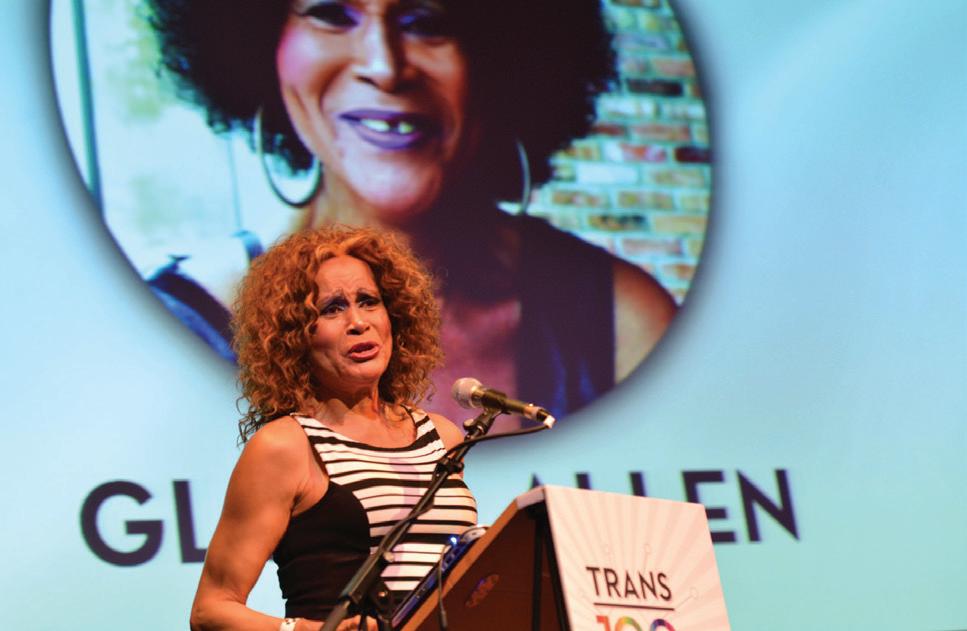
“People need to know what we have to go through being a transgender person,” Allen warns in the film. “Sometimes it can be dicult and scary, and then sometimes it can be beautiful.”


Difficulties are explored in the movie, including the rejection Allen experienced from her stepfather, and a sexual assault incident at the hands of the same high school bullies who would chase her home throwing bottles and bricks her way.

“Always, as a storyteller, when someone shares with you their deepest traumas and secrets, you feel a great responsibility, as did I,” Fisher, who happens to be the mom of a trans
daughter, says. “I felt like I had to get this right for her and I had to find that right balance.”
“It never was a story about trauma, because that wasn’t how Gloria lived her life; she didn’t live her life as a victim,” Fisher continues. “She really was all about being in the present moment, being optimistic, and leading with love.”
That sentiment, Valle says, was palpable by anyone Allen crossed paths with.

“Across this country, she has become an icon. She’s an influencer, a leader, a model,” he says, referring to her in the present tense, “and I think she’ll be remembered for years to come, especially by those who had direct contact with her, adults and young people. From that very, very first moment, I always looked forward to seeing her.”

Near the end of Fisher’s film, Allen got introspective and reflected on how she’d like to be remembered.
“I want people to remember me as being a joyful person, really, a happy-go-lucky person,” she says against a soft piano score. “And, I want them to remember my dimples, you know?” she says pointing at her cheeks. “‘Cause I got these dimples through God. God took His fingers and said, ‘OK, you’re cute, and you’re funny.’ And I want them to realize that I am a good person; I am a trans person and I have a beautiful spirit.”
Forever in the hearts of many, indeed. v
NOVEMBER 10, 2022 - CHICAGO READER 57 “Mama” Gloria Allen accepting her living legend distinction during 2014’s Trans 100 Awards. KAT FITZGERALD FOR WINDY CITY TIMES www.exoticrug.org 806 Dempster Street Evanston, IL 60202 630-373-5190 Large selection of authentic Persian rugs We will not be undersold. : Se ices include: Restoration | Cleaning | Appraisal Rugs Find hundreds of Reader-recommended restaurants at chicagoreader.com/food
@EnriqueLimon
“
I thank God for the transgender people, because we are a blessing.
—“Mama” Gloria Allen
ARTS & CULTURE
VISUAL ARTS
New ways of survival
By KERRY CARDOZA
Anna Martine Whitehead’s solo exhibition, “Notes on Territory: Meditation,” at Roman Susan, is an invitation to imagine new ways of survival. The bulk of the gallery is taken up by a seven-by-ninefoot wooden platform strewn with books and throw blankets; a woven canopy hangs above it, forming a compact sanctuary of sorts. The sculpture has the same dimensions as the crawl space that Harriet Jacobs, an enslaved woman on the run from her captor, lived in for seven years. To put your body in proportion to the space, to crawl inside of it—as visitors are encouraged to do—is heavy, but that’s not the takeaway that Whitehead envisions. Instead, they think there is something liberatory to be gained from putting one’s body in this space. “This is in no way what her space looked
like,” Whitehead says. “This is not a re-creation of suffering. I’m very opposed to rehearsing su ering.”
The back of the sculpture is enclosed by a shiny metallic sheet, silver on one side, gold on the other. The base—made of wood sourced from the trees around Lathrop Homes, many of which were felled for the redevelopment—holds a loose library of books relating to abolition, liberation, and radical thought, from Nicole Fleetwood’s Marking Time to W. E. B. Du Bois’s Data Portraits: Visualizing Black America.
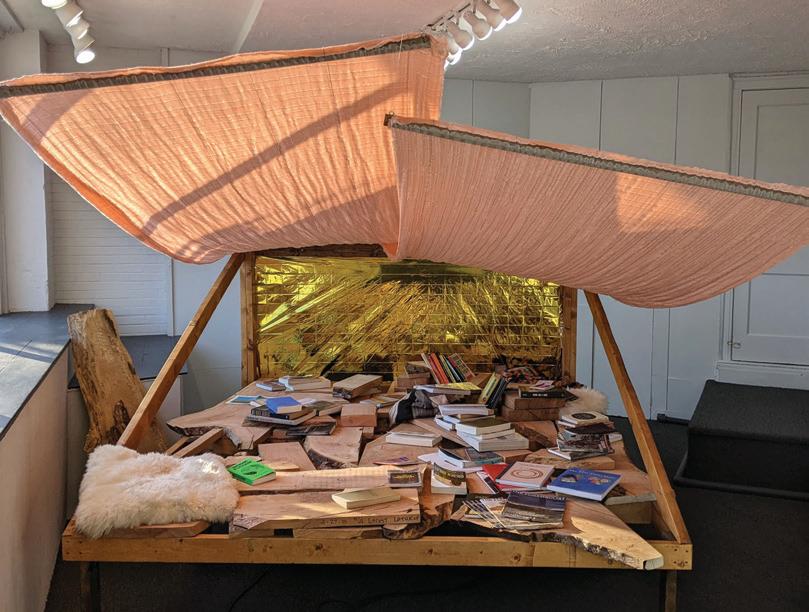
Whitehead first learned about Jacobs’s story about seven years ago, eventually reading her autobiography, Incidents in the Life of a Slave Girl, one of the few extant first-person narratives told from the perspective of an enslaved woman. The book details Jacobs’s
R “NOTES ON TERRITORY: MEDITATION”
Through 11/20 : by appointment Wed-Thu 1-6 PM, Sun 3-6 PM, Roman Susan, 1224 W. Loyola, text 773 270 1224 or email art@romansusan.org, romansusan.org
type of architecture of containment. “I guess my question was: how do people survive in these places?” she says. “I was trying to draw this connection between survival through the slave castles, onto the slave ship, onto the plantation, and then survival all the way to now, through prison. How do you survive that? And I felt like her work gives us some tools for thinking, for understanding ways to survive in relationship to architecture that is meant to not support human survival.”
For Whitehead, there is also a woman-centric element to this work—“that women make spaces into homes that aren’t really meant for them and their families to live in.” Indeed, Jacobs’s crawl space was located in the house of her grandmother, who provided a bed for her to sleep in, and covertly brought extra blankets during the winter months.
Whitehead will be present at the gallery on Thursday afternoons throughout the duration of the show, encouraging visitors to spend time inside the piece. And on November 10, artist and dancemaker Jay Carlon will be activating the installation at 5 PM.
childhood, her decision to flee a sexually aggressive captor, the years she spent in hiding, and then her eventual journey north to freedom. The crawl space Jacobs lived in was roughly the size of a contemporary prison cell (other than in height—Jacobs’s space was three feet tall at its highest point), a poignant coincidence for Whitehead, whose work often references the prison industrial complex.
The project was first staged in 2019 at the Chicago art space SITE/less. The iteration at Roman Susan includes a calming ambient noise component, made in collaboration with Sofía Córdova, that encourages quiet contemplation. On the walls behind the platform are a series of spare paper collages. They depict metamorphic creatures, part human, part animal, with redacted text from Assata Shakur’s autobiography or James Carr’s Bad. The outline of the figures echoes the floor plan of Cape Coast Castle, a historic site in present-day Ghana where Africans were held in dungeons before being put on ships and sold o to slavery.
“These collages feel like either armor or building a transformer,” Whitehead says. “I think that’s what I’m thinking about these as: hybrid beast forms.”
While the collages may seem disparate from Jacobs’s crawl space, both reference a
“I think there’s something to learn from being with your body inside the space, but I don’t know what exactly it is,” Whitehead says. Jacobs referred to her secret hideaway as her “loophole of retreat,” a sort of liminal space that provided a nominal sort of freedom. Reading her autobiography, which is available for perusal at Roman Susan, one is struck by Jacobs’s formidable psychological capacity, her refusal to be broken down by the system of slavery. Living for so long in a space that didn’t allow for standing, or even comfortably sitting up, that had no proper window to the outside world, seems like an unimaginable hardship, but it was one that Jacobs chose. Her later life was no less remarkable, not only writing her book, which she hoped would convince readers of the true degradations of slavery, but also doing relief work and even founding a free school for formerly enslaved people. Whitehead considers the components of the exhibition to be an o ering of sorts, for visitors to do what they want with, to forge their own connections.
Their hope is that the piece will take on a more permanent form outdoors, maybe in a public park. An area near Lathrop Homes would be a fitting site. She really wants people to climb into and interact bodily with the piece, and bringing it outside the gallery walls will only expand its reach, its possibilities. v
58 CHICAGO READER - NOVEMBER 10, 2022 ll
Installation view of “Notes on Territory: Meditation” by Anna Martine Whitehead at Roman Susan COURTESY ROMAN SUAN
A solo show from artist Anna Martine Whitehead at Roman Susan
@booksnotboys
Let’s Play!
OFFICIAL INFORMATION REGARDING APPRENTICESHIP OPPORTUNITIES
OFFICIAL INFORMATION REGARDING APPRENTICESHIP OPPORTUNITIES
I. B. E. W. Local 134 and the Electrical Contractors' Association sponsor apprenticeship programs in Cook County, Illinois through the Electrical Joint Apprenticeship and Training Trust (EJATT). EJATT has permission from the U.S. Department of Labor to open a registration for new applicants for its Electrical Program. For more information on this program, please go to our website at www.ejatt.com.
I.B.E.W. Local 134 and the Electrical Contractors’ Association sponsor apprenticeship programs in Cook County, Illinois through the Electrical Joint Apprenticeship and Training Trust (EJATT). EJATT has permission from the U.S. Department of Labor to open a registration for new applicants for its Electrical Program. For more information on this program, please go to our website at www.ejatt.com.
REGISTRATION INFORMATION
REGISTRATION INFORMATION
Registration for the Electrical Program will take place at the IBEW-NECA Technical Institute 6201 W. 115th Street, Alsip, Illinois

EVERY WEDNESDAY 9:00 A.M. until 11:00 A.M.

Registration for the Communications Program will take place at the IBEW-NECA Technical Institute 6201 W. 115th Street, Alsip, Illinois EVERY WEDNESDAY 9:00 A.M. until 11:00 A.M.
All applicants must report in person and bring the following documents in order to register:
1.Your valid Driver’s License.
2.Your original Social Security Card.
All applicants must report in person and bring the following documents in order to register:
1. Your valid Driver’s License.
2. Your original Social Security Card.
You must provide copies of the following documents that will be kept by EJATT (No documents will be copied in our o ce or returned to you):
You must provide copies of the following documents that will be kept by EJATT (No documents will be copied in our office or returned to you):
1.A $50.00 non-refundable registration fee (Money Order only made payable to EJATT).
3. A $50.00 non-refundable registration fee (Money Order only made payable to EJATT).
2.To prove employment eligibility you must provide a copy of your U.S. Birth Certificate, U.S. Passport, Certificate of U.S. Citizenship or Naturalization, or Permanent Resident Alien Card. (Minimum age of 17 at registration).
4. To prove employment eligibility, you must provide a copy of your U.S. Birth Certificate, U.S. Passport, Certificate of U.S. Citizenship or Naturalization, or Permanent Resident Alien Card. (Minimum age of 17 at registration).
3. To prove High School Graduation (HS), you must provide a copy of your HS transcript (o cial or uno cial with a graduation date posted), or a copy of a Diploma, or GED Certificate. College transcripts do not satisfy this requirement. HS seniors in their last semester prior to graduation may register with acceptance contingent upon graduation.
5. To prove High School Graduation (HS), you must provide a copy of your HS transcript (official or unofficial with a graduation date posted), or a copy of a HS Diploma, or GED Certificate. College transcripts do not satisfy this requirement. HS seniors in their last semester prior to graduation may register with acceptance contingent upon graduation.
4.To prove one full year of HS level Algebra with a grade of at least “C” or better, or one post HS level Algebra course or higher level course with a grade of at least “C” or better, you must provide a copy of a transcript. Note: The GED Math Certification does not satisfy this requirement.
6. To prove one full year of HS level Algebra with a grade of at least “C” or better, or one post HS level Algebra course or higher level course with a grade of at least “C” or better, you must provide a copy of a transcript. Note: The GED Math Certification does not satisfy this requirement.
Upon an o er of apprenticeship, you must be able to demonstrate that you can perform the essential functions of an apprentice electrician with or without a reasonable accommodation. In addition, a drug screen, physical exam, and background check will be required.
Upon an offer of apprenticeship, you must be able to demonstrate that you can perform the essential functions of an apprentice electrician with or without a reasonable accommodation. In addition, a drug screen, physical exam, and background check will be required.
EJATT will not discriminate against apprenticeship applicants or apprentices based on race, color, religion, national origin, sex (including pregnancy and gender identity), sexual orientation, genetic information, or because they are an individual with a disability or a person 40 years old or older. The EJATT will take a rmative action to provide equal opportunity in apprenticeship and will operate the apprenticeship program as required under Title 29 of the Code of Federal Regulations, Part 30.
EJATT will not discriminate against apprenticeship applicants or apprentices based on race, color, religion, national origin, sex (including pregnancy and gender identity), sexual orientation, genetic information, or because they are an individual with a disability or a person 40 years old or older. The EJATT will take affirmative action to provide equal opportunity in apprenticeship and will operate the apprenticeship program as required under Title 29 of the Code of Federal Regulations, Part 30.
NOVEMBER 10, 2022 - CHICAGO READER 59
Make time to learn something new with music and dance classes at Old Town School! We offer flexible schedules for all skill levels both in-person and online. oldtownschool.org Sign up for classes today at MUSIC CLASSES FOR ADULTS & KIDS LINCOLN SQUARE LINCOLN PARK SOUTH LOOP & ONLINE OTS_1_2V_ClassAd_072921.indd 1 7/23/21 2:21 PM
OPENING
RSouthern secrets and lies MadKap’s Cat on a Hot Tin Roof sizzles.
Sarah Sapperstein’s Maggie the Cat commands your attention with her act one monologues in MadKap Productions’s mounting of Tennessee Williams’s Cat on a Hot Tin Roof at Skokie Theatre, directed by Steve Scott. Sapperstein’s costars take her energy and roll with it for the entirety of this show, in which a southern family unravels (and winds back up again) the lies they’ve told themselves and each other.
Kent Joseph and Caleb Gibson as Big Daddy and Brick, respectively, take the narrative reins in subsequent acts, as Big Daddy tries to get to the bottom of Brick’s alcoholism and the nature of Brick’s relationship with his late buddy Skipper, a relationship that Brick of course hasn’t figured out too well either.
Joseph exudes Big Daddy’s menace, disgust, and cruelty when he’s both exasperated with his family’s phony birthday and reminding everyone of his control over the family purse strings. But his walls start to crack as he needles Brick more and pokes at truths about both his son and himself. With his character hobbling on one leg throughout the show, Gibson aptly shows us Brick’s sorrow and desire for hiding, seeking solace only in liquor as the long evening unfolds.
Add in the delusional Big Mama (Ann James, also excellent) and the schemes of Brick’s brother Gooper (Reid Harrison O’Connell) and sister-in-law Mae (Emilie Yount), and you have all the makings for a sultry, captivating southern evening that will take your mind off the November chill.
—MATT SIMONETTE CAT ON A HOT TIN ROOF Through 11/20: Fri-Sat 7:30 PM, Sun 2 PM; also Wed 11/16 1:30 PM, Skokie Theatre, 7924 Lincoln, Skokie, 847-677-7761, skokietheatre.org, $38 ($34 students/seniors)
Sound and fury
most of the time, the material—and the audience—is not well served by the show’s performance style. —JACK HELBIG THE INEPTIDEMIC Through 11/19: Thu-Sat 8 PM, Sun 7 PM, Otherworld Theatre, 3914 N. Clark, conspirewithus.org, $25 ($15 students/seniors)
Trust the masks
Over My Dead Body works best in wordless moments.
Drawing from a well that’s 500 years old and who knows how deep takes nerve. Yet that’s what Laughing Stock attempts with this contemporary take on commedia dell’arte. You could say that theater, and, by extension, TV and movies, have never really escaped the archetypes and tropes set in Italy so long ago, but to put on the old masks and employ the exaggerated gestures is a lot more than a nod to the past. So what does this company bring to the well-worn scenario of family, friends, and servants plotting a patriarch’s demise to make off with his riches? Well, there’s that ponderous subtitle and a lot of attendant dialogue about who should and should not inherit or prosper a er a wealthy person’s passing.
I have no doubt of the company’s earnestness. They devised their play to comment on a real-life societal problem in 2022. But their words bog down a production which is at its best in wordless moments. Director Antonio Fava has brought not only decades of experience from the old country but also his beautiful handmade leather masks. It’s remarkable how evocative a figure crossing a mostly bare stage with one of these elemental expressions can be. That medieval magic still works when it’s not interrupted by blather and explanation. Those fixed grimaces, squints, and caterwauls convey more than a mountain of words. I wish Laughing Stock trusted the masks to do more of the work they were designed to do. —DMITRY SAMAROV OVER MY DEAD BODY; OR, HOW TO DISTRIBUTE GENERATIONAL WEALTH Through 12/4: Thu-Fri 8 PM, Sat 2 and 8 PM, Sun 3 PM, Athenaeum Center for Thought & Culture, 2936 N. Southport, athenaeumcenter.org, pay what you can ($25 suggested donation)
tion. The intricate stage combat, by BWBTC ensemble member Maureen Yasko, demonstrates the characters’ imminent danger without ever being gratuitous. —KATIE POWERS PLAID AS HELL Through 11/19: Wed-Sat 8 PM, Sun 3 PM; open captions Sat-Sun 11/12-11/13 and Wed-Thu 11/16-11/17, sensory friendly performance Sun 11/13; livestreaming Wed-Fri 11/16-11/18, Factory Theater, 1623 W. Howard, babeswithblades.org, $35 ($28 students/seniors), $30 streaming, recommended 18+
R Rent pays off
Porchlight’s revival is both nostalgic and urgently contemporary.
A er thoroughly enjoying the shameless perversity of Kokandy Productions’s Cruel Intentions, under Adrian Abel Azevedo’s direction, I found Azevedo’s Rent at Porchlight to bring a stark, o en heart-wrenching dose of relevance to his now-known talent for embodying nostalgia. Musicals can be tough when you have the cast recording memorized, but this production of the late Jonathan Larson’s Tony- and Pulitzer-winning musical won me over, thanks to its capable cast, memorable set, and impressive ability to be both of the early 90s and jarringly present. The stage is literally a giant VHS tape on which live video of the actors is occasionally projected. (Ann Davis designed the set.) This theme of documentation, memory, and capturing moments in tragic times strikes the nerve we felt in the not-sodistant early days of COVID, as well as the current discourse around monkeypox, which has been disproportionately harmful (both physically and ideologically) to the LGBTQ+ community.
Pipe, directed and devised by Ellyzabeth Adler with the assistance of Hannah Blau. Black suits, blue skies, bowler hats, and apples easily transport viewers to the surrealist world Magritte created. “Molly!” choirs the ensemble like a Meisner repetition exercise, until it vanishes. A duet by Mia Hilt and Mary Iris Loncto questions whether identity is the reason the same steps look different on different dancers. Sigmund Freud (Jenise Y. Sheppard) appears, accusing women of penis envy, before being revealed (by removal of beard and suit) as a woman. “I am enough!” and other self-affirmations become the new chorus before the backdrop falls away, revealing a blood-red rose, from which a woman (Wannapa P-Eubanks), shrouded in a tight red veil and scarlet wedding gown, emerges. However, in a work that claims to resist a one-to-one interpretation of symbols, This Is Not a Pipe can’t resist a commitment to the surface. —IRENE HSIAO THIS IS NOT A PIPE Through 11/19: Fri-Sat 8 PM, Ebenezer Lutheran Church, 1650 W. Foster, danztheatre.org, $13-$20 (children under 15 free)
R Choose your own adventure— from your seat
The Twenty-Sided Tavern offers a theatrical twist on role-playing games.
The Twenty-Sided Tavern—written by David Andrew Greener Laws (aka DAGL), with game design by Sarah Davis Reynolds, and produced by David Carpenter, is an interactive, theatrical quest that invites you to control the story from the comfort of your seat.
Their premise is not half bad: a “still relatively new” (as they describe themselves) theater company uses a fictional 125th-anniversary “jubilee” to bring together a collection of short sketches, some drawn from previous shows, some original to this one. Unfortunately, most of the comedy sketches, created by Sid Feldman and directed by Wm Bullion, are not particularly funny. And the performances are so rough and broadly performed that the little comedy in the material gets lost in the noise.
The noise, though, is the point. You see, the Conspirators set as their mission to perform in the loud, broad, way, way over the top “neo-commedia” style concocted 30 years ago by, among others, the folks at the late, lamented (by some) New Crime Productions. As part of the style, the actors wear garish, aggressively nonnaturalist gray-and-white makeup reminiscent of pre-WWII German cabaret theater, and all of their movements are accompanied, Kabuki-style, by a live percussionist. This unusual, highly artificial aesthetic only works with material written specifically for this restricted style—the New Criminals tried it with a stage adaptation of Hunter S. Thompson’s Fear and Loathing in Las Vegas and sank like a stone—and demands a lot more from actors than this particular show’s cast can deliver. A couple of sketches really shine here—in particular a vicious little satire slashing at former President Trump just soars. But
R Cabin in the woods
Babes With Blades subverts serial-killer tropes.
In Cat McKay’s queer comedy Plaid as Hell, Cass (Reagan James) hopes that a weekend away in the Wisconsin woods will be a fitting opportunity for her best friend Emilie (Cayla Jones) to bond with her new girlfriend Jessica (Ashley Yates)—who Emilie hasn’t been so keen on getting to know, thanks to an unrequited crush on Cass. Their friend Kelly (Alice Wu) is tired of being caught in the middle. If the knotty interpersonal dynamic isn’t enough to jumble the weekend, there’s also a serial killer at large. While the killer’s whereabouts provide massive suspense, the frank humor and raw vulnerability the women display as they come to terms with their ordeal, and their feelings toward each other, are just as powerful.
Presented by Babes With Blades Theatre Company, Plaid as Hell exemplifies the company’s mission to “develop and present scripts focused on complex, dynamic (o en combative) characters who continue to be underrepresented on theatre stages based on gender.” The four women contain multitudes, and their highly realistic relationships with one another reflect their unique perspectives, shortcomings, and strengths. Under the direction of Christina Casano, each actor finds depth in moments of lightness and of devasta-
Yet Rent is so much more than a snapshot in time of the devastating HIV/AIDS crisis. From Angel and Tom Collins (Eric Lewis) to Mimi (Alix Rhode) and Maureen, Rent portrays queer relationships with joy and complexity, celebrating how unique, though ultimately similar, our soulmate connections truly are. This cast nails the ensemble moments, from the vulnerability of “Will I?” to the radical energy of “La Vie Boheme.” Josh Pablo Szabo is an electric Angel, commanding the stage in life and channeling the cast’s collective passion in passing. Lucy Godínez makes a strong case for Maureen’s performance art to be its own, separate production. Finally, David Moreland as Mark and Shraga D. Wasserman as Roger give the best-friend energy that helps land the plane on hope for the future. —MARISSA OBERLANDER RENT Through 12/11: Thu 7:30 PM, Fri 8 PM, Sat 3:30 and 8 PM, Sun 2 PM; also Thu 11/10 10:30 AM, Thu 11/17 1:30 PM, and Fri 11/25 3:30 PM; open captions Sat 11/19 and 11/26 3:30 PM; Ruth Page Center for the Arts, 1016 N. Dearborn, 773-777-9884, porchlightmusictheatre.org, $45-$79
When is a pipe not a pipe?
Chicago Danztheatre Ensemble looks at modern art and gender.
René Magritte’s 1929 painting La Trahison des images is best known for the text it contains: painted in a curlicue script beneath the curved image of a pipe are the words, “Ceci n’est pas une pipe.” The paradox brings us not to the depth of the pipe but the surface, gleaming with a plastic finish, nothing but paint. (Of course, the words are also only paint; our cultural indoctrination makes us misread them as meaningful.)
The simplicity of this “icon of modern art” has made it an easy joke to repeat. And repetition is at the core of Chicago Danztheatre Ensemble’s 2006 This Is Not a
Inspired by fantasy tabletop role-playing games, you choose the characters and the choices they make from your smartphone. Using a browser-based so ware created by Carpenter’s company Gamiotics Inc., you vote on decisions, multiclick for combat, and solve riddles. There are opportunities to participate onstage, but they are voluntary. This production, presented by Broadway in Chicago at the Broadway Playhouse, strikes an entertaining balance between digital and in-person interaction, letting you decide how much you want to be involved. Even if you don’t want to play the game, there are still plenty of comedic and improvisational moments to enjoy.
On its opening night, the Dungeons & Dragons-esque show attracted an audience of all ages and backgrounds, confirming you do not have to be a gamer to understand the game. Onstage, as our “Gamemaster” and “Tavern Keeper,” DAGL and Reynolds explained the rules and guided us through the experience. With the fourth wall completely shattered, opening night’s vocal audience had a lot of fun interacting with the actors. At one point, a er having a streak with only male characters, one audience member insisted we change one of the characters’ genders, and the cast agreed.
Although Gamiotics lagged on my phone a few times, The Twenty-Sided Tavern fills a gap in live theater by bringing accessible technology to the stage. As the production changes every night based on audience engagement, it redefines experiential entertainment, reminding us that we write our stories. —BOUTAYNA CHOKRANE THE TWENTY-SIDED TAVERN Through 1/15: Thu-Fri 7:30 PM, Sat 2 and 8 PM, Sun 2 and 7:30 PM; also Fri 11/25, 2 PM, Wed 12/21 and 12/28 2 and 7:30 PM, Sat 12/24 2 PM only, no show Thu 11/24 or Sun 12/25; Broadway Playhouse, 175 E. Chestnut, 800-775-2000, broadwayinchicago.com, $40-$65 v
60 CHICAGO READER - NOVEMBER 10, 2022 ll
THEATER
The Conspirators go way over the top with The Ineptidemic






























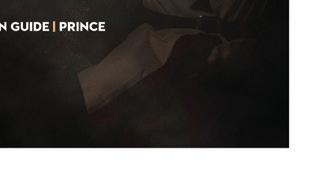




NOVEMBER 10, 2022 - CHICAGO READER 61 Providing arts coverage in Chicago since 1971. chicagoreader.com
BLACK HARVEST FILM FESTIVAL
In-person through 11/20, virtual through 11/27
Gene Siskel Film Center, 164 N. State
Festival passes $ 60, Film Center members $ 30 ; single tickets $12 , Film Center members $ 6 siskelfilmcenter.org/blackharvest

FESTIVAL One of a kind
The Gene Siskel Film Center hosts the 28th annual Black Harvest Film Festival in honor of cofounder
By MAXWELL RABB
The 28th Black Harvest Film Festival, hosted at the Gene Siskel Film Center, invites Chicago to experience a rich selection of films devoted to amplifying Black storytelling and promoting the careers of young filmmakers. But this year, the monthlong celebration differs from the previous 27, following the death of beloved cofounder Sergio Mims, who passed away in October at 67. The 2022 festival will serve as a tribute to Mims’s cinematic legacy, featuring an impressive lineup that includes 19 feature films, four short film programs, and more than 15 filmmaker and cast appearances.
“The Black Harvest Film Festival has always been a reunion of filmmakers and film lovers,” says Jean de St. Aubin, executive director at the Gene Siskel Film Center. “This year, with the passing of Sergio Mims, it will be bittersweet. But we rejoice in what Sergio has created—a monthlong celebration of Black storytelling that has thrived for 28 years and counting. I look forward to seeing our loyal [Black Harvest] audience, welcoming new friends, and sharing Sergio’s stories along
with those on the screen.”
Black Harvest opened on November 4 with a ceremony dedicated to Mims’s memory—one defined by his multifaceted passion for film as an educator, a critic, a curator, and a film lover. During the reception, the festival awarded the Black Harvest Film Festival Legacy Award to Chicago casting director Sharon King and announced the Richard and Ellen Sandor Family Black Harvest Film Festival Prize winners.
“Opening Night celebration feels like a reunion each year, and is an exciting and joyful kicko to the entire festival—complete with award presentations, short film screenings, and a reception,” de St. Aubin says. “It is my favorite day of the year at the Gene Siskel Film Center.”
Before the Black Harvest Film Festival launched 28 years ago, the Film Center hosted the Blacklight Film Festival with Floyd Webb; however, mounting economic and personal reasons led to its untimely end. This left Chicago without a film festival dedicated to screening international Black filmmaking, until Barbara Scharres, the former director of
programming at the Film Center, called Mims to help create the Black Harvest festival.
The inaugural Black Harvest festival started as a ten-day event with 22 screenings, and now, the festival hosts 41 screenings and a massive itinerary of events. And Mims’s legacy lives on in the festival, which he helped curate during the last month of his life. The selection represents the robust filmmaking occurring worldwide, highlighting underrepresented stories and giving Chicago a glimpse of what Mims called “lots of Black joy.”
“Sergio’s great enthusiasm and his overwhelming, populist embrace of Black film in all its manifestations are the things that I believe will endure in the spirit of the festival,” Scharres says, sharing Mims’s role in Chicago film. “Black Harvest continues to be a festival that makes wide-ranging selections, and is exceptionally open to considering the work of first-time filmmakers and those in the early stages of their careers.”
Mims’s legacy is defined by his willingness to support emerging filmmakers, and the Black Harvest Film Festival is imbued with this mission. Since its inception, the festival has emphasized the importance of supporting filmmakers of color, especially in the early stages of their careers. The festival provides a platform for filmmakers to engage with their audiences and vice versa.
“We were seeing careers grow and flourish before our eyes,” Scharres says. “For young filmmakers, Black Harvest often functioned as their very first opportunity to present their work before a live audience and receive feedback. My hope for the future is that Black Harvest will continue to be the very alive and interactive forum for Black film that it has always aimed to be.”
Black Harvest’s selections range from deeply inspiring documentaries to thrilling horror movies, providing any interested film lovers with their genre of choice. The feature films include the psychological horror Nanny (November 15), following a Senegalese immigrant hired by an a uent New York couple; the coming-of-age film Jasmine Is a Star (November 19), telling the story of a 16-year-old girl with albinism; and the heart-wrenching Mars One (November 11 and 12), exploring the bonds of family and love when faced with challenging changes.
On November 12 and 20, the festival will screen Rewind & Play, a fascinating documentary centered around the famed jazz pianist Thelonious Monk. The film illuminates the casual racism and jarring disrespect the beloved musician experienced on French TV in 1969, alongside his performance at the Salle Pleyel concert hall.
Accompanying the new feature films, Black Harvest will also host several restoration and anniversary screenings. The revived films include Malcolm X (November 19), screened on 35mm, and the 50th anniversary 4K restoration of Sidney Poitier’s directorial debut Buck and the Preacher (screened November 9)—a reimagined classic Western. The festival will also revisit the comedy Cooley High on November 16 in memory of Mims, following a tribute to the late cofounder.
The festival also screens four original shorts programs including Sisters in Scene (November 17), presenting six stories of Black femininity, self-expression, and survival; Cine Lado a Lado (November 10 and 15), featuring complex stories about multifaceted African identities; From the Block (November 11 and 13), promoting Chicago-based filmmakers; and Figures & Guardians (November 12), showcasing emotional stories about guardians, mothers, fathers, and the people who raised us.
Closing out the impressive selection of in-person screenings, the Black Harvest Film Festival will host its annual 90s costume night with a screening of Boomerang on November 20. The essential 90s romantic comedy starring Eddie Murphy and Halle Berry was handpicked by Mims. Following the in-person screenings, the festival will host virtual screenings from November 21 to 27.
“The 28th festival is a tribute to Sergio’s dogged determination to suggest the best for our screens, to ensure emerging filmmakers were in the same spotlight as the established auteurs, and his e orts to make local filmmakers feel like stars and our audience to feel like a family,” says Rebecca Fons, the Gene Siskel Film Center’s director of programming. “We will miss him immensely—his bold opinions, his wit, his knowledge, and his camaraderie— and dedicate each moment of Black Harvest to his memory.” v
62 CHICAGO READER - NOVEMBER 10, 2022 ll FILM
@Chicago_Reader
Nanny (2022) GENE SISKEL FILM CENTER
Sergio Mims, who died this October.








IN-PERSON NOV.4-20 VIRTUAL NOV.21-27 SISKELFILMCENTER.ORG /BLACKHARVEST BRINGINGCHICAGOTHEBESTBLACKSTORIESONSCREENFOR28YEARS NEWFEATUREFILMS&SHORTS | FILMMAKERQ&AS | TICKETSONSALENOW!
FILM
Find new film reviews every week at chicagoreader.com/movies
Enola Holmes 2 NETFLIX
Causeway
Ten minutes into Causeway, Jennifer Lawrence is crying. The slow ambient soundtrack, composed by old Sigur Rós collaborator Alex Somers, hums with an ominous and wounded optimism best described as Profoundcore. It’s Oscar season, Apple TV+ is hungry for glory, and it’s that kind of movie. Next, Lawrence has to travel back home, a er completing brutal physiotherapy following a service term in Afghanistan. The nurse who helps her, played with awesome warmth by Jayne Houdyshell, is a short-lived early highlight of this dim product.
up being connected, so we get plenty of wonderful scenes of them working together as detectives as well as getting in scrapes.
PLAYING
R Aftersun
A ersun, as a product, is meant to soothe. One uses it a er a sunburn to avoid peeling. A ersun, as a film, doesn’t have the same intention. Instead, it works to so ly peel back the layers of childhood memories, once merry, now more melancholy. Despite it being Charlotte Wells’s debut film, A ersun feels as lived in as the fading vacation resort its protagonists, 11-yearold Sophie (Frankie Corio) and her father, Calum (Paul Mescal), pass through. While Sophie begins the familiar dance of adolescence, Calum, who is young enough to be mistaken for her older brother, is also coming of age, albeit under the stress of adulthood. The cracks of Calum’s struggles are plain to viewers, like when he goes dancing, and Sophie is le to sleep alone in the hotel lobby, interrupting an otherwise very sweet, if slightly strained, father-daughter relationship. Now, 20 years later, hindsight reveals those murkier moments to Sophie more clearly, and she grapples to reconcile them with the happier ones, like when she and her dad played pool and pulled pranks. Who was he then and who is she now? True to life, the answers remain elusive, but thanks to Wells’s evident confidence, this story, constructed slowly and focused on small moments, is more mesmerizing than most. —BECCA JAMES R, 98 min. Music Box Theatre, wide release on VOD
Armageddon Time
Queens, New York, 1980: on Paul Graff ’s first day of sixth grade he gets in trouble for drawing a caricature of the
teacher and makes friends with fellow screwup Johnny, a Black kid who’s been held back and is a frequent target of the teacher’s abuse. The two boys bond over their outcast status. Johnny wants to be an astronaut, while Paul dreams of becoming a famous artist. Alarmed at his acting out and afraid he’ll fall behind, Paul’s American Jewish family makes him transfer to a private school where Maryanne Trump and her father, Fred, are guiding lights. Johnny has no such alternative option and instead goes truant, sometimes hiding out in Paul’s backyard clubhouse to evade authorities.
Reportedly based on director James Gray’s own childhood, the film traffics in broad-stroke ideas about racism, anti-Semitism, and class struggle. Lost in this A er-School Special is a standout performance by Jeremy Strong as Paul’s low-status, frustrated father, who lashes out at his family with his words and fists but always feels like a disrespected laughingstock. Gray makes sure we know his people had the “right” politics by having them mock Reagan not once but twice when he appears on their TV set. But just like having members of the Trump family hover over the evil private school, this feels like stacking the deck. It’s not profound to say that Reagan’s America led to Trump’s or that Black people get a raw deal in both; these are truisms that don’t make for a compelling narrative. It’s not for nothing that early on Paul shows his beloved grandfather (a bafflingly miscast Anthony Hopkins) a drawing of a superhero he made up. His coming of age feels more like something out of the Marvel Universe than the childhood of a real living boy. —DMITRY SAMAROV R, 115 min. Wide release in theaters
Buzzy novelist Ottessa Moshfegh cowrote the script; her signature blend of the wry and the grotesque is nowhere to be found in over 90 minutes of humorless naturalism (unless you count a grim, tasteless use of CGI to portray a tragically severed limb). The formidable Brian Tyree Henry emerges as Lawrence’s new/old hometown best pal, but there’s not much for him to work with. It’s a shame seeing his powers of pathos put to such rangeless use. A dour, paint-by-numbers contemplation on trauma and dislocation unfolds, and we see two actors capable of tremendous expression stuck in a place that won’t allow it—instead they are given gray crayons with which to scrawl on gray paper.
As is the case with much of what’s produced by Apple’s partner in this endeavor, A24, it still looks like a spiritually meaningful movie. Sometime a er the studio’s vastly superior, landmark entry Moonlight, a mimicking style of photography and corresponding collection of austerity hues became the visual skeleton key to prevailing notions of cinematic weight. And no one’s been better at exploiting this formula than the outfit that started it. If Causeway achieves anything, hopefully it will be the acceleration of this increasingly stale new prestige style’s end. —JOHN WILMES R, 92 min. AppleTV+
R Enola Holmes 2
Enola Holmes is back, and if it ain’t broke . . don’t fix it! Enola Holmes 2 has everything you loved about the first film: a fun, adventurous YA mystery, Millie Bobby Brown (as Enola) regularly breaking the fourth wall to quip to the camera, hilarious hijinx, dangerous fight scenes, well-rounded supporting characters, and lots of girl power.
The film opens with Enola starting a detective agency—but of course she can’t compete with her famous brother, Sherlock (Henry Cavill, dressed in baggy period clothing to hide his super physique). She is investigating a missing girl and winds up infiltrating a match factory staffed entirely by girls and young women. (The central struggle of the film was based on an event called the “matchgirls’ strike” of 1888.) Luckily, their cases wind

These unsanitized films aren’t afraid to put their young leads in danger, and Enola takes more than a few hard hits (and delivers some too). Louis Partridge is back as Lord Tewkesbury and their relationship heats up, though Enola still makes it clear she doesn’t need a man to be successful. And both Susan Wokoma and Helena Bonham Carter are back to provide some much needed ass-kicking and explosions. Newcomers to the series include the deliciously devilish David Thewlis, who plays a terrifyingly violent police inspector, Grail; and Sharon Duncan-Brewster as Mira Troy, who does a great job coaxing and coaching Enola toward realizing her love for Tewkesbury. While much of writer Jack Thorne’s screenplay copies tropes from the previous film, the additional Sherlock Holmes lore that is expanded in this film, and the return of the characters we love, make this adventure well worth taking. —JOSH FLANDERS PG-13, 129 min. Netflix
R Weird: The Al Yankovic Movie
This isn’t your normal biopic. Pretty much every single aspect of it is exaggerated. The comedy singer-songwriter explodes into a sex symbol, becomes the greatest musician in history, all while having a relationship with Madonna and writing “Eat It” before Michael Jackson’s “Beat It.”
That’s exactly what audiences would want from a Weird Al Yankovic biopic, though.
The film’s playful parody of the genre is delightfully in tune with the legendary musician’s own work. It’s helped by a tremendous leading turn from Daniel Radcliffe, who very much looks the part as Yankovic. As he’s repeatedly shown since finishing Harry Potter, Radcliffe thrives when both his character and the film are odd and outlandish, and Weird gives him plenty to have fun with. Whenever the film threatens to deflate, it’s helped by an avalanche of cameos that immediately bring it to life again. Jack Black, Conan O’Brien, and Yankovic himself are particularly hysterical. At the same time, Evan Rachel Wood’s spot-on Madonna and Rainn Wilson’s avuncular Dr. Demento performances stop Weird from ever feeling too one-note. Unfortunately, it’s never as side-splittingly hilarious as it threatens to be. Weird: The Al Yankovic Movie still provides a steady stream of consistent laughs that mean it’s constantly enjoyable, while also being the perfect homage to its wonderfully bizarre and sweet inspiration. —GREGORY WAKEMAN TV-14, 108 min. Streaming free on the Roku Channel v
64 CHICAGO READER - NOVEMBER 10, 2022 ll
R READER RECOMMENDED b ALL AGES N NEW F
NOW

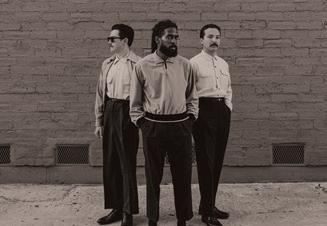


NOVEMBER 10, 2022 - CHICAGO READER 65 12~21 WED WHITNEY GIA MARGARET 12~22 THU WHITNEY DANIEL VILLARREAL 12~23 FRI WHITNEY LIFEGUARD 12~29 FRI WASHED OUT DJ SET 1~14 SAT REBIRTH BRASS BAND 1~22 SUN ROCK & ROLL PLAYHOUSE PLAYS GRATEFUL DEAD FOR KIDS 1~27 1~28 POI DOG PONDERING 2~2 THU ADAM MELCHOR 2~4 SAT CLAIRE ROSINKRANZ 2~15 WED THE 502’S FRESH SQUEEZED HAPPINESS TOUR 2~16 THU TRAMPLED BY TURTLES 2~17 FRI RUBBLEBUCKET 2~22 WED KIMBRA TEI SHI 3~10 FRI AN EVENING WITH DAWES 3~16 THU LARKIN POE 3~17 FRI JAWNY 3~3 FRI PEPPER 3~19 SUN IBEYI SPELL 31 TOUR 3~24 FRI NEAL FRANCIS VALEBOL 3~25 SAT NEAL FRANCIS ZELLA DAY 2~24 2~25 THE BETHS SIDNEY GISH ~ HANS PUCKET 2~26 SUN OTOBOKE BEAVER 4~4 TUE EMMA RUTH RUNDLE PATRICK SHIROISHI 4~21 FRI CAROLINE ROSE DONNY BENÉT 3~9 THU SHYGIRL 3~31 FRI THEE SACRED SOULS 1~21 SAT DRY CLEANING 1~13 FRI SIGN UP FOR OUR WEEKLY NEWSLETTER AT THALIAHALLCHICAGO.COM COMING SOON TO THALIA HALL SOLD OUT SOLD OUT
Michael Cameron, co-owner of Uncommon Ground

to perform.” And they were. So those were the first folks we booked, and we developed a reputation for that.
In 1994, Nick Miller from Jam Productions reached out to me. Sony and Columbia had contacted him and said, “Hey, we’re about to sign this young kid by the name of Je Buckley.” He’d gotten his start at this co eehouse in the Village in New York City called Sin-é. For his first tour across the country, he wanted to play similar little cafes. I’d known Nick for a while, so when he asked if I’d help, I was like, “Yeah, sure.” He sent me Je ’s four-song demo, Live at Sin-é, and I thought, “This guy’s incredible.”
Nobody in Chicago had ever heard of Jeff Buckley—he’d never played here before. Nick and I invited all our industry friends and other songwriters and friends to come and see the show—it was kind of a who’s who of the local music scene at the time. It was February, and during the performance, there was this giant snowstorm. The fireplace was going and the windows were all steamed up. We had candles everywhere and little twinkly lights. It was pretty magical, especially his performance— he played solo and you could hear a pin drop. After the show, we hung out and had some wine. He came with his manager, and I don’t know why, but in Chicago they gave him a Crown Victoria. Of course it got stuck along Grace Street. So we got into a snowball fight trying to push the car out—we were laughing our butts o .
Michael and Helen Cameron launched Uncommon Ground in 1991 as a tiny coffeehouse at Grace and Clark near Wrigley Field, eventually expanding it into a full-service restaurant and music venue. In 2007 they added a second location on Devon, which they recently closed to spend more time with family. In 2014 the original Uncommon Ground added Illinois’s first certified organic brewery, Greenstar.
The Wrigleyville coffeehouse earned a special place in rock history in February 1994, when it booked the Chicago debut of an unknown singer-songwriter named Jeff Buckley.
After Buckley died in a drowning accident in May 1997, Uncommon Ground held a tribute night in his memory. What started as a way to honor a friend grew into an international phenomenon, and this month Uncommon Ground hosts its 25th Jeff Buckley Tribute. Proceeds benefit a youth scholarship fund at the Old Town School of Folk Music.
For this week’s Chicagoans of Note, Michael Cameron shares the story of the life-altering gig that started it all and describes the ways Buckley’s music continues to inspire people today.
Uncommon Ground opened in 1991. My brother and I were both musicians, and my wife and I wanted to open a community gathering cultural center in that area. We knew from the beginning it would be a little co ee shop and cafe, and it would be casual, accessible, warm, and cozy.
We also wanted to support local artists and musicians. We had rotating gallery shows. Then I went to the Old Town School of Folk Music and said, “Hey, I know you have a lot of talented instructors. Let’s see if they’re interested in finding a nice little acoustic spot
Months later my brother called and said, “Hey, are you sitting down? I just read the Chicago Tribune. You need to flip to the music section.” Greg Kot had written that Je Buckley at Uncommon Ground was the best concert of the year. The rest of the list were artists like Bob Dylan and Sinead O’Connor who played big venues and stadiums. It was a little surreal, and it definitely put us on the map musically.
I was very thankful to Greg for that recognition. Never in a million years would I expect something like that. And it did sort of change the dynamic.
I’d been booking all the music. I was helping artists with their live sound, and we actually recorded music back then, like samplers with
66 CHICAGO READER - NOVEMBER 10, 2022 ll
MUSIC
COURTESY MICHAEL CAMERON
CHICAGOANS OF NOTE
“Around 300 performers have flown to Chicago to pay tribute to Jeff ’s music. It’s like the Jeff Buckley pilgrimage to Grace Street.” As told to JAMIE LUDWIG
JEFF BUCKLEY TRIBUTE
The 25th Jeff Buckley Tribute includes a three-course dinner and doubles as a fundraiser for the Old Town School of Folk Music. Artists including Stephen Kohler, Shady Ahmed, Todd Kessler, Umraan Syed, Jennifer Hall, Dan Krochmal, Joe Armstrong, Bird & Butterfly, Spells and Curses, Cooper Ladnier, and Leela Ladnier will each perform two songs from Buckley’s catalog. Wed 11/16 and Thu 11/17, 6:30 till 9 PM, Uncommon Ground, 3800 N. Clark, both nights sold out, all ages
MUSIC



a dozen local singer-songwriters who performed at our little place. Then all of a sudden, I’m getting phone calls from Sony, Aware, Geffen, insert-label-name-here saying, “We have a new artist who we think should play your co ee shop.” This was around the MTV Unplugged era as well, which fed into that idea of stripping down rock bands for a more acoustic setting.
The next time I saw Je perform was at the Green Mill. After that it was Metro, where they put out the Live at Cabaret Metro album, which was unbelievable. It was a joy to see his career explode so quickly. When he came through town, we’d always get together. I’d go see him perform, he’d introduce me to the band, and we’d go out drinking afterward.
Because of that solo show, we started getting calls from artists who played bigger places and wanted to play stripped-down acoustic sets. I was a huge fan of this UK artist, David Gray. He called me personally (this was before email and everything), and I thought someone was playing a joke on me. He was playing an afternoon show at Schubas, and he asked if he could come by and do an evening gig.

Train played Uncommon Ground because the head of Sony wanted to hear them once more before he decided whether to sign them. So Train got signed at Uncommon Ground— the guy from Sony jumped up and said, “I’m gonna buy everybody’s dinner tonight. We just made up our minds!” Susanna Hoffs of the Bangles set up a co eehouse tour because she wanted to do what Jeff had done. I’m almost positive we were the one and only coffeehouse she ever played. There were like 40 middle-aged men sitting three feet away from her. Maybe it was a little too close? A few days later, I read that she’d canceled the tour.




[In 1997], my brother and I were thinking of opening a midsized rock club. Every month I was producing shows at a di erent rock club, to get a feel for what it would be like to own something of varying sizes. On the night we were informed that Je had been lost, I was producing a show at Schubas, and I was actually performing with my band. I remember it like it was yesterday. I was friends with Anastasia Davies, who booked Schubas at the time.



She walked up onstage and gave me the news. They still hadn’t found him, but they didn’t expect him to survive.
I had to walk o stage for a few minutes to let it sink in. I told Helen, my wife, who started crying. We really loved Je . We loved his music. We loved him as a performer and also as a human being. When you get that kind of news, you think, “Oh my God, how did that happen?” I made an announcement onstage, and I could hear everybody in the audience gasp. They knew that history with us, and I’d turned so many people on to that first album.
The very first Jeff Buckley Tribute was a listening party. One of my regular customers suggested we do a memorial, and 50 people showed up to pay their respects. At the end some musician friends asked, “What would you think of doing a tribute concert?” So year two, we started a tribute concert. I didn’t know if there’d be any interest, but it grew in popularity, and the more we did, the more popular they became. In the early years they were way too long with too many artists, but by year seven or eight I had it dialed in.
I pinch myself all the time because of the weird things I’ve experienced and the people I’ve met because of something I started long ago. In year two, I’d reached out to Mary Guibert, Je ’s mom, and we became friends. A couple years later she wanted to show an early documentary about Je on a west-coast tour. She knew that I was born in Seattle, where it was screening at the Experience Music Project, and she asked if I wanted to come help her with the event. I was like, “That’ll be great. When I get done, I’ll go see my family.”
At the Experience Music Project, Mary had put me in charge of the green room, which is this giant bunker at the bottom of the theater. And she goes, “I have some special guests, but I’m not going to tell you who.” The elevator door opens, and Chris Cornell steps o with Susan Silver, who was his wife at the time. Literally a minute later, the elevator opens again and Brad Pitt walks out.
So for about 30 minutes Brad Pitt, Chris Cornell, and I are sitting around this coffee table sharing Je Buckley stories. They were there because Chris was a friend and Brad was
NOVEMBER 10, 2022 - CHICAGO READER 67
a huge fan. And I was just helping Mary. Then Brad Pitt says, “Hold on, I’m gonna go get my filmmaker and my cinematographer. We’re gonna do that again.” I ask, “We’re gonna do what again?” He says, “We’re gonna share all these stories again, but this time I wanna get it on film.” Because he was trying to do a di erent documentary. So somewhere there’s a half hour of this footage that I’ve never seen. Whenever I see Mary, I ask, “If you talk to Brad again, would you tell him I’d love to have a copy of that?” Because people don’t believe me.
In year ten, I decided to do one night at Uncommon Ground and a second night at Metro, because so many people were flying in for the performances. That year, there were more international performers than performers from the United States. People were coming from Germany, Denmark, France, Italy, the UK, and the Netherlands to pay tribute to Je . I couldn’t believe it. When I told Mary, she said, “Oh, I’ve got to come in.” So for 15 years she’s been flying in too. Her niece, Je ’s cousin Alison [Raykovich], has come with her for the last eight or nine. They’re like family now—we call Mary our “rock ’n’ roll mama.”
One of the best parts about doing this is you get to be the great connector—you get to introduce all these amazing performers to each other. Over the years, some really great relationships have been formed. Artists will go on tours together or sit in with each other’s bands. There’s all this connectivity and camaraderie. It seems like everybody comes together for their love of Je Buckley and checks their egos at the door. It’s fantastic to watch it happen in real time.
[The production] is pretty loose. If you’re gonna perform at a Je Buckley tribute, you better have the chops, right? We want people to do what Je did and completely rearrange a song. My favorite thing is when the audience doesn’t even recognize it until the artist starts singing because they’ve made it their own. If you want to come in and impersonate Je , that’s OK, but that’s not really what this is about. It’s about the spirit of the music and making it yours and paying him tribute as a musician and performer in what you do.
We were going to do two nights at Metro for the 25th tribute show, but now we’re doing them at Uncommon Ground. We spoke to a lot of extremely famous performers that have been Jeff Buckley fans for a very long time, and we got a lot of early commitments when people were unsure about the pandemic, how
venues would reopen, and whether or not they could book tours. But when things opened up, most of those acts started peeling o one by one. They’re touring as much as they possibly can, while they can.
I totally get that—they’ve gotta get out there and make money. So I went to Joe Shanahan at Metro, who I’ve been good friends with for 30 years. I wasn’t going to try to force something into that venue if most of the main artists had to back out. I also wanted to make sure that I stayed true to what the tributes were really all about. Keeping it intimate at Uncommon Ground was the right thing to do.
[Booking big-name artists] was always about people who’d been fans of Je and his music. Some of them never got to see him perform, but his music touched them and they wanted to be involved. A tribute on a larger scale will happen at a later time. This was inconvenient timing, but it’s a celebration of music that all of these artists had to turn me down because they were able to ramp up their music careers again after the past two and a half years. So I’ve asked one Chicago artist to come be my guest this year. And another artist, who was a Chicago artist 16, 17 years ago, is flying in from LA to perform. They’ve both played it before and wanted to get involved again.
I’ve always thought, “Let’s see if people still want to come.” But as soon as I put the tickets on sale, they sell out in like 15 minutes. There’ve been years where I’ve gotten hundreds of submissions from people who want to fly in on their own dime to pay tribute to Je . It just keeps on rolling.
I hope this story inspires people who aren’t familiar with Je to listen to the album Grace. Then they’ll get it. Dial that up and it’ll change your musical life. If you haven’t experienced it, you need to experience it. If you’ve experienced it and you want to see some very passionate musicians perform it, come to one of the tributes.
Around 300 performers have flown to Chicago to pay tribute to Je ’s music. It’s like the Je Buckley pilgrimage to Grace Street. And when people come and walk around the side of the building and look at the street sign, they say, “You’re kidding—he played on Grace Street?”
The title is probably a coincidence. I never got to ask him about it personally, so I can only speculate. But it was crazy when the album came out. I was like, “You’ve gotta be kidding me!” v
68 CHICAGO READER - NOVEMBER 10, 2022 ll
@unlistenmusic MUSIC continued from 67 e Chicago Reader is now biweekly More than 60,000 copies will be available at nearly 1,200 locations across the city and suburbs. Find one near you and/or download the current issue: chicagoreader.com/map Upcoming Issues: The Nonprofits Issue Windy City Times insert 2022 Year-in-Review Winter Theater/Arts Preview Municipal Elections coverage Windy City Times insert Spring Theater & Arts Nov. 24, 2022 Dec. 8, 2022 Dec. 22, 2022 Jan. 12, 2023 Jan. 26, 2023 Feb. 9, 2023 Feb. 23, 2023 Mar. 9, 2023 Mar. 23, 2023
SuicidePreventionAwarenessMonthhas comeandgone,butitsmessagecontinues allyearlong
NationalSuicidePreventionAwarenessMonth takesplaceeverySeptember,butit’simportantto beproactiveandkeeptheconversationaboutmentalwellnessgoingstrongthroughouttheyear. Butifyouknowsomeonestrugglingwithdepressionorthoughtsofsuicide,approachingthem aboutitcanfeeldaunting.
Withthatinmind, Nature’sGraceandWellness hascompiledsomeDo’sandDon’tstoconsider whensparkingaconversationwithsomeoneabouttheirmentalhealth.
Do letthemknowthatyou’retheretolistenwithoutjudgment.You’reinitiatingthisconversation becauseyoucareaboutthemandyou’reconcernedabouttheirwell-beingandsafety.
Don’t beafraidtobedirectandaskhardquestions,suchas:Areyouplanningonharmingorkilling yourselforothers?Doyouhaveaccesstoweaponsinyourhomeorelsewhere?
Do askthepersonwhatiscausingtheirimmediatedistress.Asking“what”questions,asopposed to“why”questionsallowsthemtopinpointthefactorscontributingtotheirsituationwithout feelingpressuredtojustifytheirfeelings.
Do beanactivelistener.Activelisteningtechniques,suchasaskingopen-endedquestions,and usingwordsofaffirmation(“Isee”)andnon-verbalcues(noddingorleaningforward)canhelp buildtrustandimprovecommunication.
Don’t trytodiagnoseorsuggesttreatmentoptions.
Don’t centeryourself.Manypeopletendtoshowempathybysharingsimilarexperiencesor interjecting,butthiscaninadvertentlytakethefocusawayfromthepersoninneedofsupport.

Do remindthepersonthattheyarenotalone.
Do guidethepersontoreputableresourcesanddoctors,orifnecessary,ahospitalemergency room.
Don’t leavethepersonaloneifthereisimmediatedangerorthesituationfeels“off.Trustyour intuition.


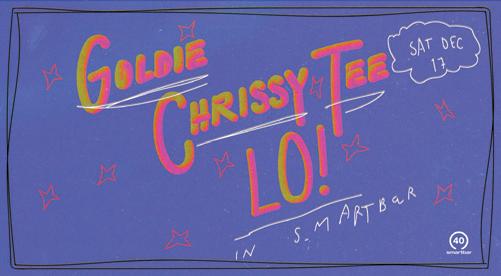

Do call911torequestanambulanceandaCrisisTrainedOfficerintheeventofanon-violent mental-healthcrisis,
Do call988SuicideandCrisisLifeline(formerlytheNationalSuicidePreventionLifeline)as neededfor24/7support.
Don’t beafraidtodiscussyourmentalhealth.Openinguptoadoctor,therapist,oratrustedfriend orlovedoneisanactofbraverythatcanhelpusbecomestrongerandhealthier.
Do continuetobeproactiveandSparktheConversationaboutsuicideprevention.

Ifyouoralovedoneareincrisisorhavingthoughtsofsuicide,pleasedial988,call1-800-273TALK(8255),ortextTALKto741741.If911isneeded,askspecificallyforanambulanceandfora CrisisInterventionTrained(CIT)policeofficer.TolearnmoreaboutNature’sGraceand Wellness,visitnaturesgraceandwellness.com.
Readtherestofthisinterviewonlineatchicagoreader.com/naturesgrace
ThissponsoredcontentispaidforbyNature'sGrace

NOVEMBER 10, 2022 - CHICAGO READER 69 3730 N CLARK ST METROCHICAGO.COM @METROCHICAGO SMARTBARCHICAGO.COM 3730 N CLARK ST | 21+ SATURDAY NOV 12 Diamond Formation pres. ‘Cyclorama’ Release Party ft. LIVWUTANG 'MAGIN' (live) CAE MONAE ARIEL ZETINA hosted by DUTCHESZ GEMINI FRIDAY NOV 11 OBJEKT JAQ ATTAQUE LEESH WEDNESDAY NOV 16 / 8PM / 18+ WILD NOTHING performing Nocturne in full + Mia Joy SKEGSS YOUNG JESUS @ SLEEPING VILLAGE MEECHY DARKO THE O’MY’S @ SLEEPING VILLAGE POND NOV 27 NOV 27 DEC 01 DEC 01 DEC 06 SUN NOV 20 KATATONIA + The Ocean Collective + Cellar Darling Laid Back | Cold Beer | Live Music @GMANTAVERN GMANTAVERN.COM 3740 N CLARK ST 21+ SAT NOV 19 THE HAPPY FITS + Daisy The Great + Phoneboy FRIDAY NOV 11 / 12AM / 18+ OFFICIAL UMBOWL OVERTIME DOOM FLAMINGO WEDNESDAY NOV 23 / 9PM / 21+ @ SLEEPING VILLAGE / LESS IS MOOR 2022 TOUR ZEBRA KATZ + MORENXXX FRIDAY NOV 25 / 8PM / 18+ PETEY + Oso Oso / Giulio Gallaro i (emcee) SATURDAY NOV 26 / 7PM / ALL AGES PIVOT GANG PRESENTS JOHN WALT DAY 5 Year Anniversary ft. Saba MFNMELO / Joseph Chilliams Frsh Waters / daedaePIVOT SATURDAY NOV 12 / 9PM / 18+ RUSSIAN CIRCLES + REZN TUE DEC 06 NORTH AMERICA TOUR 2022 POND + Cryogeyser THU DEC 01 MEECHY DARKO art can
PaidSponsoredContent
MUSIC
PICK OF THE WEEK
Chicago indie-folk outfit Tenci embrace rejuvenation on A Swollen River, a Well Overflowing

TENCI, MACIE STEWART
Sat 11/19, 9 PM, Sleeping Village, 3734 W. Belmont, $15. 21+
CONCERT PREVIEWS SATURDAY12
Meat Wave Stuck and Stress Positions open. 8:30 PM, Empty Bottle, 1035 N. Western, sold out. 21+
In March, Meat Wave barreled through a pandemicera dissection of the American labor market with the sardonic, sawtoothed “Honest Living,” laying bare the corrosive effects of depending for your survival on a morally bankrupt system that treats you like a disposable nobody. It’s an apt first single from their fourth full-length, October’s Malign Hex (Swami), and mines that misery for a tense, bristling downhill run that foregrounds the Chicago postpunk trio’s skill at weaponizing melody. But on much of Malign Hex, Meat Wave marinate in the ugliness of the world rather than stampeding through it, setting the mood slowly and needling you with every note. These songs rumble forward with the inexorable power of a tank. Joe Gac’s bass lines, as heavy as steel-plate treads, obliterate the earth as they lay down their own tracks, and he leaves plenty of space for drummer Ryan Wizniak to crank up the foreboding with thunderclap accents or fervent propulsion. Front man Chris Sutter unloads tight guitar stabs with the precision and force of a stamping press, and his controlled shouts pop like bacon grease on a hot pan. While “Honest Living” makes being an office drone sound as shitty as it is, the lumbering “Merchandise Mart”—as formidable as its massive namesake building, which once had its own zip code—makes those soul-destroying “always on” work structures feel inescapable. More bands should aspire to play songs that big. —LEOR
GALIL
Nour Mobarak See also Sun 11/13. Audience members may come and go during the concert. This event is free, but registration is requested. 6-9 PM, Renaissance Society, Cobb Hall (fourth floor), University of Chicago, 5811 S. Ellis F b
FOUR YEARS AGO, CHICAGO
Jess Shoman started Tenci as a bedroom project, and in 2019 they debuted with the album My Heart Is an Open Field. The following year, Shoman reissued My Heart through Austin indie Keeled Scales, which has put out music by similarly contemplative artists such as Arizona experimentalist Karima Walker and Big Thief guitarist Buck Meek. As Tenci gained momentum nationally, Shoman fleshed it out into a full band; these days Tenci includes drummer Joseph Farago (who makes bubbly lo-fi pop as Joey Nebulous), bassist Izzy Reidy (who fronts the indie-rock group Izzy True), and guitarist and saxophonist Curt Oren (bassist in Izzy True). This version of Tenci recorded the new A Swollen River, a Well Overflowing, whose hushed, rootsy songs hit you right in the heart—even when Shoman veils their impressionistic lyrics in cryptic details, A Swollen River feels powerfully warmhearted and restorative. Near the end of the knotty “Be,” Shoman contorts their normally soft-spoken voice into a growl just as Oren opens up into a husky, steamy sax solo that dissolves into a serene coda—Tenci can end a song gently even when it feels about to erupt, and that’s a great model for how to deal with tension in our own lives. —LEOR GALIL
Nour Mobarak’s conceptual projects are intriguing on paper and thrilling in execution. For her 2019 debut album, Father Fugue (Recital), the Cairoborn, Los Angeles-based artist created a homey collage of voice recordings. Its first half includes conversations with her father, Jean Mobarak, who speaks several languages but is only capable of retaining memories for 30 seconds. The two conjure an atmosphere of intimacy and an energizing spirit as they riffle through a variety of topics in English, Arabic, French, and Italian. These simple voices are overlaid with more vocalizing, which manifests as songs, exuberant warm-ups, and extended vocal techniques. For all its experimental qualities, the album is surprisingly cozy, and it suggests that many avant-garde vocal practices have roots in run-ofthe-mill childhood experiences, such as hearing lullabies or reciting rhymes during schoolyard games.
On the second half of the album, Mobarak sings songs in different settings, including her shower and her car. In positioning these tracks a er the pieces featuring her father, she leads us to understand how language is in some ways passed down through everyday communications with loved ones
70 CHICAGO READER - NOVEMBER 10, 2022 ll
singer-songwriter
of November 10
Recommended and notable shows and releases with critics’ insights for the
week
b ALL AGES F
HENRY JORDAN SMITH
via the cadences, rhythms, and melodies we favor.
Mobarak takes a different tack for performances. On her live recordings, such as 2020’s You Are the Audience (the Tapeworm) and 3 Performance Works (Takuroku), she uses more electronic manipulation to toy with the voice, forcing deeper consideration of the specific sonic qualities of individual phonemes. Last year’s Sphere Studies and Subterranean Bounce is especially conceptually rigorous—she worked with a multichannel installation to explore the sounds of the fungus mycelium. At her upcoming performances at the Renaissance Society, Mobarak will move around the gallery space while a real-time location system tracks her movements in order to trigger and modify sounds from a bank of recorded phonemes, which will be delivered through an eight-channel system surrounding the audience; she’ll vocalize on her own as well. Given that this technological system was created specifically for these events, I expect Mobarak to be at her most adventurous.
 —JOSHUA MINSOO KIM
—JOSHUA MINSOO KIM
SUNDAY13
Nour Mobarak See Sat 11/12. Audience members may come and go during the concert. This event is free, but registration is requested. 3-6 PM, Renaissance Society, Cobb Hall (fourth floor), University of Chicago, 5811 S. Ellis. F b
MONDAY14
Black Cross Hotel Salvation, Pink Frost, and Canadian Rifle open. 8:30 PM, Empty Bottle, 1035 N. Western. 21+ F
One of the few silver linings of the pandemic shutting down the entire concert industry for a pro-
longed stretch was that it occasionally prompted longtime musician friends to collaborate in projects they might not have had time for otherwise. Sometimes the results sound so natural—as they do in the case of local rock powerhouse Black Cross Hotel—that it feels like those people should’ve been playing together all along. Formed by synth player Andrew Ragin of the Atlas Moth and guitarist Marcus Eliopulos of Stabbing Westward, who bonded over their shared love for Killing Joke and classic 80s horror movies, this supergroup of sorts also includes Atlas Moth drummer Mike Miczek, Whipped vocalist Dee DeEmme, and bassist and producer Sanford Parker.
Black Cross Hotel’s brand-new LP, Hex, is a shivery delight that’s perfect for drawing out creepy and spooky vibes. Each track is a deep dive into the metaphorical underpinnings and outsider perspective baked into the horror genre, and DeEmme (who’s nonbinary) explores cult classics such as The Thing, The Fog, and Halloween II from a queer perspective—a very rich field of inquiry (see also the Queer for Fear documentary series by Hannibal showrunner Bryan Fuller on Shudder). On the album’s grinding first single, “Windows,” the monster of The Thing becomes a sympathetic presence amid chiming guitars and pulsing synths. But sympathy for the hunter turns into empathy with the hunted in “The Fugitive,” with its provocative, chilling buildups, surging hard-rock momentum, and needling, desperate synths. Black Cross Hotel flex their full fury with “138,” a swaggering stadium-size cover of the Misfits’ “We Are 138,” while erie synth waves cradle and support the crunchy metal riffs of “Hitchhiker.”
It’d be a shame if a debut this self-assured were a one-off, and I was glad to hear this won’t be the last we hear from Black Cross Hotel—the band have said they’ve already written another album’s worth of songs. But for now, we get to celebrate Hex at this record-release party, which features a solid bill of local acts: noise-rock trio Salvation, melodic hardcore quartet Canadian Rifle, and post-
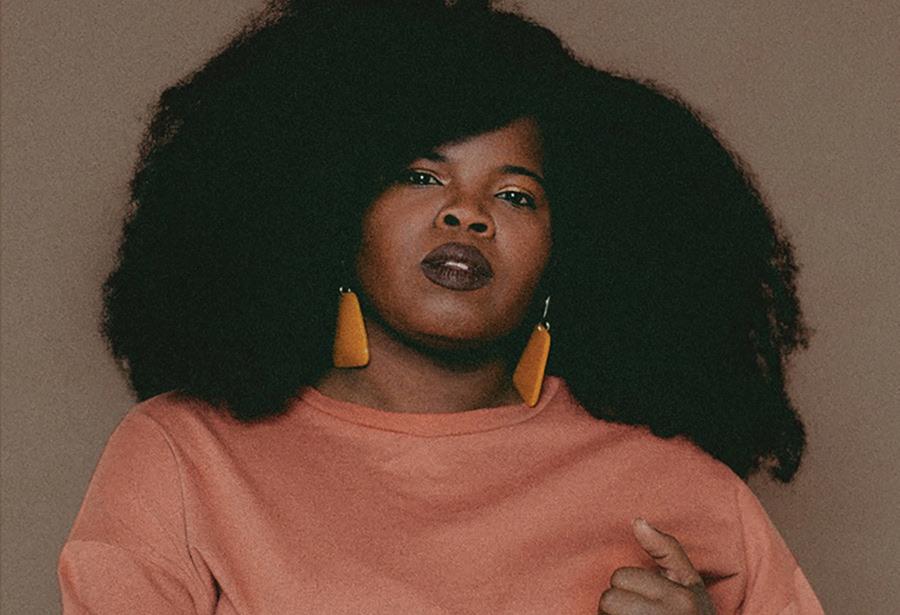

NOVEMBER 10, 2022 - CHICAGO READER 71
MUSIC
Meat Wave PATRICK HOUDE
Nour Mobarak SOTIRIS VOUGIATZIS
Danielle Ponder COURTESY SACKS & CO
MUSIC
punk band Pink Frost, who released an album of their own, Until the Summer Comes, in September.
—MONICA KENDRICK
FRIDAY18
Danielle Ponder 8 PM, SPACE, 1245 Chicago, Evanston, $18. b
New York singer-songwriter Danielle Ponder has been involved in music for much of her life, but a er her brother received a 20-year prison sentence due to a “three strikes” policy, she became an advocate for justice and pursued a legal career. She landed in the public defender’s office in her hometown of Rochester, first as a defense attorney and later as a diversity and inclusion officer, but she continued to write songs on the side—and she eventually chose to make music full-time. If she fought for her clients and her community with even half the conviction of her powerful solo debut, the September release Some of Us Are Brave , anyone would be lucky to have her in their corner.
Ponder’s commitment to justice and humanity remain intrinsic to her work, and her enormous, beautiful voice commands us to take heed of her words. She takes on the perspective of a Black man wronged by a racist criminal justice system on her 2020 track “Poor Man’s Pain,” partly inspired by the story of Willie Simmons, who was convicted of stealing $9 and sentenced to life without parole in 1982 under a racist “habitual offender” law. On Some of Us Are Brave, she weaves together that activist passion and her storytelling about more intimate themes and experiences; her chic, smoky musical arrangements are similarly multifaceted, incorporat-
ing soul, gospel, downtempo, alternative rock, and more. If there’s a sweet spot between Aretha Franklin and Beth Gibbons, Ponder has staked her flag on it with a voice that’s unmistakably her own. If you’ve been sleeping on Ponder, consider yourself on notice—she’s not likely to keep performing in venues as intimate as SPACE. —JAMIE LUDWIG
SATURDAY19
Marisa Anderson Health & Beauty open. Proof of COVID vaccination is required upon entry. 8:30 PM, Constellation, 3111 N. Western, $20. 18+


Guitarist Marisa Anderson, based in Portland, Oregon, is a veteran solo performer, but solitude isn’t usually the first thing that comes to mind when she plays. In concert and on a string of solo albums, her reverberant, gritty instrumentals tap into the capacity of blues, gospel, and folk music to bring people together. Anderson’s recent back-to-back duo projects with drummer Jim White and guitarist William Tyler achieve a synergy that could only have come from collaboration, but her new solo LP, Still, Here (Thrill Jockey), is a direct result of the stasis and isolation imposed by the COVID pandemic. Its layered construction, varied instrumentation, unhurried tempos, and melancholy vibes are all congruent with the circumstances of a touring musician who suddenly found herself with plenty of time to play but no live audience to hear her. But that doesn’t mean its songs are any less vivid than Anderson’s earlier recordings. “Night Air,” which suspends delicate piano lines over intertwined, Iberian-tinged guitar figures, evokes both the vastness of a nocturnal sky and the bereftness you might feel if you couldn’t share that view. The mournful slide guitar and restless acoustic fingerpicking on “The Fire This Time” convey the frustration and grief that Anderson experienced following the murder of George Floyd. And the album’s final track, a gorgeous, reflective performance of the traditional “Beat the Drum Slowly,” comes full circle back to the kind of music she was recording a decade ago. —BILL MEYER

Tenci See Pick of the Week, page 70. Macie Stewart opens. 9 PM, Sleeping Village, 3734 W. Belmont, $15. 21+

ALBUM REVIEWS
Ben Lamar Gay, Certain
reveries
Intenational Anthem intlanthem.bandcamp.com/album/certainreveries
In November 2020, Chicago multi-instrumentalist Ben LaMar Gay debuted his long-form composition Certain Reveries at a London Jazz Festival livestream show. The performance was no mere park-and-play: wearing a black hooded shawl that recalled the grim reaper, Gay played electronics, synths, and of course his cornet, and in collaboration with brilliant percussionist Tommaso Moretti, he guided audiences through haunting dream-
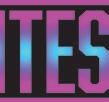
Find more music listings at chicagoreader.com/musicreviews

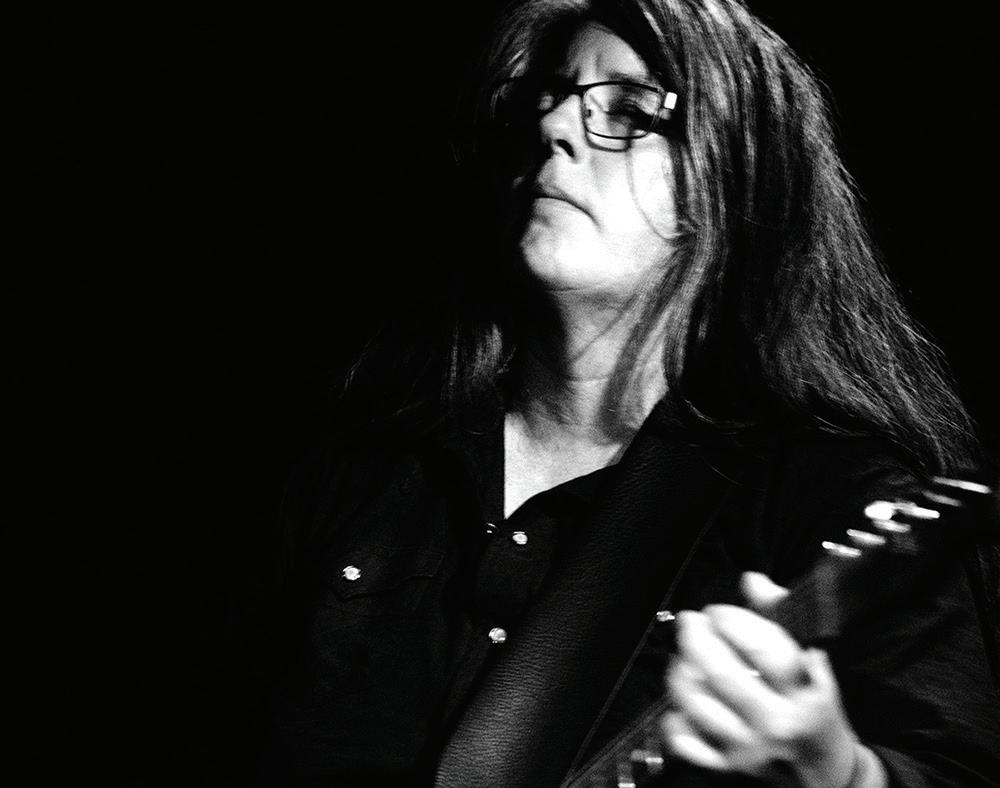
scapes for more than an hour.

Almost two years a er the original stream, Gay is releasing the audio from that remarkable live performance on local label International Anthem, organized into 11 tracks. The original Certain Reveries stream was patently a pandemic artwork, down to a short-film interlude shot inside Gay’s apartment. The audio version abstracts the performance somewhat, though its devastating context is always close at hand. Gay’s lamenting phrases in “Skin” sound like they’re coming from behind a curtain; in actuality, on that prevaccine occasion, he and Moretti wore masks because they were performing together in close quarters. Certain Reveries also prods at the boundary between real life and memory, so unnervingly blurred during the nadir of “shelter in place.” Gay reprises the first section of Certain Reveries (“You Ain’t Never Lied” on the album) at the end of the composition (now titled “New Tongues Tell Old Fibs”), repeating its title refrain and playing back distorted samples of his and Moretti’s earlier improvisations. But in comparison to the stunning, sobering 12-minute penultimate track, “Água Futurism” (which sounds as though Gay and Moretti have been building up to it the whole evening), “New Tongues Tell Old Fibs” is practically falling action. If you’re just listening to the album, you won’t be able to take in the entrancing sight of Gay twirling lights under his cloak like a ghoulish fire dancer. But in “Água Futurism” you can hear deliverance loud and clear in his baleful cornet solos and Moretti’s drumming, which are assertive at first before dropping to a delicate flutter. Death and life lock forearms not to grapple but rather for one more dance.
—HANNAH EDGAR
Smino, Luv 4 rent
Zero Fatigue/Motown zerofatigue.com

Smino is simultaneously experimental and intentional—it’s a trip. His music feels better with each listen. The midwest breeds multitalented artists, including rappers who love to sing, but Smino (born in Saint Louis with roots in Chicago) is more than a rapper who sings or a singer who raps. With his endearing falsetto, undeniable charm, and frequent collaborations (including with Chicagoans Monte Booker and Ravyn Lenae), he makes music that’s great for the cookout, the kickback, and—importantly—the bedroom. Oozing with sex appeal and blessed with great hair, Smino has a surplus of personality, knowledge, and control. Though his music drips familiarity and sometimes evokes fellow explorative hip-hop acts such as OutKast or Kendrick Lamar, he’s got enough fresh ideas that it never feels plagiarized. Smino’s lyrics and musical decisions come chock-full of respect for pop culture and music history, and his unique voice shines through from the core.
Smino’s new third album, Luv 4 Rent , clearly expresses his artistic growth since his 2018 breakout album, Noir, with its beat selection, big features (including J. Cole), instrumental choices, and vocal direction. Thick with smoky melodies, the music weaves between hip-hop, R&B, gospel, and straightup pop—and it’s all abundantly Black. “Blu Billy” is good and breezy, while “Pudgy” is a big pulsating hug with a stellar Lil Uzi Vert verse. The guest spot from Tampa rapper Doechii on “Pro Freak” will be a revelation for anyone sleeping on her abilities,
72 CHICAGO READER - NOVEMBER 10, 2022 ll
Enter to win! chicagoreader.com/contests continued from 71
Marisa Anderson LAURENT ORSEAU
and Smino shows that he’s not just a playful crooner—he’s a real MC with a wordplay that isn’t to be undervalued. Luv 4 Rent has a certain je ne sais quoi—it’s sharp, loose, and satisfying. Longtime Smino fans will love it, and it’ll introduce new listeners to a rising talent who shows no signs of slowing down.
 —CRISTALLE BOWEN
—CRISTALLE BOWEN
Smut, How the Light Felt Bayonet smutonline.bandcamp.com/album/how-the-lightfelt
Alt-rock five-piece Smut formed in Cincinnati in 2014, and within a couple years, their shoegazedappled heavy rock had caught the ear of Bully front woman Alicia Bognanno, who offered them a crucial tour-support spot. In the time since Smut’s previous full-length, 2017’s End of Sam-soon, they’ve relocated to Chicago, dialed back the aggression in their wall of sound, and shi ed to a more plaintive approach to songwriting. The band’s new How the Light Felt (Bayonet) leans into shoegaze’s ocean-size capacity for tranquility, and this gen-

tler approach sharpens every little detail. They toy with elements from outside shoegaze’s blissful lexicon, though they don’t all land gracefully; the brief drum ’n’ bass loop that perks up a lonesome guitar melody on “Morningstar” goes over a lot better than the cheesy record scratches that stumble into the acoustic picking on “Unbroken Thought.” Smut excel when they console, such as on the restorative “After Silver Leaves.” Front woman Tay Roebuck sings about a former lover who called her by another woman’s name, a painful relationship that her younger self grew out of when she no longer needed the validation; her kindhearted, mellow vocals could help someone in a similar spot imagine a better future for themselves.
—LEOR GALIL

Sweet Cobra, Threes Hawthorne Street
sweetcobra.bandcamp.com/album/threes
Born of the Fireside Bowl hardcore scene, local trio Sweet Cobra have become synonymous with heavy music in Chicago over the past two decades—but they’ve also evolved every step of the way. They
started off as a fairly typical early-aughts doomy hardcore act, and though they’ve shi ed away from hardcore with proggy, sludgy, and melodic forays, they’ve consistently delivered tunes with their signature pummeling attack. On their brand-new fi h album, Threes, bassist and vocalist Tim Remis, guitarist Robert “Grumpy” Lanham, and drummer Jason Gagovski (who’s releasing the record on his Hawthorne Street label) have landed somewhere in the middle of their earlier work and at the same time far beyond anything they’ve created before. They’ve all but done away with straightforward melodic hardcore, and now they’re interpreting their usual heaviness through layers of lush tones and waves of warm guitar rather than a cacophonous wall of distortion. And when they add elements of dreamy shoegaze, sky-high space rock, earthy Americana, and blissed-out alternative rock, you could describe Threes as “post-everything.” My favorite thing about the record is also what surprised me the most—it’s incredibly catchy. Sweet Cobra will never be a pop band, but here they get pretty damn close. Twenty years into their career, they’re still reinventing themselves, and on Threes the payoff is the best yet. —LUCA CIMARUSTI v
NOVEMBER 10, 2022 - CHICAGO READER 73
MUSIC 11/16 Desafío Candente 11/23 Harmonía del Parnàs WORLD MUSIC WEDNESDAY SERIES FREE WEEKLY CONCERTS, LINCOLN SQUARE OLDTOWNSCHOOL.ORG 4544 N LINCOLN AVENUE, CHICAGO IL OLDTOWNSCHOOL.ORG • 773.728.6000 THURSDAY, NOVEMBER 10 8PM Abigail Washburn & Wu Fei In Maurer Hall FRIDAY, NOVEMBER 11 8PM Kathy Mattea In Maurer Hall SATURDAY, NOVEMBER 12 8PM Paul Thorn In Maurer Hall SATURDAY, NOVEMBER 19 9:30PM Erwin Helfer, Spain's Lluis Coloma & Chicago Gospel A Blues, Boogie and Gospel Keyboard Party featuring Cliff Dubose, Richard Gibbs and Bishop Dwayne Mason • In Szold Hall SUNDAY, NOVEMBER 20 7PM Zoë Keating in Maurer Hall SUNDAY, NOVEMBER 27 4PM The Nut Tapper featuring Reggio "The Hoofer" McLaughlin in Maurer Hall THURSDAY, DECEMBER 1 8PM Peter Asher & Jeremy Clyde in Maurer Hall FRIDAY, DECEMBER 2 8PM Dan Tyminski Duo with Gaven Largent in Maurer Hall SATURDAY, DECEMBER 3 8PM Irish Christmas in America in Maurer Hall SUNDAY, DECEMBER 4 7PM Over the Rhine An Acoustic Christmas • In Maurer Hall UPCOMING CONCERTS AT NEW SHOWS ANNOUNCED • ON SALE NOW 11/19 Patti Smith and Jackson Smith 1/26 & 1/27 Patty Griffin with special guest Parker Millsap
Ben LaMar Gay (right) with Tommaso Moretti CHARLES BOURIL
Smino DENITA TURNER
EARLY WARNINGS
Ron Pope 5/20/2023, 7:30 PM, Park West b Protomen, Cybertronic Spree 2/24/2023-2/25/2023, 9 PM, Reggies Rock Club, 17+ Quasi 3/25/2023, 8:30 PM, Empty Bottle
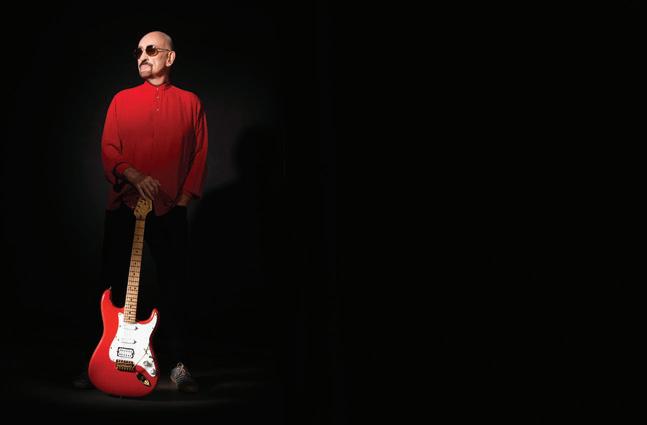
Thomas Rhett, Cole Swindell, Nate Smith 7/28/2023, 7:30 PM, United Center b Caroline Rose 4/21/2023, 8:30 PM, Thalia Hall, 17+
Royal Thunder 1/7/2023, 8 PM, Cobra Lounge, 17+ Emma Ruth Rundle, Patrick Shiroishi 4/4/2023, 8:30 PM, Thalia Hall, 17+
Saves the Day, Spitalfield 12/15, 8:30 PM, House of Blues, 17+
See You Next Tuesday, Closet Witch, Pains, Nerver, Bekind 1/13/2023, 8 PM, Beat Kitchen, 17+
NEW
Sammy Adams, Danny G 12/10, 8 PM, Subterranean, 17+
Armand Hammer, Yungmorpheus, Mother Nature (Tomorrow Never Knows Festival) 1/20/2023, 9 PM, Schubas, 18+
Arrivals 12/31, 9 PM, Reggies Rock Club, 17+
Avery Sunshine 12/26-12/27; 1/4/2023-1/5/2023, 8 PM, City Winery b Awfultune 4/5/2023, 8 PM, Beat Kitchen, 18+ Rachel Baiman, Seth Walker 4/14/2023, 8:30 PM, FitzGerald’s, Berwyn Jessie Baylin 2/16/2023, 7:30 PM, SPACE, Evanston b Big Head Todd & the Monsters, Freddy Jones Band 1/21/2023, 7:30 PM, Riviera Theatre, 18+
Bonny Doon 1/19/2023, 8:30 PM, Empty Bottle
Borgore, Lucii, Tynan, Chassi 12/31, 10 PM, Concord Music Hall, 18+
Luis R Conriquez 11/25, 9 PM, Rosemont Theatre b Damager, Superkick, Nora Marks 11/28, 8 PM, Schubas, 18+
A Day to Remember, Wage War 12/12, 8 PM, Chicago Theatre b
Dos Santos 12/31, 10 PM, Beat Kitchen Dvsn 3/30/2023, 8 PM, Radius Chicago, 18+ Edward & Graham 11/26, 8:30 PM, Lincoln Hall, 18+ Eighth Blackbird 1/18/2023, 7:30 PM, City Winery b Elderbrook 3/10/2023, 6 PM, Concord Music Hall b
The English Beat 12/3-12/4, 8 PM, City Winery b
Evasive Actions, Distants 12/10, 9 PM, Gman Tavern
Fisher 12/31, 10 PM, Radius Chicago, 18+ Folkstage New Year’s Eve Celebration of Rich Warren featuring Tom Paxton, Reggie Harris, Claudia Schmidt, Vance Gilbert, Anne Hills, and more 12/31, 8 PM, Szold Hall, Old Town School of Folk Music b
Forever Deaf Fest IV featuring Ready for Death, Sweet Cobra, Rlyr, Dust Biters, Black Cross Hotel, We Killed the Lion, and more 1/20/2023-1/21/2023, 7 PM, Beat Kitchen, 17+ Ali Gatie, Johnny Orlando 11/29, 7:30 PM, House of Blues b
Goldie, Chrissy Tee, Lo! 12/17, 10 PM, Smart Bar Ha-Ash 4/15/2023, 8 PM, Rosemont Theatre, Rosemont b Jerry Harrison and Adrian Belew 2/25/2023, 8 PM, the Vic, 18+
Maya Hawke 3/18/2023, 8 PM, Metro b
Drew and Ellie Holcomb 2/9/2023-2/11/2023, 8 PM, SPACE, Evanston b Inhaler 3/24/2023, 7:30 PM, Riviera Theatre b
International Anime Music Festival featuring Kizuna AI Original Singeroid #KZN, Himehina, Gumi, Marinasu, Lilypse 3/4/2023, 7:30 PM, Riviera Theatre b
Juice Wrld Day Global Celebration of Life 12/8, 6 PM, United Center b Kainalu, J.Y.N. 12/3, 9 PM, Schubas, 18+
Aaron Kamm & the One Drops, Soldial 2/16/2023, 8:30 PM, FitzGerald’s, Berwyn King Tuff 3/31/2023, 10 PM, Empty Bottle
Koffin Kats 1/20/2023, 9 PM, Reggies Rock Club, 17+
Dave Koz with Rick Braun, Peter White, Keiko Matsui, and Rebecca Jade 12/8, 8 PM, Chicago Theatre b
Ladysmith Black Mambazo 3/25/2023, 5 and 8 PM, Maurer Hall, Old Town School of Folk Music b
Delvon Lamarr Organ Trio 3/19/2023, 5 and 8 PM, SPACE, Evanston b Larrenwong 12/15, 9 PM, Schubas, 18+ Letdown 12/4, 8:30 PM, Schubas, 18+
Local H 12/31, 10 PM, Bottom Lounge
Loudness, Midnight Devils, Pipe, Siin 5/19/2023, 8 PM, Reggies Rock Club, 17+ Mariachi Herencia de Mexico 12/16, 7 PM; 12/17, 2, 5, and 8 PM, Maurer Hall, Old Town School of Folk Music b Dave Mason 2/20/20232/21/2023, 8 PM, City Winery b
Mormor 1/28/2023, 9 PM, Lincoln Hall, 18+
Motel Breakfast, Sylmar 12/1, 8 PM, Gman Tavern Muse, Evanescence 2/25/2023, 6:30 PM, United Center b Night Moves 1/14/2023, 9 PM, Lincoln Hall, 18+
The North 41, Sneezy, Bumpus 11/25, 9 PM, Lincoln Hall, 18+
NRBQ 3/16/2023, 8:30 PM, FitzGerald’s, Berwyn b 107.5 WGCI Big Jam featuring Moneybagg Yo, Nardo Wick, GloRilla, Saucy Santana, Muni Long, Tink, PGF Nuk, Sonta, Sleazyworld Go, Katie Got Bandz, and more 12/3, 6:30 PM, United Center b PH-1 2/5/2023, 6:30 PM, Concord Music Hall b
Polymath featuring Adonis Childs, Mazen Rimawi, Niiiigggggaaaaaaaa 11/26, 10 PM, Gman Tavern
Show Me the Body, Jesus Piece, Scowl, Zulu, Trippjones 3/16/2023, 7 PM, Metro, 18+ Shygirl 3/31/2023, 9 PM, Thalia Hall, 17+
Sincere Engineer, Fluorescents, Droughts, Rodeo Boys 1/14/2023, 8 PM, Bottom Lounge, 17+
Sound of Animals Fighting, Hail the Sun, Concrete Castles, Kitty, DJ Wstdyth 1/18/2023, 6 PM, Concord Music Hall, 17+
Stacked Like Pancakes, Brass Iron Skillet 12/11, 8 PM, Subterranean, 17+ Spencer Sutherland 4/8/2023, 7 PM, House of Blues b Tamikrest 1/11/2023, 8:30 PM, Maurer Hall, Old Town School of Folk Music b Tedeschi Trucks Band 3/17/2023-3/18/2023; 3/31/2023-4/1/2023, 8 PM, Chicago Theatre b Trash Fiasco, Lollygagger, Torch the Hive, Bin Chicken 1/7/2023, 9 PM, Reggies Music Joint Tvboo, Toadface, Ahee 12/9, 8:30 PM, Bottom Lounge, 17+
Ultimate Freestyle Super Jam featuring Stevie B, Deborah Cox, Lisa Lisa, K7 with TKA, Judy Torres, Lisette Melendez, Cynthia, Noel, George Lamond, MGM Guarnera Brothers, and more 11/26, 8 PM, Rosemont Theatre, Rosemont b
Unknown Mortal Orchestra 4/8/2023, 7 PM, Radius Chicago b Daniel Villarreal 2/2/2023, 7:30 PM, SPACE, Evanston b Weyes Blood 3/11/2023, 9 PM, Riviera Theatre, 18+ Yo La Tengo 3/24/2023, 8 PM, Metro, 18+
Yonder Mountain String Band 2/3/2023-2/4/2023, 8 PM, SPACE, Evanston b Zedd 12/29, 10 PM, Radius Chicago, 18+
b ALL AGES F

GOSSIP WOLF
UPDATED
Advance Base, Spencer Radcliffe 11/28, 8 PM, Hideout, canceled Blink-182, Turnstile 5/6/20235/7/2023, 7:30 PM, United Center, show added b Easy Life 5/4/2023, 8 PM, SPACE, Evanston, rescheduled b Hoodoo Gurus 5/14/2023, 8 PM, City Winery, rescheduled b
Riders in the Sky 5/7/2023, 7 PM, Maurer Hall, Old Town School of Folk Music, rescheduled b
A Very Countess Christmas featuring Luann de Lesseps 12/1; 12/3-12/4, 7:30 PM, Park West, shows added, 18+
UPCOMING
Alyona Alyona, Jerry Heil, Kola 11/26, 8 PM, Logan Square Auditorium b Bit Brigade, Super Guitar Bros 11/25, 9 PM, Reggies Music Joint
Bled Tape 11/28, 8:30 PM, Empty Bottle F Bluewater Kings Band 11/30, 7 PM, Chop Shop, 18+ F Alex Carpani, Jason Blake 12/1, 7:30 PM, Bananna’s Comedy Shack at Reggies Tim Daisy, Ethan Phillion, and Jon Irabagon; Josh Berman & Jason Roebke 11/27, 9 PM, Hungry Brain Álvaro Díaz 12/3, 8 PM, Chop Shop
Homesafe, A Will Away, Valleyheart, Overgrow 12/1, 5:30 PM, Cobra Lounge b Midwxst, Dro Kenji 11/25, 8 PM, Reggies Rock Club b Roya Naldi 11/25, 9 PM, Hungry Brain
Pretty Liyah 11/26, 5 PM, the Promontory b
Sanctum Dark Music Festival night one featuring Adult., Psyche, Hide, Blu Anxxiety, Visceral Anatomy, Andi 11/25, 6 PM, Thalia Hall, 17+
Sanctum Dark Music Festival night two featuring Boy Harsher, So Crash, Riki, and more 11/26, 6 PM, Thalia Hall, 17+
Sanctum Dark Music Festival night three featuring Gatekeeper, Void Vision, Plack Blague, and more 11/27, 6 PM, Empty Bottle v
THIS WEEK local indie rockers Divino Niño and Chicago visual artist Roland Santana host Suelta , a three-day celebration of music and art at House of Vans . Divino Niño singer- guitarist Camilo Medina met Santana last year at one of his gallery shows. “I immediately fell in love with his art, and we pretty much became friends,” Medina says. Santana has also introduced Medina to Chicago’s queer arts and nightlife scenes. The two of them conceived of Suelta this summer, and since Medina got back from tour a few weeks ago he’s spent every waking moment painting at Santana’s studio. This project has given Medina a new perspective on visual art. “It has slowed me down,” he says. “I’ve fallen more in love with the physical aspect of visual arts—like, how the material reacts.” On Thursday, Santana and Medina lead a painting workshop. On Friday, Divino Niño headline a show with Conjunto Primitivo and Cabeza de Chivo. Suelta ends on Saturday with DJs and an art show. All events are free with RSVP, but registration is full for Thursday.
Chicago hyperpop artist Folie caught this wolf’s ear last year with 123! , a wild full-length mixtape. She’s been working with darkwave-leaning local artist Forget Basement, and this week they debuted as WhoTF with the whimsically intense single “Wendy Carlos.” It features vocals from underground star Fraxiom, who spits over cartoon- carnival percussion and blownout synths. The duo released “Wendy Carlos” through Umru’s Song Music LLC label, and they’re finishing an EP.
This town has more breezy indie rockers than you can shake a stick at, but Late Nite Laundry ’s laid-back resplendence stands out. On Friday, they dropped a self- titled EP that applies their gentle touch to sweet soul and playful tropicalia. Late Nite Laundry pull off that tricky balance with style; the so singing of guitarist Ari Lindo on the plush “Floating” enhances the song’s lovey-dovey buoyancy. —J.R. NELSON AND LEOR GALIL
Got a tip? Tweet @Gossip_Wolf or email gossipwolf@chicagoreader.com.
74 CHICAGO READER - NOVEMBER 10, 2022 ll
Never miss a show again. Sign up for the newsletter at chicagoreader. com/early
Dave Mason COURTESY THE ARTIST
A furry ear to the ground of the local music scene
CHICAGO SHOWS YOU SHOULD KNOW ABOUT IN THE WEEKS TO COME
WOLF BY KEITH HERZIK
LOADED QUESTION

My friend gives earth-shattering blow jobs
Rerunning a popular 2018 column about a lopsided sexual arrangement
By DAN SAVAGE








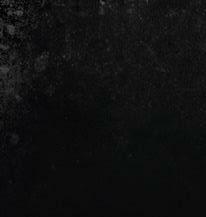
Q : I am a 24-year-old straight guy who recently broke up with my girlfriend of more than four years. One of the reasons we broke up was a general lack of sexual compatibility. She had a particular aversion to oral sex—both giving and receiving. I didn’t get a blow job the whole time we were together. Which brings me to why I am writing: One of my closest friends, “Sam,” is a gay guy. Shortly a er breaking up with my girlfriend, I was discussing my lack of oral sex with Sam, and he said he’d be willing to “help me out.” I agreed, and Sam gave me an earthshattering blow job. I was glad to get some and had no hang-ups about a guy sucking me. Since then, Sam has blown me three more times. My problem is I am starting to feel guilty and worry I am using Sam. He’s a very good buddy, and I’m concerned this lopsided sexual arrangement might be bad for our friendship.









Sam knows I am not into guys and I’m never going to reciprocate, and I feel like this is probably not really fair to him. But these are literally the only blow jobs I’ve received since I was a teenager. What should I do? —TOTALLY HAVE RESERVATIONS OVER









ADVANTAGE TAKING





A: Only one person knows how Sam feels about this “lopsided sexual arrangement,” THROAT, and it isn’t me. Zooming out for a second: People constantly ask me how the person they’re fucking or fisting or flogging feels about the fucking or fisting or flogging. Guys write to ask why women ghosted them; women write to ask if their boyfriends are secretly gay. And while I’m happy to speculate, I’m not a mind reader. Which means I have no way of knowing for sure why some woman ghosted you or whether your boyfriend is gay. Or in your case, THROAT, I have no way of knowing how Sam feels about the four no-recip blow jobs he’s given you. Only Sam knows.


And that’s why I wrote you back, THROAT, and asked you for Sam’s contact information. Since you were clearly too afraid to ask Sam yourself (most likely for fear the blow jobs would stop), I offered to ask Sam on your behalf. I wasn’t serious—it was my way of saying, “You should ask Sam.” But you sent me Sam’s contact info, and a few minutes later I was chatting with Sam.


“Yes, I have been sucking my straight friend’s cock,” Sam said to me. “And I am


flattered he told you I was good at it. That’s an ego booster!”
Sam, like THROAT, is 24 years old. He grew up on the east coast and met THROAT early in his first year at college. Sam came out at the end of his freshman year, to THROAT and his other friends, and he now lives in a big city where he works in marketing when he isn’t sucking off THROAT. My first question for Sam: Are you one of those gay guys who gets off on “servicing” straight guys?


“I’ve never done anything with a straight guy before this,” said Sam. “So, no, I’m not someone who is ‘into servicing straight guys.’ I have only ever dated and hooked up with gay guys before!”



So, why offer to blow THROAT?


“I didn’t know until after he broke up with his girlfriend that he hadn’t gotten a blow job the whole time they were together—four years!” Sam said. “When I told him I’d be happy to help him out, I was joking. I swear I wasn’t making a pass at my straight friend! But there was this long pause, and then he got serious and said he’d be into it. I wondered for a minute if it would be weird for me to blow my friend, and there was definitely a bit of con-
vincing each other that we were serious. When he started taking his clothes off, I thought, ‘So this is going to happen.’ It was not awkward after. We even started joking about it right away. I have sucked him off four more times since then.”
For those of you keeping score at home: Either THROAT lost count of the number of times Sam has blown him—THROAT said Sam has blown him three more times after that first blow job—or THROAT got a fifth blow job in the time that elapsed between sending me his letter and putting me in touch with Sam.
So, does this lopsided sexual arrangement—blowing a straight boy who’s never going to blow him back— bother Sam?
“I suppose it is a ‘lopsided sexual arrangement,’”
SAVAGE LOVE
said Sam. “But I don’t mind. I really like sucking dick and I’m really enjoying sucking his dick. He has a really nice dick! And from my perspective, we’re both having fun. And, yes, I’ve jacked off thinking about it after each time I sucked him. I know— now—that he thinks it is a bit unfair to me. But I don’t feel that way at all.”
So, there is something in it for Sam, THROAT. You get the blow jobs, Sam gets the memories. (Memories that he jerks off to later.) And Sam assumes that at some point, memories are all he’ll have.
“He will eventually get into a relationship with a woman again, and our arrangement will end,” said Sam. “I only hope nothing is weird between us in the future because of what has happened in the past few weeks.”
I had one last question: Sam is really good at sucking cock—he gives “earth-shattering” blow jobs, according to THROAT—but is THROAT any good at getting his cock sucked? As experienced cocksuckers know, a person can suck at getting their cock sucked: They can just lay/ stand/sit there, giving you no feedback, or be too pushy or not pushy enough, etc.
“That’s a really good question,” Sam said. “I have to say, he is very good at it. He really gets into it, he moans, he talks about how good it feels, and he lasts a long time. That’s part of what makes sucking his cock so much fun.” v
Beginning next week, Savage Love will be exclusively available online at Savage.Love.
@fakedansavage
NOVEMBER 10, 2022 - CHICAGO READER 75
Come Over to Squirt.org and Join the Action. Hosting. We’re 10 DAYS FREE FUN FOR EVERY NEW GUY
JOBS
Northwestern Memorial HealthCare seeks Sr Systems Engineers for Chicago, IL location to provide tech guidance & support for computing systems & systems integration across server/ distributed system environment. Bachelor’s in Comp Sci/Electronics Eng or related field+7yrs exp req’d. Req’d Skills: 3yrs w/SCCM: migration, Configuration Mngr, Report Builder. 2yrs w/PowerShell scripting; SSRS; AdminStudio; Windows 10 OpSys servicing & deployment. Exp must incl Citrix Workspace; leading deployment projects; ServiceNow. Requires rotating 24hr on call availability. Background check & drug screen req’d. Apply online: http://jobseeker.nm.org/ Req ID: REF41789E
Sr. Preconstruction Engineer at Clayco, Inc. in Chicago, IL. Assist in bidding construction projects by preparing estimates, proposals and soliciting bids. Requires Bachelors (Civil Engr./ Construction Mngmnt) & 3 yrs. exp. Apply: https:// www.claycorp.com
(Waukegan, IL) Yaskawa America, Inc. seeks Mechanical Design Engineer B w/Bach or for deg equiv in ME & 2 yrs exp in job offer or eng des exp from initial concept through manuf release, incl areas of des, devp, manuf & com. Must have exp in applic of Servo &/or Drive amplif plus contr & in various mach method incl des, fabric & finish. Apply to HR, 2121 Norman Drive South, Waukegan, IL 60085 or online https:// www.yaskawa.com/ about-us/careers
Data Integration Developer, Chicago, IL, for Aspen Dental Management, Inc. (ADMI): Responsible for dev. & maintenance of data transfer & all processes supporting acquisition of data design, and architecture of new Extract, Transform and Load (ETL) processes & adherence to standards developed by the data team for all integration processes.
Req’d: Bach. (or foreign equiv.) in IT, Comp. Sci., Software or Electronics Eng., or related tech. discipline & 8 yrs. of experience designing & implementing ETL processes & using ETL tools.
May work remotely up to 3 days/wk. Resumes to code JB-DID, J. Ximenes, ADMI, 800 W. Fulton Market, Chicago, IL 60607.
Lead Consultant Developer (Professional Services) Thoughtworks seeks Lead Consultant Developer (Professional Services) to work in Chicago, IL & various unanticipated U.S. locations to lead largescale, custom-designed, enterprise-level software development projects that use object-oriented technologies, such as Java, Ruby, or .NET.
Must have Bachelors in Computer Science, Computer or Electrical Engineering, Information Systems or related field.
Must have 3 years exp. in the job offered, Consultant, Developer or related IT position. Must have at least thirty-six (36) months experience in: (1) Participating at all stages of the software delivery life-cycle, including analysis, development, testing and deployment. Must have at least twelve (12) months experience in: (1) Using Agile development methodologies including Continuous Integration, Extreme Programming, Continuous Delivery, Test-Driven Development and pair programming; (2) Using test automation frameworks to test at different levels, including unit, functional and integration testing; (3) Developing software applications using Java, Ruby or .NET; (4) Serving as a liaison between client and development team to define scope and technical direction of the project including requirements gathering and design discussions and managing project deliverables and timeframes; and (5) Coaching and mentoring junior developers in all aspects of software development, including Agile development methodologies. At least 80% travel across U.S. Send resume to ijobs@thoughtworks.com w/ Job ID EH-LCD2022.
Workforce.com (Chicago, IL) seeks Lead Software Developer to design software applications/research customer experiences & translate them into changes w/ in Workforce.com’s codebase/write software/ test software & deploy to clients. Must take & pass pre-interview coding test. Submit resumes to careers@workforce.com, reference Job ID: Lead Software Developer in the subject line.
Administrative Assistant: Bachelor’s degree in Any major req., $64,542/ yr, F/T, Resume to Jin Hyung Cho, Khan Trans, Inc., 2251 Nicholas Blvd, Elk Grove Village, IL 60007
TransUnion, LLC seeks Managers for Chicago, IL location to manage & support jr colleagues on Analytics team. Master’s in Stats/Applied Math/ Actuarial Sci/related Quantitative field+2yrs exp req’d. Req’d skills: extensive exp w/credit policy & data, new account underwriting, credit-risk mgmt; dev of stats models(logistic, GBM/XGBoost scorecards, decision trees) to predict risk or marketing outcomes; generating insights & ensuring dissemination, understanding; data query languages (SQL, R); Hadoop, Hive, Spark, Dremio & Pig on Linux & PC platforms; segmentation analysis, logistic regression, performance analysis, generalized linear models w/CGLM, tree models (Random forest, Gradient Boosted trees), GBM, Artificial Neural Network models; delivering analytical insights & recommendations in succinct & compelling presentations for internal & external customers & executive audience. 60% telecommuting permitted. Apply online: www.transunion.wd5. myworkdayjobs.com, Requisition ID: 19019502
TransUnion Rental Screening Solutions, Inc. (wholly owned subsidiary of TransUnion, LLC) seeks Sr. Developers for various & unanticipated worksites throughout the US (HQ: Chicago, IL) to design, dev, maintain, install & test sw apps. Master’s in Comp Sci/Eng/Info Sys/Info Tech or any Eng/related field+2yrs exp or Bachelor’s in Comp Sci/Eng/Info Sys/ Info Tech or any Eng/ related field+5yrs exp req’d. Req’d skills:. NET dev (Visual Studio), TFS; full stack dev (C#, Angular); REST Web services; ORM tools, Entity; Database dev (advanced SQL); TDD; Agile/ Scrum; AWS cloud dev. 100% telecommuting permitted. Apply online: https://transunion. wd5.myworkday jobs.com/transunion, REF: 19019468
SENIOR SAP SCM/TM CONSULTANT
Novigo, Inc. has multiple positions available in Chicago, IL: Senior SAP SCM/TM Consultant (Ref# 5803253) Telecommuting permitted. Travel required 80%. To apply, send resume and transcripts w/ job title and Ref# 5803253 to recruitment @novigo.com. EOE.
Salesforce Program ManagerGroupon, Inc. is seeking a Salesforce Program Manager in Chicago, IL w/ the following responsibilities: Work directly w/ our global sales & service stakeholders to understand their operational requirements. Apply at www.grouponcareers.com by searching keyword R27262
RESEARCH
Have you had an unwanted sexual experience since age 18? Did you tell someone in your life about it who is also willing to participate? Women ages 18+ who have someone else in their life they told about their experience also willing to participate will be paid to complete a confidential online research survey for the Women’s Dyadic Support Study. Contact Dr. Sarah Ullman of the University of Illinois at Chicago, Criminology, Law, & Justice Department at ForWomen@uic. edu, 312-996-5508. Protocol #2021-0019.
PROFESSIONALS & SERVICES
CLEANING SERVICES CHESTNUT ORGANIZING AND CLEANING SERVICES: especially for people who need an organizing service because of depression, elderly, physical or mental challenges or other causes for your home’s clutter, disorganization, dysfunction, etc. We can organize for the downsizing of your current possessions to more easily move into a smaller home. With your help, we can help to organize your move. We can organize and clean for the deceased in lieu of having the bereaved needing to do the preparation to sell or rent the deceased’s home. We are absolutely not judgmental; we’ve seen and done “worse” than your job assignment. With your help, can we please help you? Chestnut Cleaning Service: 312-332-5575. www. ChestnutCleaning.com
Michigan holiday getaway for 16 people. 6 bedrooms with designer kitchen! Totally private! Exclusive use of 400 acres w/lake, woods and walking trails. 100 miles from Chicago. Unplug for 5 nights Nov 23-27 $7,200 269-463-6315
76 CHICAGO READER - NOVEMBER 10, 2022 ll
ADULT SERVICES Danielle’s Lip Service, Erotic Phone Chat. 24/7. Must be 21+. Credit/ Debit Cards Accepted. All Fetishes and Fantasies Are Welcomed. Personal, Private and Discrete. 773-935-4995 CLASSIFIEDS JOBS GENERAL REAL ESTATE RENTALS FOR SALE NON-RESIDENTIAL PROFESSIONALS & SERVICES CLEANING RESEARCH ADULT SERVICES WANT TO ADD A LISTING TO OUR CLASSIFIEDS? Email details to classified-ads@chicagoreader.com Nov. 14: The return of barbecue ronin Heffer BBQ @therealhefferbbq Nov. 21: An all-star Umamicue Friendsgiving @umamicue Nov. 28: Thanksgiving break Dec. 5: Spotlight on Lao cuisine with Laos to Your House @laostoyourhouse773 Dec. 12: Kimski rumspringa with Won Kim @revisecmw Dec. 19: First night of Hanukkah with Zeitlin’s Delicatessen and Schneider Provisions @zeitlinsdelicatessen @schneider_provisions See chicagoreader.com/food-drink/ for weekly menus and ordering info The leaves are falling over the Kedzie Inn, and that means it’s a new lineup for Monday Night Foodball the Reader’s weekly chef pop up series. Follow the chefs, @chicago_reader, and @mikesula on Instagram for weekly menu drops, ordering info, updates, and the stories behind Chicago’s most exciting foodlums.














































NOVEMBER 10, 2022 - CHICAGO READER 77 ORDER TODAY & RECEIVE A $100 GIFT CARD The Multi-Sport Pack is included at no additional cost. Must sign up for service by 11/9/22. Only available with packages starting at $84.99/mo., excluding America’s Everything Pack, through 1/12/23. Reliability Guarantee legal disclaimer: Limited time offer, subject to change. Available only to new or returning former customers. Guarantee covers signal loss outages due to normal weather and/or technical issues. Does not cover signal loss outages due to user error. Does not cover changes in programming content. To receive outage credits, you must contact DISH customer service by phone or chat within 72 hours of the outage. Upon verifying the outage, DISH will issue bill credits in daily increments from the time of the outage until the outage is restored. Not available to DISH Outdoors customers. 99% Signal Reliability Guaranteed NFL RedZone from NFL Network FOR NEW SUBSCRIBERS MULTI-SPORT PACKAGE with NFL RedZone 2022 OFFERS! 2-Year TV Price Guarantee 1-888-698-0325 Call us now! Early Warnings See which artists are coming to Chicago with this essential music calendar of forthcoming shows and concerts—inboxed every Tuesday. KIRK WILLIAMSON chicagoreader.com/newsletters



































78 CHICAGO READER - NOVEMBER 10, 2022 ll Outside Noise Reduction Keeps Bugs & Spiders Out Reduce or Eliminate Fog & Water Noise from Outside? Visit stormsnaps.com or noisewindows.com sales@stormsnaps.com Alpina Manufacturing, Chicago, IL 1-800-915-2828 Soundproofing Window Inserts the platform The Chicago Reader Guide to Business and Professional Services To advertise, e-mail ads@chicagoreader.com home improvement legal books Fun, Clean, Picture Frame assembly JOB $18/hour Tired or bored of clicking away on a keyboard working at home? Keep your hands and mind busy with a fun, safe, clean assembly job. You’d have your own large assembly zone, at least 15-20 feet away from others, so we’re really safe here. Top rated rm Alpina Manufacturing LLC founded in 1992 Beautiful campus in Galewood, near Mars candy, 3 blocks north of Oak Park. We build and sell display framing systems to customers nationwide including Wal-Mart, Verizon, Circle K gas stations, Hospitals. Full time, Part time, Flex hours for working parents or students. We train, no travel, work in Galewood. Open to any backgrounds. Excellent pay, friendly caring management. Stop in anytime between 7am and 4pm M-F ask for Izzy to apply and check us out. Alpina Manufacturing 6460 W Cortland St., Chicago, IL 60707 Brigi e Schmidt Bell, P.C. 847-733-0933 lawyers@bsbpc.com Brigi eBell.com Brigi eSchmidtBellPC Considering Divorce? We Can Help. Collaborative | Prenuptual Divorce | Mediation mental health YOUR AD HERE dance What Greta said . . . 5301N.ClarkSt.Fl.2 CHICAGODANCESUPPLY.COM 773-728-5344 773-616-6969 1234/1250 S. Michigan Ave. In/out. Must call 8 am-9 pm. No annoying texts. European Relax Massage Licensed & Certified Cupping health & wellness shop local Customized Massage Therapy, Intuitive Energy Work, and Holistic Talk Therapy 2514 W Armitage Ave, Suite 211 Chicago, IL 60647 773-697-9278 www.intuithealing.com Open Thursday-Monday BY APPOINTMENT ONLY A Matter of Consequences by Michael W. Falls Available on Amazon and Booklocker A Classic Chicago Mystery

























NOVEMBER 10, 2022 - CHICAGO READER 79 the cannabis platform a Reader resource for the canna curious www.neuromedici.com 312-772-2313 Findouttoday ifmedical cannabisorinfusiontherapyis rightforyou.Telemedavailable! Yourpartnersinhealthandwellness. Serving medical cannabis patients since 2015. To advertise, email ads@chicagoreader.com CBD / cannabis recipes, psychedelic drawings to color, word puzzles to stimulate your brain, growing tips, and more! chicagoreader.com/420book The Budrista platform is a cannabis industry and lifestyle project. Its purpose is to support the healthy and balanced lifestyle of cannabis industry workers. Budrista functions through various outlets such as educational programming and recreational events. By signing up, you’ll have first access to our events and programming! 11/16 @ gman tavern partyrelease 11/11 @ beat kitchen 11/19 @ beat kitchen “sellout” by dan ozzi victor internet sa-roc 333583_4.75_x_4.75.indd 1 10/17/22 1:11 PM


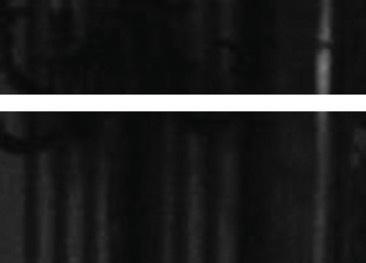





“One of the premier American sopranos of her generation” — Los Angeles Times HARRIS THEATER PRESENTS 22/23 MUSIC 312.334.7777 | harristheaterchicago.org | 205 East Randolph Street PATRICIA SINGS PIAF PATRICIA RACETTE December 8, 2022 / 7:30PM The Irving Harris Foundation, Joan W. Harris HTP Mainstage Sponsor Corporate Presenting Sponsor














































 By ISA GIALLORENZO
By ISA GIALLORENZO























 Interview by MATT HARVEY
Photos by Eddie Quiñones
Interview by MATT HARVEY
Photos by Eddie Quiñones


 by BEN JORAVSKY
by Eddie Quiñones
by BEN JORAVSKY
by Eddie Quiñones












































































 Photos by Carolina Sanchez
Photos by Carolina Sanchez







 Photos by Matthew Gilson
Photos by Matthew Gilson





 Photos by Matthew Gilson
Photos by Matthew Gilson




































































































































 —JOSHUA MINSOO KIM
—JOSHUA MINSOO KIM











 —CRISTALLE BOWEN
—CRISTALLE BOWEN





































































































































